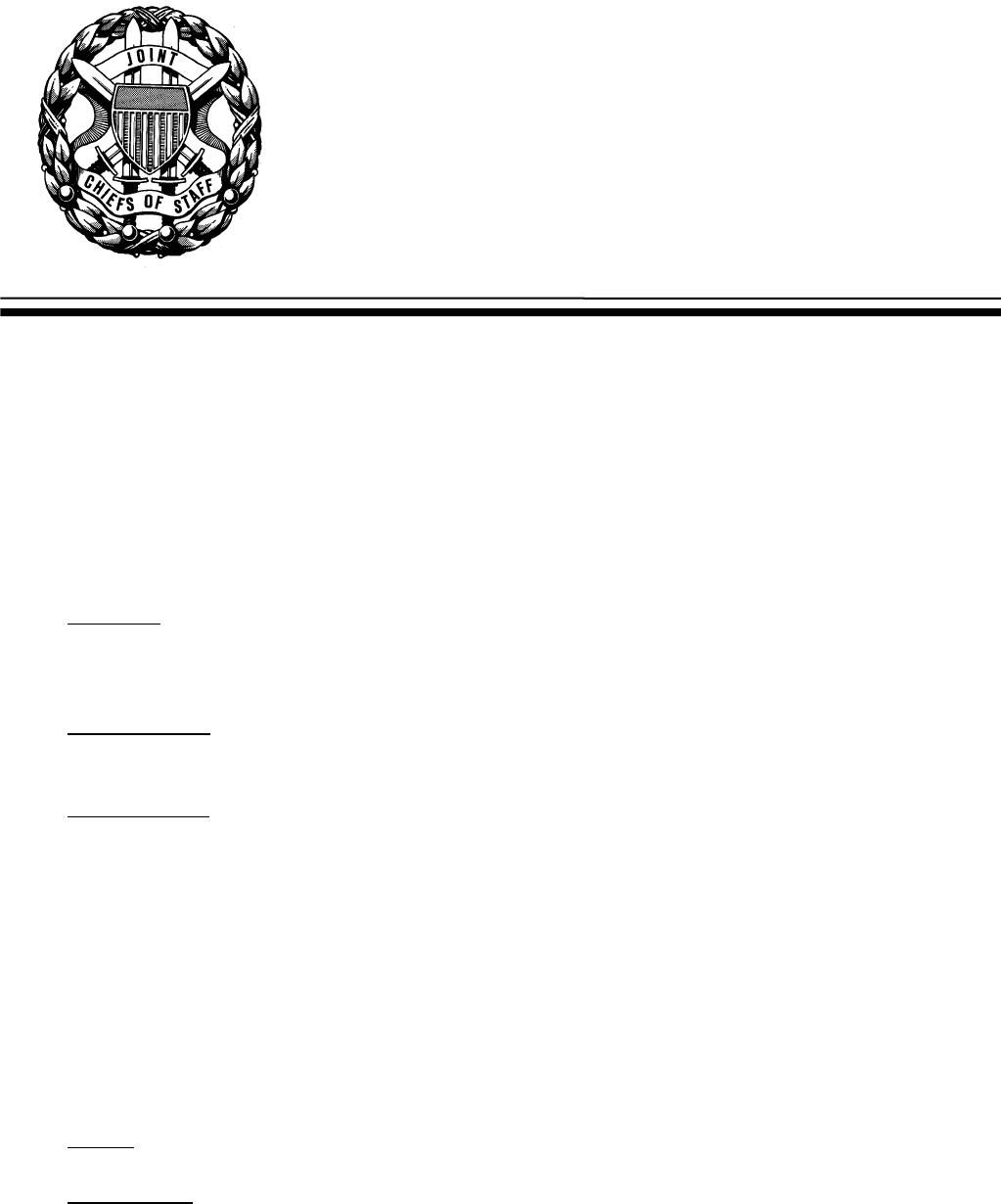
CHAIRMAN OF THE JOINT
CHIEFS OF STAFF
INSTRUCTION
J
-6 CJCSI 6510.01F
DISTRIBUTION: A, B, C, and J 9 February 2011
INFORMATION ASSURANCE (IA) AND SUPPORT TO COMPUTER NETWORK
DEFENSE (CND)
References: See Enclosure D
1. Purpose. Provide joint policy and responsibilities for IA and support to CND
in accordance with (IAW) Department of Defense Directive (DODD) 8500.01E,
“Information Assurance (IA)” (reference a).
2. Cancellation. CJCSI 6510.01E, 15 August 2007, “Information Assurance
(IA) and Computer Network Defense (CND),” (reference b) is canceled.
3. Applicability
a. This instruction applies to the Joint Staff, combatant commands,
Services, Defense agencies, DOD field activities, and joint activities (hereafter
referred to as CC/S/As).
b. Nothing in this instruction shall alter or supersede the existing
authorities and policies of the Director of National Intelligence (DNI) regarding
the protection of Sensitive Compartmented Information (SCI) and special
access programs for intelligence as directed by Executive Order 12333, “United
States Intelligence Activities” (reference c) and other laws and regulations.
4. Policy
. See Enclosure A.
5. Definitions. See Glossary. Major source documents for definitions in this
instruction are Joint Publication (JP) 1-02, “DOD Dictionary of Military and
Associated Terms,” (reference d) and Committee on National Security Systems
Instruction (CNSSI) No. 4009, “National Information Assurance Glossary”
Directive Current as of 9 Jun 2015

CJCSI 6510.01F
9 February 2011
2
(reference e).
6. Responsibilities. See Enclosures B and C.
7. Summary of Changes
a. Provides CC/S/A-level responsibilities for Vulnerability Management and
the Information Assurance Vulnerability Management (IAVM) program.
b. Provides guidance and responsibilities for foreign national access to
unclassified and classified information systems (ISs).
c. Provides guidance and responsibilities for the Cyber Security Inspection
Program and Command Cyber Readiness Inspections (CCRIs).
d. Updates guidance on use of Portable Electronic Devices (PEDs) and
removable media.
e. Updates guidance on Internet access and use of commercial e-mail.
f. Updates guidance on sanitization, declassification, and release of IS
storage media.
g. Updates guidance on spillage of classified information.
h. Introduces the Cyber Conditions (CYBERCON) system as future
replacement for Information Operations Conditions (INFOCON) system.
i. Updates titles for Designated Accrediting Authority (DAA) to Authorizing
Official; Information Assurance Manager (IAM) to Information Systems Security
Manager (ISSM); and Information Assurance Officer (IAO) to Information
Systems Security Officer (ISSO) to align with CNSSI No. 4009 (reference e)
terms. Replaces term certification with assessment and accreditation with
authorization (to operate) in alignment with CNSSI No. 4009 (reference e)
terminology. The new terms are followed by legacy terms in parentheses
throughout instruction.
j. Removes sections on Defense Critical Infrastructure Programs and
Communications Security (COMSEC) Material Incidents, which can be found in
other DOD issuances.
8. Releasability
. This instruction is approved for public release; distribution is
unlimited. DOD components (to include the combatant commands), other
federal agencies, and the public may obtain copies of this instruction through
the Internet from the Chairman of the Joint Chiefs of Staff (CJCS) Directives
Home Page at http://www.dtic.mil/cjcs_directives.

CJCSI 6510.01F
9 February 2011
3
9. Effective Date. This instruction is effective upon receipt.
CRAIG A. FRANKLIN
Major General, USAF
Vice Director, Joint Staff
Enclosures:
A - Policy
B - Joint Staff, Combatant Command, Service, and Agency Specific
Responsibilities
C - Joint Staff, Combatant Command, Service, Defense Agency, DOD Field
Activity, and Joint Activity Collective Responsibilities
D - References
GL - Glossary
CJCSI 6510.01F
9 February 2011
4
(INTENTIONALLY BLANK)
CJCSI 6510.01F
9 February 2011
i
TABLE OF CONTENTS
Page
Cover Page ...................................................................................................... 1
Table of Contents ............................................................................................. i
ENCLOSURE A -- POLICY
DOD IA and CND Policy Documents .......................................................A-1
Authorization (Accreditation) .................................................................. A-1
Ports, Protocols, and Services (PPS) ........................................................A-1
Interconnection of Information Systems..................................................A-1
Software and Hardware ..........................................................................A-2
Portable Electronic Devices and Removable Media ..................................A-3
Information and Information System Access ........................................... A-4
Monitoring Information Systems.............................................................A-5
Warning Banners ...................................................................................A-6
Public Key Enabling (PKE) ...................................................................... A-6
Training .................................................................................................A-6
Risk Management, Vulnerability Assessment, and Mitigation..................A-6
Communications Security (COMSEC) ..................................................... A-7
ENCLOSURE B -- JOINT STAFF, COMBATANT COMMAND, SERVICE, AND
DEFENSE AGENCY SPECIFIC RESPONSIBILITIES
The Joint Staff........................................................................................B-1
Combatant Commanders........................................................................B-3
Commander, U.S. Strategic Command (CDRUSSTRATCOM) ...................B-5
Service Chiefs.......................................................................................B-11
Commandant, United States Coast Guard (USCG) ................................B-12
Director, Defense Information Systems Agency (DISA)...........................B-12
Director, Defense Intelligence Agency (DIA) ...........................................B-13
Director, National Security Agency (DIRNSA)/Chief, Central Security
Service (CSS) ....................................................................................B-14
Director, Defense Security Service (DSS)...............................................B-18
ENCLOSURE C -- JOINT STAFF, COMBATANT COMMAND, SERVICE,
DEFENSE AGENCY, DOD FIELD ACTIVITY, AND JOINT ACTIVITY
COLLECTIVE RESPONSIBILITIES
Architecture ...........................................................................................C-1
Categorization and Registration ..............................................................C-1
Security Control Assessment and Authorization to Operate
(i.e., Certification and Accreditation (C&A))..........................................C-2
Personnel Management ..........................................................................C-5
Training .................................................................................................C-5
Cyber Security Inspection Program.........................................................C-5
Information Operations Conditions (INFOCON) .....................................C-12
CJCSI 6510.01F
9 February 2011
ii
Page
Security Configuration and Vulnerability Management .........................C-13
Incident Handling Program...................................................................C-22
Individual and Organization Accountability ..........................................C-23
Network Suspensions ...........................................................................C-24
Monitoring............................................................................................C-24
Auditing ...............................................................................................C-25
Scanning Coordination .........................................................................C-25
Restoration...........................................................................................C-26
Readiness.............................................................................................C-26
Ports, Protocols, and Services Management (PPSM)...............................C-26
Connection of Information Systems ......................................................C-27
Hardware and Software ........................................................................C-29
Testing of Security Controls and Annual Security Reviews ....................C-31
Portable Electronic Devices (PEDs) and Removable Media .....................C-32
Wireless Devices, Services, and Technologies........................................C-35
Boundary Protection.............................................................................C-36
Remote Access......................................................................................C-36
Internet Access and Commercial E-Mail Use .........................................C-37
Protection of and Access to Information and Information Systems.........C-39
Foreign Access .....................................................................................C-43
Sanitization, Declassification, and Release of IS Storage Media .............C-48
Spillage of Classified Information..........................................................C-49
Cross Domain Solution (CDS) ...............................................................C-50
Manual Data Transfer Across Security Domains ...................................C-51
Information System Contingency Plans.................................................C-51
Risk Management, Vulnerability Assessment, and Mitigation................C-54
Physical Security ..................................................................................C-56
Communications Security (COMSEC) ...................................................C-56
ENCLOSURE D -- REFERENCES
References............................................................................................. D-1
GLOSSARY
Acronyms .............................................................................................GL-1
Definitions............................................................................................GL-7

CJCSI 6510.01F
9 February 2011
A-1 Enclosure A
ENCLOSURE A
POLICY
1. DOD IA and CND Policy Issuances
. DODD 8500.01E (reference a) and
DODD O-8530.1, “Computer Network Defense (CND)” (reference f) establish
DOD IA and CND policy and responsibilities. DOD Instruction (DODI) 8500.2,
“Information Assurance (IA) Implementation” (reference g) and DODI O-8530.2,
“Support to Computer Network Defense (CND)” (reference h) provide further
guidance on the selection and implementation of security requirements,
controls, protection mechanisms, and standards.
2. Authorization (Accreditation)
. DOD ISs shall be authorized to operate IAW
DODI 8510.01, “DoD Information Assurance Certification and Accreditation
Process (DIACAP)” (reference i).
3. Ports, Protocols, and Services Management (PPSM). Ports, Protocols, and
Services (PPS) intended for use in DOD ISs that traverse between DOD enclaves
and DOD and external enclaves shall undergo a vulnerability assessment; be
assigned to an assurance category; be registered; be regulated based on their
vulnerability potential to cause damage to DOD operations and interests; and
be limited to only PPS required to conduct official business IAW DODI 8551.1,
“Ports, Protocols and Services Management (PPSM)” (reference j).
4. Interconnection of Information Systems
a. Interconnection of ISs shall be managed to continuously minimize
community risk to the interconnected CC/S/As ISs and ensure that the
protection of one IS is not undermined by vulnerabilities of other
interconnected ISs. Protection procedures and devices shall be used to restrict
access to and from isolated local area network (LAN) segments (e.g., Firewalls,
cross domain solutions (CDSs), access control lists (ACLs), intrusion detection
systems (IDSs), intrusion prevention systems (IPSs), and demilitarized zones
(DMZs)).
b. Connections between DOD ISs and non-DOD ISs, including foreign-
nation, contractor and other United States (U.S.) government systems shall be
accomplished IAW CJCSI 6211.02, “Defense Information Systems Network
(DISN): Policy and Responsibilities” (reference k) and DOD Chief Information
Officer (CIO) waiver processes.
c. Top Secret (TS)/SCI interconnections shall be IAW DNI guidance.

CJCSI 6510.01F
9 February 2011
A-2 Enclosure A
d. Interconnections of Intelligence Community (IC) systems and DOD
systems shall be accomplished using a process jointly agreed on by the DOD
CIO and the Associate Director of National Intelligence (ADNI) and CIO
principal accrediting authorities.
5. Software and Hardware
a. Technical solutions for DOD ISs shall be engineered to:
(1) Implement a defense-indepth strategy for ISs and supporting
infrastructures through an incremental process of protecting critical assets or
data first. The defense-indepth strategy must establish protection and trust
across various network layers (e.g., application, presentation, session,
transport, network, data link, or physical) IAW DODD 8500.01E (reference a).
(2) Ensure network and infrastructure services provide confidentiality,
availability, integrity, authentication, and non-repudiation.
(3) Defend the perimeters of enclaves by establishing a well-defined
boundary with protection mechanisms (e.g., firewalls, CDSs, DMZs, ACLs,
IDSs, and IPSs).
(4) Provide protection to computing environments (e.g., internal hosts
and applications) by incorporating security mechanisms into existing systems,
networks, and applications; and integrating security features into the design of
new applications.
(5) Use supporting IA infrastructures (e.g., key management, public key
certificates, biometrics, and cryptographic modernization).
(6) Leverage operating systems technology to develop technical solutions
to restrict network compromise by adversaries.
(7) DOD ISs shall be designed and maintained ensuring technology
refresh IT Security Plans of Action and Milestones (POA&M) mitigations are
established for technology obsolescence and vendor support timelines and
issues.
(8) Specify deny all or permit by exception for both inbound and
outbound network traffic.
b. Defense Information Systems Agency (DISA) Security Technical
Implementation Guides (STIGs) and National Security Agency (NSA) security
configuration guides shall be implemented for applicable ISs and information

CJCSI 6510.01F
9 February 2011
A-3 Enclosure A
technology (IT) assets.
c. All IA and IA-enabled government-off-the-shelf (GOTS) and commercial-
off-the-shelf (COTS) hardware, firmware, and software components must be
acquired, evaluated, installed, and configured IAW National Security
Telecommunications and Information Systems Security Policy (NSTISSP) No.
11, “National Policy Governing the Acquisition of Information Assurance (IA)
and IA-Enabled Information Technology (IT) Products” (reference l). Acquire
documentation including initial configuration, user guides, and maintenance
manuals along with the products.
d. Public domain software products, other software products with limited or
no warranty (i.e., freeware or shareware), and Peer-to-Peer (P2P) file sharing
software shall only be used after a risk assessment has been conducted,
recommendations provided to the Senior Information Assurance Officer (SIAO),
and authorized by the CC/S/A Headquarters-level Authorizing Official (i.e.,
DAA).
e. Mobile code technologies (e.g., Java Virtual Machine, Java compiler, .NET
Common Language Runtime, Windows Scripting Host, and Hypertext Markup
Language (HTML) Application Host) shall be categorized, evaluated, and
controlled to reduce the vulnerability and risk to DOD ISs IAW DODI 8552.01,
“Use of Mobile Code Technologies in DoD Information Systems” (reference m).
6. Portable Electronic Devices (PEDs) and Removable Media
a. Government-owned PEDs (e.g., laptop computers, personal digital
assistants (PDAs), Blackberrys, and cell phones) including removable media
(e.g., diskettes, compact disks (CDs), external hard drives, flash media, and
universal serial bus (USB) “thumb drives”) shall be properly accounted for as
required, properly marked, properly transported, and secured at all times to
the highest level of classified information processed.
b. PEDs including removable media shall be secured with approved security
applications and data-at-rest solutions IAW DOD CIO memorandum,
“Encryption of Sensitive Unclassified Data at Rest on Mobile Computing
Devices and Removable Storage Media” (reference n).
c. Use of removable media to transfer data between different security
domains (e.g., unclassified to classified) will be limited to the execution of
specific mission tasks IAW DOD warning and tactical directives/orders and will
be prohibited when used simply for convenience IAW CNSSP 26, “National
Policy on Reducing the Risk of Removable Media” (reference o). Removable
media used to transfer data to or from classified ISs will be employed only to
ensure that CC/S/A mission tasks are not precluded or significantly impacted

CJCSI 6510.01F
9 February 2011
A-4 Enclosure A
(e.g., task failure, disruption, or degradation).
7. Information and Information System Access. Access to DOD ISs is a
revocable privilege and shall be granted to individuals based on need-to-know
and IAW DODI 8500.2 (reference g), NSTISSP No. 200, “National Policy on
Controlled Access Protection” (reference p), Status of Forces Agreements for
host national access, and DOD 5200.2-R, “Personnel Security System”
(reference q).
a. Web Sites
(1) Access to DOD-owned, -operated, or -outsourced Web sites
containing controlled unclassified information (CUI)
1
shall be strictly controlled
by the Web site owner using technical, operational, and procedural measures
IAW Assistant Secretary of Defense for Networks and Information Integration
(ASD(NII)) memorandum, “Web Site Administration, Policies and Procedures”
(reference r). This includes providing access for Web sites set up in support of
human assistance and disaster assistance and other operations requiring
interaction with mission partners.
2
(2) Public access to DOD-owned, -operated, or -outsourced Web sites
and Web portals shall be limited to those containing only unclassified
information approved for public release. Unclassified DOD information shall be
reviewed and approved for release prior to being posted IAW DODD 5230.09,
“Clearance of DoD Information for Public Release” (reference s) and DODI
5230.29, “Security and Policy Review of DoD Information for Public Release”
(reference t).
b. Individual foreign nationals may be granted access to specific classified
U.S. networks and systems as specifically authorized under Information
Sharing guidance outlined in changes to National Disclosure Policy (NDP-1)
(reference u).
(1) Classified ISs shall be sanitized or configured to guarantee that
foreign nationals have access only to classified information that has been
authorized for disclosure to the foreign national’s government or coalition, and
is necessary to fulfill the terms of their assignments.
1
CUI replaces the term “sensitive but unclassified” (SBU).
2
Those with whom the DOD cooperates to achieve national goals, such as other departments
and agencies of the U.S. Government; state and local governments; allies, coalition members,
host nations and other nations; multinational organizations; nongovernmental organizations;
and the private sector.

CJCSI 6510.01F
9 February 2011
A-5 Enclosure A
(2) U.S.-only classified workstations shall be under strict U.S. control at
all times.
c. Individual foreign nationals (e.g., foreign exchange officers) may be
granted access to unclassified U.S. networks and systems (e.g., Non-Secure
Internet Protocol Router Network (NIPRNET))
3
for official purposes by CC/S/As
IAW DODI 8500.2 (reference g).
d. Contractors -- including Federally Funded Research and Development
Center (FFRDC) personnel -- and foreign nationals granted e-mail privileges
DOD systems shall be clearly identified as such in their e-mail addresses IAW
DODD 8500.01E (reference a) and as further specified in Enclosure C,
paragraph 26.
e. DOD ISs shall regulate remote access and access to the Internet by
employing positive technical controls such as proxy services and screened
networks, also called DMZs, or encryption solutions, secured host systems,
and clients through systems that are isolated from all other DOD ISs through
physical means. This includes remote access for telework and management of
systems IAW DODI 1035.01, “Telework Policy” (reference v).
f. Policies for DOD information security and personnel security programs
are provided in DODI 5200.01, “DoD Information Security Program and
Protection of Sensitive Compartmented Information” (reference w), DOD
5200.1-R, “Information Security Program” (reference x), and DOD 5200.2-R
(reference q).
8. Monitoring Information Systems. DOD ISs (e.g., enclaves, applications,
outsourced IT-based process, and platform IT interconnections) shall be
monitored to detect and react to incidents, intrusions, disruption of services, or
other unauthorized activities (including insider threat) that threaten the
security of DOD operations or IT resources, including internal misuse.
a. Systems shall be monitored consistent with applicable policy and
procedures in National Telecommunications and Information Systems Security
Directive (NTISSD) No. 600, “Communication Security (COMSEC)” (reference y)
and DODI 8560.01, “Communications Security (COMSEC) Monitoring and
Information Assurance (IA) Readiness Testing” (reference z), as well as the legal
authority contained in 18 United States Code (USC) 2510, et seq. (reference aa)
and the Foreign Intelligence Surveillance Act (FISA), 50 USC 1801 et seq.
(reference bb).
b. DOD ISs shall be subjected to security penetration testing and other
forms of testing used to complement monitoring activities consistent with DODI
3
JP 1-02 (reference d).

CJCSI 6510.01F
9 February 2011
A-6 Enclosure A
8560.01 (reference z) and other applicable laws and regulations.
c. In addition to auditing at the operating system and database
management system levels, applications must include a provision to log
security-relevant events and store log data securely to prevent unauthorized
tampering or disclosure of the log data. Guidelines for these features are in the
DISA Application Security and Development STIG (reference cc).
9. Warning Banners. CC/S/As shall use DOD CIO approved consent banner
and user agreement on all DOD ISs IAW DOD CIO Memorandum, “Department
of Defense Information System Standard Consent Banner and User Agreement”
(reference dd).
10. Public Key Enabling (PKE). DOD ISs, including networks, e-mail, and Web
servers shall be enabled to use certificates issued by the DOD Public Key
Infrastructure (PKI) and DOD-approved external PKIs to support authentication
of identity, access control, information confidentiality, data integrity, and non-
repudiation IAW DODI 8520.2, “Public Key Infrastructure (PKI) and Public Key
Enabling (PKE)” (reference ee).
11. Training. DOD personnel and support contractors shall be trained to
perform the tasks associated with their responsibilities for safeguarding and
operating DOD ISs.
a. Authorized users of DOD ISs shall receive initial IA orientation as a
condition of IS access upon assignment to an organization and must complete
DOD awareness training annually thereafter to maintain access.
b. Personnel in IA positions -- Authorizing Official (i.e., DAA), ISSM (i.e.,
IAM), ISSO (i.e., IAO), Computer Network Defense Service Provider (CNDSP)
personnel, IA Security Architects and Engineers, and system administrator --
shall be trained and certified to perform their duties IAW DODD 8570.01,
“Information Assurance Training, Certification, and Workforce Management”
(reference ff) and DOD 8570.01-M, “Information Assurance Workforce
Improvement Program” (reference gg).
c. Contracts for acquisition and operation of DOD ISs or IA functional
services for DOD ISs that require privileged access by support contractor staff
(including subcontractors) shall specify IA certification and training
requirements IAW DODD 8570.01 (reference ff).
12. Risk Management, Vulnerability Assessment, and Mitigation
a. Vulnerability assessments shall be conducted for DOD ISs IAW DODI
8500.2 (reference g).

CJCSI 6510.01F
9 February 2011
A-7 Enclosure A
b. Risk management shall be integrated into the life cycle of the IS. A
schedule shall be established by IS owner or program manager (PM) to
periodically assess and mitigate mission risks/system vulnerabilities caused by
significant changes to the IT system configuration, IT processing environment,
or relevant changes required by DOD.
13. Communications Security (COMSEC)
a. Transmission of DOD information shall be protected through the
COMSEC measures and procedures IAW DODI 8523.01, “Communications
Security (COMSEC)” (reference hh) and CNSS COMSEC policy documents as
issued.
4
b. Protection of Information in Transmission or Data at Rest
(1) Classified national security information shall be protected using
NSA-approved cryptographic and key management systems offering high
protection levels and approved for protecting classified information.
(2) CUI and personally identifiable information (PII) will be protected
using cryptographic and key management systems that comply with NSTISSP
No. 11 (reference l), which require having current National Information
Assurance Partnership (NIAP) Common Criteria validation and that incorporate
National Institute of Standards and Technology (NIST) Federal Information
Processing Standard (FIPS) 140-2, “Security Requirements for Cryptographic
Modules” (reference ii) validated cryptographic modules.
(3) CUI and PII in transit and at rest must be protected IAW DODI
8500.2 (reference g) and DOD CIO Memorandum, “Encryption of Sensitive
Unclassified Data at Rest on Mobile Computing Devices and Removable Storage
Media” (reference n).
c. Voice Communications. Voice communications must be protected
consistent with the information transmitted.
(1) Transmission of DOD classified voice communications must be
protected with approved security services and/or equipment. NSTISSP No.
101, “National Policy on Securing Voice Communications” (reference jj) outlines
national policy on secure voice communications.
(2) Transmission of CUI voice communications require encryption that is
validated IAW FIPS 140-2 (reference ii).
4
These are available on the NIPRNET at http://www.cnss.gov or on the SIPRNET at
http://www.iad.nsa.smil.mil/resources/library/cnss_section/index.cfm.

CJCSI 6510.01F
9 February 2011
A-8 Enclosure A
d. All communications links of applicable
5
U.S. government-owned or
controlled space systems shall be protected from exploitation, corruption, or
denial consistent with mission requirements and the projected threat over the
life cycles of those space systems IAW Committee on National Security Systems
Policy (CNSSP) No. 12, “National Information Assurance Policy for Space
Systems Used to Support National Security Missions” (reference kk).
5
Space systems designated as a National Security System (NSS) and/or used to collect,
generate, process, store, display, transmit, or receive national security information and/or
used to collect, generate, process, store, display, transmit, or receive unclassified information
that require security controls to protect it from public release.

CJCSI 6510.01F
9 February 2011
B-1 Enclosure B
ENCLOSURE B
JOINT STAFF, COMBATANT COMMAND, SERVICE, AND DEFENSE AGENCY
SPECIFIC RESPONSIBILITIES
1. The Joint Staff. To support joint IA implementation and support to CND,
Joint Staff Directors shall ensure the following:
a. The Director for Personnel, J-1 shall ensure Electronic Joint Manpower
and Personnel System (e-JMAPS) can support identification of IA professional
workforce IAW DOD 8570.01-M (reference gg) and provide data feeds to DOD
manpower databases (e.g., Defense Civilian Personnel Data System (DCPDS)).
b. The Director for Operations, J-3 shall:
(1) Execute primary Joint Staff responsibility for CND operational
planning in coordination with Commander, U.S. Strategic Command
(CDRUSSTRATCOM).
(2) Coordinate with the Director, J-6 and CDRUSSTRATCOM for
technical analysis of network operations’ courses of action.
(3) Provide guidance in coordination with Director, J-6 and
CDRUSSTRATCOM to ensure network operations and CND portions of joint
plans and operations are prepared, reviewed, and conform to policy guidance
from the President and the Secretary of Defense.
(4) Review and approve CND portions of plans and strategic concepts of
the Combatant Commanders and determine their adequacy, consistency,
acceptability, and feasibility for performing assigned missions IAW Chairman of
the Joint Chiefs of Staff Manual (CJCSM) 3122.01A, “Joint Operation Planning
and Execution System (JOPES), Volume I, Planning Policies and Procedures”
(reference ll) and in coordination with Director, J-6 and CDRUSSTRATCOM.
c. The Director for Strategic Plans and Policy, J-5 shall:
(1) Provide guidance and recommendations on politico-military matters
and joint policy related to cyberspace in coordination with Director, J-3 and
Director, J-6.
(2) Ensure IA is incorporated in preparation of joint strategic plans.
CJCSI 6510.01F
9 February 2011
B-2 Enclosure B
d. The Director for Command, Control, Communications, and Computer
Systems, J-6 shall:
(1) Execute primary Joint Staff responsibility for IA related to network
operations, programs, and capabilities in coordination with Director, J-3 and
CDRUSSTRATCOM.
(2) Provide Director, J-3 technical analysis of proposed network
operations courses of action.
(3) Develop and publish joint IA policy, guidance, and procedures in
coordination with the Director, J-3; Director, J-5; and CDRUSSTRATCOM.
(4) Develop IA doctrinal concepts for integration into cyberspace
operations doctrine in coordination with Director, J-3, Director, J-7, and
CDRUSSTRATCOM. Ensure this doctrinal effort addresses a process that
integrates the various IA disciplines and capabilities associated with protecting
information and ISs with cyberspace operations.
(5) Function as the Joint Staff Warfighting Mission Area (WMA) Principle
Accrediting Authority (PAA) representative on the Defense Information Systems
Network (DISN)/Global Information Grid (GIG) Flag Panel.
(6) Represent the Joint Staff on the Defense IA/Security Accreditation
Working Group (DSAWG). The DSAWG is tasked to ensure that required
security policies, guidance, and standards are implemented to mitigate risk to
the DOD information enterprise.
(7) Ensure IA is integrated into contingency and crisis planning in a
manner consistent with joint policy and doctrine including risk mitigation and
recovery in a compromised information environment.
(8) Ensure IA compliance element of the Joint Interoperability and
Supportability certification process IAW CJCSI 6212.01, “Interoperability and
Supportability of Information Systems” (reference mm) and that IA is integrated
into all phases of the acquisition process IAW DODD 5000.01, “The Defense
Acquisition System” (reference nn); DODI 5000.02, “Operation of the Defense
Acquisition System” (reference oo); and DODI 8580.1, “Information Assurance
(IA) in the Defense Acquisition System” (reference pp).
e. The Director for Joint Force Development, J-7 shall ensure IA is
exercised to include realistic scenarios that result in serious degradation and
mission impact in CJCS-coordinated and directed exercises and command
exercises.

CJCSI 6510.01F
9 February 2011
B-3 Enclosure B
f. The Director for Force Structure, Resources, and Assessment, J-8 shall:
(1) Ensure Combatant Commanders incorporate IA elements in the
generation of requirements for systems and applications support to joint and
combined operations. See CJCSI 6212.01 (reference mm).
(2) Validate IA requirements through the Joint Requirements Oversight
Council (JROC) IAW CJCSI 3137.01, “The Functional Capabilities Board”
(reference qq) and CJCSI 3170.01, “Joint Capabilities Integration and
Development Process” (reference rr).
g. The Joint Staff CIO shall implement responsibilities in Enclosure C for
Joint Staff networks.
2. Combatant Commanders. In addition to responsibilities in Enclosure C,
Combatant Commanders shall:
a. Plan, coordinate, and direct theater network operations and defense for
their respective area of responsibility (AOR) and functions.
b. Incorporate IA procedures, processes, and requirements into command
policy and guidance for combatant command components.
c. Develop and enforce a process within the combatant command and Joint
Task Force (JTF) staffs to effectively integrate IA into ISs.
d. Manage a vulnerability management program (e.g., monitoring threats
and verifying compliance) for ISs under their operational or administrative
control.
(1) Ensure compliance with USSTRATCOM warning and tactical
directives/orders to protect and defend DOD information networks.
(2) Direct corrective actions for affected ISs not in compliance with
USSTRATCOM warning and tactical directives/orders.
(3) Assess risk and potential operational impact associated with
hardware and software vulnerabilities for ISs under their operational or
administrative control to include operational risks of loss/denial of the IS in a
contested environment.
e. Establish a Tier 2 or 3 CND services capability IAW DODI O-8530.2
(reference h). If a Tier 2 CND services capability is not established, obtain Tier
2 support from DISA or other USSTRATCOM accredited Tier 2 CNDSP to
CJCSI 6510.01F
9 February 2011
B-4 Enclosure B
coordinate and direct protective measures and implement DOD-wide
operational and defensive direction from USSTRATCOM.
f. Direct tasks and requests for information through their subordinate
Service component Tier 2 CNDSP. Memorandum of agreements (MOAs) will be
developed with CNDSPs to prevent duplication of efforts and tasks at the base,
camp, or post-station level.
g. Integrate IA procedures, processes, and capabilities into operations plans
(OPLANs), functional plans, and concept plans (CONPLANs) including
provisions to mitigate risk in event of compromise or denial of service (DoS).
h. Exercise combatant command procedures, processes, and capabilities in
joint exercises and war games in realistic scenarios to include compromise or
DoS, and integrate changes to fix deficiencies based on lessons learned and
after-action reports (AARs).
(1) Develop, plan, and coordinate integration of network defense
objectives into an annual joint exercise in coordination with Joint Staff and
USSTRATCOM.
(2) Support DOD network operations exercises and experiments.
i. Validate requests for IS interoperability and required security services
using OPLANs and CONPLANs and forward the request to release protection
technologies to the designated releasing authority.
j. Develop, coordinate, and direct specific network defense courses of action
(including Computer Network Defense Response Actions (CND-RAs)) in support
of assigned networks. CND-RAs will not be delegated.
k. Conduct IA monitoring operations of ISs (e.g., enclaves) subject to the
provisions of law, executive orders, applicable presidential directives, and DODI
8560.01 (reference z), including:
(1) Implement procedures for conducting COMSEC and IS monitoring
consistent with the policy and procedures in NTISSD No. 600 (reference y) and
DODI 8560.01 (reference z), as well as the legal authority contained in 18 USC
2510, et seq. (reference aa) and FISA, 50 USC 1801, et seq. (reference bb).
(2) Establish procedures for notifying IS users of the requirements
necessary to support COMSEC and IS monitoring (e.g., periodic training,
consent warning banners, and notices).

CJCSI 6510.01F
9 February 2011
B-5 Enclosure B
l. Identify military and government civilian IA workforce positions in the e-
JMAPS.
m. Conduct network defense crisis action and contingency planning in
coordination with United States Cyber Command (USCYBERCOM).
3. Commander, U.S. Strategic Command (CDRUSSTRATCOM)
. In addition to
responsibilities in paragraph 2 and Enclosure C, CDRUSSTRATCOM shall:
a. Plan, coordinate, and direct DOD global network operations and defense
IAW Unified Command Plan (UCP) (reference ss).
(1) Conduct cyber defense crisis action and contingency planning to
direct specific network defense courses of action in support of DOD network
operations to include synchronizing other Combatant Commanders’ regional
network defense plans for global defense.
(2) Execute operational authority to direct global changes in INFOCON
levels and procedures.
b. Delineate USCYBERCOM IA roles and responsibilities to plan,
coordinate, and direct DOD global network operations and defense.
c. Establish a Tier 1 CND capability to provide support to CC/S/A Tier 2
and Tier 3 CND organizations.
d. Provide timely, relevant situational awareness of potential threats,
attacks, network status, and other critical information to support decision
making for defense of DOD information networks including tailoring to support
CC/S/A missions and operations.
e. Manage DOD network defense (e.g., monitoring threats and verifying
compliance), including monitoring and enforcing compliance with
USSTRATCOM warning and tactical directives/orders.
(1) Issue guidance and procedures for implementation of USSTRATCOM
warning and tactical directives/orders to include developing, coordinating,
disseminating, reporting compliance, and validating USSTRATCOM-directed
actions to protect and defend DOD information networks.
(2) Maintain overall responsibility for IAVM program execution.
(3) Report significant compliance issues concerning DOD organizations
or incidents to the CJCS.

CJCSI 6510.01F
9 February 2011
B-6 Enclosure B
(4) Direct corrective actions for enclaves or affected ISs not in
compliance with USSTRATCOM warning and tactical directives/orders.
(5) Maintain a list of enterprise automated vulnerability management
tools approved for use by CC/S/As.
f. Manage the incident handling program IAW CJCSM 6510.01A,
“Information Assurance (IA) and Computer Network Defense (CND) Volume I
(Incident Handling Program)” (reference ss).
g. Direct corrective actions (which may ultimately include disconnection) of
any CC/S/A enclave(s) or the affected system(s) on the enclave not in
compliance with USSTRATCOM warning and tactical directives/orders.
6
USSTRATCOM shall coordinate with CC/S/As to determine threat assessment
and operational impact to DOD, subordinate components and alternate means
of communication before instituting disconnection.
h. Establish procedures to provide network operations measures of
effectiveness and operational risk/impact assessment for DOD information
networks.
i. Coordinate with and support as directed the National Cyber-Response
Coordination Group (NCRCG) and U.S.-Computer Emergency Response Team
(US-CERT).
j. Oversee DOD Cyber Security Inspection Program to maintain and
determine compliance with security policy, procedures, and practices.
(1) Develop and publish Cyber Security Inspection Program performance
standards, criteria, methodology (e.g., procedures and practices), and tools to
be employed in coordination with CC/S/As and reviews of current Joint and
CC/S/A procedures, practices (e.g., Joint Common Information Assurance
Methodology (reference uu),
7
and tools.
(2) Maintain annual schedule of CCRIs, Red Team Operations, and Blue
Team Evaluations conducted by CC/S/As through review and coordination of
annual CC/S/A schedules.
(3) Oversee CCRIs of DOD ISs and networks to assess cyber readiness to
accomplish DOD missions. This includes CC/S/A owned or operated ISs and
6
Current USSTRATCOM warning and tactical directives/orders include Fragmentary Order
(FRAGO), Communications Tasking Orders (CTOs), IA Vulnerability Notices, Network Defense
Tasking Message (NDTM), DOD GIG Tasking Message (DGTM), and Operations Order (OPORD).
7
Document can be found at:
https://www.intelink.gov/inteldocs/view.php?fDocumentId=53466.
CJCSI 6510.01F
9 February 2011
B-7 Enclosure B
those operated on behalf of a CC/S/A (e.g., contractor or another federal
agency).
(a) Conduct CCRIs to determine the readiness of CC/S/A ISs and
networks to accomplish assigned missions.
(b) Coordinate with the DOD Inspector General (IG) to address cyber
security issues IAW DODD 5106.04, “Combatant Command Inspectors
General” (reference vv).
(c) Coordinate CCRIs with the DOD IG and Joint Staff IG to include
scheduling or when issues or situations may potentially affect other CC/S/As
IAW DODI 5106.05, “Combatant Command Inspectors General –
Implementing Procedures” (reference ww).
(d) Oversee Service and DISA Teams supporting CCRIs.
(e) Coordinate and publish annual CCRI schedule.
(f) Recommend actions to correct deficiencies identified during
inspections and monitor the progress of approved corrective actions.
(4) Maintain awareness of ongoing or projected Red Team activities
against DOD networks in coordination with NSA.
(5) Develop standard report formats for CC/S/A Red Team, Blue Team
Vulnerability Evaluation and Intrusion Assessment, and vulnerability
assessment reports.
(6) Maintain repository of Red Team, Blue Team Vulnerability
Evaluation and Intrusion Assessment, and vulnerability assessment reports
received from CC/S/As for DOD network security assessments.
(7) Ensure Red Team, Blue Team Vulnerability Evaluation and Intrusion
Assessment, and vulnerability assessment reports provided by Services, DISA,
NSA, and other CC/S/As are incorporated into USSTRATCOM periodic
operational assessment of the readiness of CC/S/As to defend ISs IAW DODI
8500.2 (reference g).
k. Support network operations exercises.
(1) Develop, plan, and coordinate integration of network defense
objectives into an annual major joint exercise in coordination with Joint Staff
and Combatant Commanders.
CJCSI 6510.01F
9 February 2011
B-8 Enclosure B
(2) Support DOD information network operations exercises.
l. Recommend DOD and joint network defense standards/requirements.
(1) Advocate and provide recommendations to the Joint Staff on joint
network defense policy guidance, doctrine, capability requirements, intelligence
production requirements, and education and training standards.
(2) Provide recommendations for network operations training.
(3) Identify network operations desired characteristics and capabilities.
(4) Lead development of network operations joint tactics, techniques,
and procedures (TTP), as required.
m. Establish a DOD NetOps community of interest (COI) providing a forum
for discussion and recommendations on strategic level NetOps issues, to
include vetting of standardized terminology, information exchange standards,
and programmatic implementations.
n. Chair the DOD Enterprise-Wide IA/CND Solutions Steering Group
(ESSG), which provides implementation oversight, leadership, and advocacy for
enterprise-wide IA and CND solutions responsibility. The ESSG is chartered to
improve DOD CND by directly involving CC/S/As in CND oversight, planning,
and advocacy.
o. Chair the Space System IA Steering Group, which provides leadership
and oversight for implementation of IA policies contained within DODI 8581.01,
“Information Assurance (IA) Implementation for Space Systems Used by the
Department of Defense” (reference xx).
p. Serve as the Accrediting Authority for general service (GENSER) network
and system CNDSPs and DOD Red Teams IAW DODI O-8530.2 (reference h).
q. Coordinate with foreign governments and international organizations on
network operations.
(1) All coordination and agreements shall be IAW CJCSI 2300.01,
“International Agreements” (reference yy) and CJCSI 5130.01, “Relationships
Between Commanders of Combatant Commands and International Commands
and Organizations” (reference zz).
(2) Disclosure of classified information shall be IAW CJCSI 5221.01,
“Delegation of Authority to Commanders of Combatant Commands to Disclose

CJCSI 6510.01F
9 February 2011
B-9 Enclosure B
Classified Military Information to Foreign Governments and International
Organizations” (reference aaa).
(3) Coordinate with Under Secretary of Defense for Policy (USD(P)) IAW
DODD 5530.3, “International Agreements” (reference bbb).
(4) Advise geographic combatant commands before negotiation of any
international negotiations and furnish them with a copy of each agreement
upon its conclusion IAW DODD 5530.3 (reference bbb).
r. Designate USSTRATCOM Component(s) to:
(1) Monitor security sources for vulnerability announcements, patch and
non-patch remediation actions, and emerging threats that correspond to the
hardware and software within DOD.
(2) Assess risk and potential operational impact associated with
hardware and software vulnerabilities and develop USSTRATCOM warning and
tactical directives/orders (e.g., Fragmentary Order (FRAGO), IAVM notifications
(i.e., Information Assurance Vulnerability Alert (IAVA) or Information Assurance
Vulnerability Bulletin (IAVB)), Communications Tasking Order (CTO), Network
Defense Tasking Message (NDTM) or DOD GIG Tasking Message (DGTM). Note:
The DTGM replaces the Operational Directive Message (ODM).
(3) Prioritize the order in which the DOD addresses remediation of
vulnerabilities.
(4) Coordinate potential operations orders (OPORDs) and warning and
tactical directives/orders (e.g., FRAGO, IAVM notifications and CTO) with
CC/S/As.
(5) Publish OPORDs and warning and tactical directives/orders.
8
(6) Develop common standards for warning and tactical directive/order
reporting.
(7) Maintain and publish quarterly a DOD Compliance Watch List.
(a) Identify and publish clear criteria for CC/S/A organization
placement on the DOD Compliance Watch List.
8
USSTRATCOM warning and tactical orders/directives will be issued to CC/S/As including
CNDSPs.
CJCSI 6510.01F
9 February 2011
B-10 Enclosure B
(b) Summarize compliance status, operational impact(s), and ongoing
corrective action(s).
(8) Maintain a database of USSTRATCOM warning and tactical
directives/orders.
(9) Plan, coordinate, synchronize, and conduct incident response
activities that affect multiple CC/S/As and other federal agencies.
(a) Maintain and manage the joint incidents database for all
reportable events and incidents in the DOD.
(b) Establish and manage intrusion sets for the DOD.
(10) Maintain and manage the Joint Malware Catalog, which is the
central repository for storing malware and associated analysis.
(11) Maintain, manage, and deconflict annual external security
inspection, Blue Team Vulnerability Evaluation and Intrusion Assessment, and
vulnerability assessment visit schedules (e.g., USSTRATCOM, Services, DISA,
Defense Threat Reduction Agency (DTRA), Operational Test and Evaluation
Directorate (DOT&E), Defense Security Service (DSS), and NSA).
(12) Coordinate with DISA to develop and release DOD STIGs and
automated toolkits that establish remediation actions applicable to DOD
information enterprise and its components.
(13) Monitor CC/S/A compliance status.
(a) Conduct random and directed verification of CC/S/A compliance
status with USSTRATCOM-directed warning and tactical directives/orders.
(b) Monitor CC/S/A compliance, corrective actions, and IT Security
POA&M status.
(c) Direct or coordinate additional actions to mitigate risk for
noncompliant ISs and devices, including blocking or disconnecting ISs and
devices, using alternate means of communications if threat assessment
indicates potential operational impact to DOD and subordinate components.
(d) Notify the CC/S/As of noncompliance.
(e) Notify the Intelligence Community -- Information Assurance
Protection Center, Defense Intelligence Agency (DIA) -- when ISs and networks

CJCSI 6510.01F
9 February 2011
B-11 Enclosure B
that handle SCI are reported non-compliant with directed security
requirements.
4. Service Chiefs. In addition to responsibilities IAW Enclosure C, the Service
Chiefs under the authority of the Service Secretaries shall:
a. Organize, man, equip, and train forces to protect component information
and ISs.
b. Establish and obtain USSTRATCOM accreditation for a Tier 2 CNDSP
and direct IA and CND protective measures and implement DOD-wide
defensive actions for Service and combatant command supported networks.
c. Provide CCRI support with IA trained and certified personnel to conduct
compliance inspections of Service organizations as requested by
USSTRATCOM.
d. Ensure Service component commands provide situational awareness
through network operations channels to a Combatant Commander of events
occurring within Service component commands affecting a combatant
command area of responsibility.
e. Exercise Service procedures, processes, and capabilities in realistic
scenarios to include compromise or DoS, and integrate changes to fix
deficiencies based on lessons learned and AARs.
f. Conduct Service-level risk analysis of the Service portion of DOD
information enterprise/networks to assist in assessing the vulnerabilities of ISs
and maintain procedures and capabilities to mitigate assessed vulnerabilities
and potential threat effects.
g. Conduct IS monitoring operations.
(1) Monitor systems consistent with applicable policy and procedures in
NTISSD No. 600 (reference y) and DODI 8560.01 (reference z), as well as the
legal authority contained in 18 USC 2510, et seq. (reference aa) and FISA, 50
USC 1801, et seq. (reference bb).
(2) Establish procedures for notifying personnel and contractors of the
requirements necessary to support IS monitoring (e.g., periodic training,
warning banners, and notices).
h. Ensure all military, civilian, DOD contractor, and other DOD IS users
receive education and training including initial and annual refresher training

CJCSI 6510.01F
9 February 2011
B-12 Enclosure B
IAW DOD 8570.01-M (reference gg).
i. Document military, civilian, and DOD contractor personnel training and
certification IAW DOD 8570.01-M (reference gg).
j. Provide IA support as Service Executive Agent for combatant commands
IAW DODD 5100.3, “Support of the Headquarters of Combatant and
Subordinate Joint Commands” (reference ccc).
5. Commandant, United States Coast Guard (USCG) shall carry out
USSTRATCOM warning and tactical directives/orders for ISs connected to the
DISN (e.g., Secret Internet Protocol Router Network (SIPRNET) and NIPRNET)
IAW CC/S/A responsibilities (Enclosure C).
6. Director, Defense Information Systems Agency (DISA). In addition to
responsibilities in Enclosure C, the Director, DISA shall:
a. Lead development and implementation of layered protection of the DOD-
wide elements of the DOD information enterprise.
b. Function as a technical advisor to the DOD CIO, Joint Staff,
USSTRATCOM, and the Defense-wide Information Assurance Program (DIAP)
for IA protective measures, tools, and capabilities.
c. Serve as the DOD contact for IT standards development IAW DODI
4630.05, “Interoperability and Supportability of Information Technology (IT)
and National Security Systems (NSS)” (reference ddd) and DODD 5000.01
(reference nn).
d. Establish security architecture and standards for protecting and
defending the DOD information enterprise in coordination with CC/S/As.
e. Establish the gateway router (or the installation premise router, where
applicable) as the demarcation point between the public switched network and
the DOD information network.
f. Coordinate with the Joint Staff, NSA, and DIA to maintain authorization
to operate (accreditation) of the DOD-wide elements of the defense information
infrastructure as required.
g. Provide CCRI support with IA trained and certified personnel to conduct
security inspections as requested by USSTRATCOM.
h. Support combatant command and JTF staffs to effectively integrate the
various IA protective procedures and capabilities associated with protecting

CJCSI 6510.01F
9 February 2011
B-13 Enclosure B
information and ISs.
i. Function as the certification authority for GENSER network and system
CNDSPs (e.g., SIPRNET and NIPRNET) IAW DODD O-8530.2 (reference h).
j. Establish a CND services and operations capability to coordinate and
direct IA protective measures and implement USSTRATCOM direction for
GENSER networks or systems (e.g., SIPRNET and NIPRNET).
k. Provide Tier 2 CND services on subscription basis based on an MOA or
memorandum of understanding (MOU) for any CC/S/A that does not establish
or otherwise identify another CNDSP (e.g., Network Operations and Security
Center (NOSC)) for their GENSER or sponsored information networks.
Establish advisory and alert procedures for these organizations.
l. Assist the Services in assessing the vulnerabilities of ISs and maintain
procedures and capabilities to mitigate assessed vulnerabilities and threat
effects.
m. Develop an IA education, training, and awareness program IAW DODD
8570.01 (reference ff).
(1) Develop IA education, training, and awareness program guidelines.
(2) Coordinate with other CC/S/As, as required, to develop computer-
based training and distributive courses and products for use by CC/S/As. For
information on available training products, visit DISA’s Web site at
http://iase.disa.mil/eta/index.html.
(3) Develop and maintain an automated database on available DOD IA
courses matched to skill level training certification requirements.
n. Develop and maintain DOD STIGs.
(1) Update the DOD STIGs and automated toolkit to reflect the proper
security configuration settings and other remedial tasks IAW DOD instructions
and guidance.
(2) Coordinate updated or new STIGs through the DSAWG.
7. Director, Defense Intelligence Agency (DIA). In addition to responsibilities in
Enclosure C, the Director, DIA shall:
a. Establish a CND services and operations capability to coordinate and
direct IA protective measures and implement DOD-wide CND direction for DIA

CJCSI 6510.01F
9 February 2011
B-14 Enclosure B
networks. This includes IC networks processing SCI operated and managed by
DIA on behalf of the IC (e.g., Joint Worldwide Intelligence Communications
System (JWICS)).
b. Support CND Services for Special Enclaves.
(1) Function as the certification authority for all DOD CNDSPs elements
(CC/S/As) designated by DOD CIO as a Special Enclave.
(2) Establish Tier 2 CND services based on an MOA or MOU with any
CC/S/A that does not establish or otherwise identify another CNDSP (e.g.,
NOSC) for their information networks designated by DOD CIO as a Special
Enclave.
(3) Establish advisory and alert procedures for these organizations. DIA
and CC/S/A shall maintain copy of MOA or MOU.
c. Provide threat assessments and assist in conducting DOD information
enterprise/network risk assessments for Office of the Secretary of Defense
(OSD), Joint Staff, and CC/S/As.
d. Provide intelligence on threat capabilities against DOD information, ISs,
and interconnections with foreign partners.
e. Serve as the DOD focal point for intelligence support to strategic
indications and warning (I&W) process for foreign threat to U.S. information
infrastructure and systems.
f. Serve as the Defense IC focal point for design, development, and
maintenance of databases that facilitate collection, processing, and
dissemination of all-source, finished intelligence for identifying potential foreign
threats, indications of threat activity, and dissemination of warnings of foreign
threat activities.
g. Provide intelligence analytical support to determine attribution for
reported incidents and unauthorized activities on the DOD networks, long-term
analysis to achieve predictive analysis of foreign activities against the DOD
information enterprise, and characterization of the global cyber-threat
environment.
8. Director, National Security Agency (DIRNSA)/Chief, Central Security
Services (CSS). In addition to responsibilities in Enclosure C, DIRNSA/CSS
shall:
CJCSI 6510.01F
9 February 2011
B-15 Enclosure B
a. Develop and coordinate the IA component of the DOD information
enterprise architecture as the IA domain agent.
b. Sponsor the GIG IA Initial Capability Document (ICD) (reference eee) and
GIG IA Portfolio; maintain the ICD and provide technical guidance and
assistance to CC/S/As creating capabilities development documents (CDDs)
and/or capability production documents (CPDs) based on GIG IA ICD.
c. Provide attack sensing and warning (AS&W) support (e.g., Defense-wide
and long-term trend and pattern analysis) to USSTRATCOM and other
CC/S/As. Populate databases with AS&W analysis.
d. Function as a technical advisor to the DOD CIO, Joint Staff, and
USSTRATCOM for IA protective measures, tools, and capabilities.
e. Assess the risk to information networks based on the threat to such
networks and the vulnerabilities of implemented IA technologies.
f. Serve as the DOD focal point for research and development (R&D) in
support of IA capability requirements, to include protection mechanisms,
detection and monitoring, response and recovery, and IA assessment tools and
techniques.
g. Lead the development of enterprise-level IA system engineering guidance
and provide engineering support and other technical assistance for its
implementation within DOD.
h. Serve as the DOD focal point for the NIAP.
(1) Through the NIAP, establish criteria and processes for evaluating
and validating all security-related COTS firmware and software components
(excluding cryptographic modules) that are required to protect ISs.
(2) Encourage U.S. industry to voluntarily submit IA-enabled COTS
hardware and software to NIAP evaluation processes.
i. Oversee administration of the National Security Information Systems
Incident Program (NSISIP) IAW NTISSD No. 503, “Incident Response and
Vulnerability Reporting for National Security Systems” (reference fff).
j. Conduct vulnerability analysis and counter-intrusion operations within
national security systems.
k. Conduct Red Team Operations.

CJCSI 6510.01F
9 February 2011
B-16 Enclosure B
(1) Maintain Red Team capability to emulate a potential adversary’s
attack or exploitation capabilities against DOD ISs. For NSA Red Team
support, contact NSA Client Advocate for USCYBERCOM (I91) at 410-854-
4656.
(2) Function as the certification authority for DOD Red Teams.
(3) Maintain a trusted agent network within DOD to ensure exercise,
operational evaluation, or security assessment safety and assist in
deconflicting exercise play from real-world activity.
(a) Ensure trusted agent network operates in coordination with
USSTRATCOM and other CC/S/As.
(b) Ensure trusted agents are informed of all ongoing joint Red Team
operations so they can assist in deconflicting exercise play and real-world
activity.
l. Develop and maintain security configuration guides or pamphlets to
provide security options for the most widely used IA or IA-enabled products.
m. Develop and maintain standard procedures and recommended tools to
manually transfer data between security domains with removable media.
n. Coordinate activities of the NSA/CSS Threat Operations Center (NTOC)
9
with other CC/S/As to integrate NTOC efforts in protection of National Security
Systems (NSSs).
o. Act as the centralized COMSEC acquisition authority.
(1) Certify cryptographic modules that are used to protect classified
information and approve cryptographic modules that are used to protect
unclassified information processed by or stored on the media on NSSs as
delineated by 44 USC 3542(b)(2) (reference ggg).
(2) Develop and promulgate technical criteria, standards, and guidelines
for certification of NSSs.
p. Protect telecommunications systems handling unclassified national
security-related information.
9
An overview with NTOC mission, functions, and contact information can be found at:
http://www.ntoc.nsa.smil.mil/snareddemon/main.html/.
CJCSI 6510.01F
9 February 2011
B-17 Enclosure B
(1) Provide consultation and guidance for use in determining
exploitation risk.
(2) Prescribe cryptographic equipment and techniques to be used where
a significant exploitation risk exists.
(3) Provide information on use of commercial cryptographic equipment
and techniques where a significant exploitation risk does not exist.
q. Provide protection against intercept and analysis of compromising
emissions from crypto-equipment or an IS.
(1) Employ emanations security (EMSEC) measures to deny
unauthorized individuals information derived from the intercept and analysis of
compromising emissions from crypto-equipment and ISs.
(2) Apply TEMPEST suppression techniques and protective measures to
cryptographic equipment and certify the TEMPEST acceptability of
cryptographic equipment.
(3) Operate a National TEMPEST Information Center that provides for a
continuing exchange of TEMPEST information between U.S. government
organizations.
(4) Encourage U.S. industry to voluntarily develop and offer equipment
and systems designed to satisfy U.S. government TEMPEST standards.
(5) Fund, establish, and manage a training program required for both
the technical education of TEMPEST personnel and the specific training of
Certified TEMPEST Technical Authorities (CTTA).
(6) Publish an annual assessment of the domestic and foreign TEMPEST
threat based on all-source intelligence data.
(7) Provide guidance to CC/S/As on the security classification and
control of information pertaining to compromising emanations, to include the
releasability of such information to U.S. government contractors and foreign
nations.
r. Use of Cryptosystems in High-Risk Environments.
(1) Coordinate with other U.S. government departments and agencies to
establish criteria for identifying high-risk environments for cryptosystems.

CJCSI 6510.01F
9 February 2011
B-18 Enclosure B
(2) Establish and publish criteria for selecting cryptosystems for use in
high-risk environments.
(3) Maintain oversight regarding cryptosystem selection for use in high-
risk environments.
s. Support IA and/or COMSEC monitoring activities.
(1) Advise and assist other CC/S/As in establishing their operating
procedures to implement IA and/or COMSEC monitoring activities.
(2) Conduct monitoring of government telecommunications consistent
with the applicable policy and procedures in NTISSD No. 600 (reference y) and
DODI 8560.01 (reference z), as well as the legal authority contained in 18 USC
2510, et seq. (reference aa) and FISA, 50 USC 1801, et seq. (reference bb).
9. Director, Defense Security Service (DSS). In addition to responsibilities in
Enclosure C, the Director, DSS shall administer the National Industrial
Security Program (NISP) on behalf of DOD and federal agencies that have
entered into an agreement with the Secretary of Defense for rendering
industrial security services.

CJCSI 6510.01F
9 February 2011
C-1 Enclosure C
ENCLOSURE C
JOINT STAFF, COMBATANT COMMAND, SERVICE, DEFENSE AGENCY, DOD
FIELD ACTIVITY, AND JOINT ACTIVITY COLLECTIVE RESPONSIBILITIES
1. Architecture
. CC/S/As shall:
a. Plan, budget, and execute resources in support of IA consistent with the
DOD IA architecture IAW DODI 8500.2 (reference g).
b. Identify and include IA requirements in the design, acquisition,
installation, operation, upgrade, or replacement of system technologies and
supporting infrastructures including sustaining base, tactical, and command,
control, communications, computers, and intelligence (C4I) interfaces to
weapon systems.
c. Ensure program managed systems (e.g., centrally managed applications)
implement and are compliant with DOD IA program and USSTRATCOM
warning and tactical directives/orders (e.g., IAVM program, incident handling
program, and other responsibilities outlined in this instruction).
10
2. Categorization and Registration. CC/S/As shall:
a. Establish and maintain a complete asset inventory of CC/S/A
information resources IAW Office of Management and Budget (OMB) Circular
A-130, “Management of Federal Information Resources” (reference hhh) and
DODD 8500.01E (reference a).
b. Register ISs within the DOD IT Portfolio Repository (DITPR).
c. Categorize ISs IAW DODD 8500.01E (reference a) in one of four
categories (i.e., enclaves (which include networks), automated IS applications,
outsourced IT-based processes, or platform IT interconnections).
d. Designate IS mission criticality and mission assurance categories.
e. Determine whether an IS should be registered as an NSS. NIST Special
Publication (SP) 800-59, “Guidelines for Identifying an Information System as a
National Security System” (reference iii) provides guidelines to identify an IS as
an NSS.
10
Program managers for a centrally managed program will be contacted concerning
noncompliance with DOD security requirements. If problems continue, contact the program’s
CC/S/A.

CJCSI 6510.01F
9 February 2011
C-2 Enclosure C
3. Security Control Assessment and Authorization to Operate (i.e., Certification
and Accreditation (C&A)). CC/S/As shall:
a. Designate an Authorizing Official (i.e., DAA) for an IS during formation of
DOD Information Assurance Certification and Accreditation Process (DIACAP)
team IAW DODI 8510.01 (reference i). Note: An Authorizing Official (i.e., DAA)
will be a U.S. citizen and an employee of the USG, will have the authority to
formally assume responsibility for operating an IS at an acceptable level of risk,
and will hold a security clearance commensurate with the classification level of
systems under their jurisdiction.
(1) For an IS funded, developed, and operated primarily by one CC/S/A
the Authorizing Official (i.e., DAA) shall be appointed by that CC/S/A.
(2) For an Enterprise IS or IS funded, developed, and operated by more
than one CC/S/A, one Authorizing Official (i.e., DAA) will be appointed. The
CC/S/A(s) designated as the executive agent for the IS material solution shall
either:
(a) Appoint the Authorizing Official (i.e., DAA) upon agreement of the
CC/S/A SIAOs, Program Manager, and User Representatives involved in the
funding, development, and operation of the IS.
1. Roles and responsibilities for involved parties should be
outlined and agreed on in signed documentation.
2. The Authorizing Official (i.e., DAA) should preferably be from an
outside user organization that will be responsible for operating the IS.
(b) Request through their DSAWG representative the appointment of
an Authorizing Official (i.e., DAA) by the Mission Area (MA) PAAs IAW DODI
8510.01 (reference i) if the CC/S/As cannot agree on an Authorizing Official for
the IS (i.e., DAA).
1. The requesting DSAWG representative will provide Authorizing
Official (i.e., DAA) recommendations and work with the MA PAA DSAWG
representative(s) to identify points of contact (POCs) and initiate Authorizing
Official (i.e., DAA) appointment coordination and staffing process.
2. If an IS is under the purview of multiple MA PAAs, the primary
MA PAA will be responsible for staffing and appointing the Authorizing Official
(i.e., DAA).
(3) Provide funding to the appointed Authorizing Official (i.e., DAA) to
carry out Authorizing Official (i.e., DAA) functions and responsibilities.

CJCSI 6510.01F
9 February 2011
C-3 Enclosure C
b. Authorize the operation of ISs IAW DODI 8510.01 (reference i) and
consistent with ISs defined in DODD 8500.01E (reference a).
c. Establish or enter into an agreement with a USSTRATCOM accredited
CNDSP to provide CND service capabilities for CC/S/A ISs.
(1) Implement CND service capabilities to continuously protect, monitor,
detect, analyze, and respond to unauthorized activity within CC/S/A ISs and
networks IAW DODI O-8530.2 (reference h). These capabilities will be available
during IS periods of operations (i.e., 24 hours/7 days a week).
(2) All DOD ISs and non-DOD ISs operating on or connected to DOD
information networks shall be supported by an accredited CNDSP IAW DODI
O-8530.2 (reference h). ISs shall not be authorized to operate without
accredited supporting CNDSP.
d. Select security controls IAW DODI 8500.2 (reference g). Note: The next
update to DODI 8500.2 (reference g) and DODI 8510.01 (reference i) will direct
DOD IS categorization and security control selection IAW CNSSI No. 1253,
“Security Categorization and Control Selection for National Security Systems”
(reference jjj) with additional specific guidance on the DIACAP Knowledge
Service. DODI 8500.2 (reference g) and DODI 8510.01 (reference i) will also
direct the use of security controls in NIST SP 800-53, “Recommended Security
Controls for Federal Information Systems and Organizations” (reference kkk)
with supporting validation procedures in NIST SP 800-53A, “Guide for
Assessing the Security Controls in Federal Information Systems and
Organizations” (reference lll), and additional DOD guidance published in the
DIACAP Knowledge Service.
e. Reuse of Security Control Assessment (Certification) Work for IS
Reciprocity
(1) Provide IS security control assessment and authorization (i.e., C&A)
documentation (as required by DOD, federal or IC processes) for deploying IS to
receiving CC/S/As IAW DOD memorandum, “DoD Information System
Certification and Accreditation Reciprocity” (reference mmm). For DOD
contractor classified ISs DOD 5220.22-M, “National Industrial Security
Program Operating Manual” (reference nnn) documentation shall be provided to
receiving CC/S/As.
(2) Accept IS security control assessment and authorization (i.e., C&A)
documentation from deploying CC/S/A IAW with DOD memorandum, “DoD
Information System Certification and Accreditation Reciprocity” (reference
mmm) to review assessment (i.e., certification) documentation for reuse in
order to authorize operation of an IS.

CJCSI 6510.01F
9 February 2011
C-4 Enclosure C
(3) Resolve security issues IAW DOD memorandum, “DoD Information
System Certification and Accreditation Reciprocity” (reference mmm).
(4) Accept security and authorization (i.e., C&A) documentation
developed IAW Intelligence Community Directive (ICD) 503, “Intelligence
Community Information Technology Systems Security Risk Management,
Certification and Accreditation” (reference ooo) or DODI 8510.01 (reference i)
without the need to expend manpower and resources on reformatting the
security authorization documentation packages into alternate forms, including
security requirements (security control decisions) reciprocally IAW DOD CIO
and IC CIO Agreement, “Agreement Between the Department of Defense Chief
Information Officer and the Intelligence Community Chief Information Officer”
(reference ppp).
f. Platform IT without platform interconnections requires security
categorization of the Platform IT, security control selection and implementation,
security control assessment, authorization to operate, and security control
monitoring.
(1) Platform IT is still required to select and implement an Authorizing
Official (i.e., DAA)-approved subset of IA security controls required to protect
the Platform IT’s resources and information. Select security controls IAW DODI
8500.2 (reference g). Note: The next update to DODI 8500.2 (reference g) and
DODI 8510.01 (reference i) will direct the use of the security controls in NIST
SP 800-53 (reference kkk).
(2) The interconnection between Platform IT and external DISN or stand-
alone networks (i.e., communications interfaces for data exchanges with
NIPRNET or SIPRNET ISs for mission planning or execution, remote
administration, and remote upgrade or reconfiguration) require security control
assessment and authorization (i.e., C&A).
g. Information Technology Development, Forensics and Reverse Engineering
Laboratories. Laboratory IT resources used for software and hardware
development, forensics, and reverse engineering that do not process, store,
share, and/or transmit real-world operational data and are isolated from
operational ISs require Authorizing Official (i.e., DAA)-approved security control
selection, assessment, and implementation to operate.
(1) Ensure that technical and non-technical controls are employed to
protect the laboratory IT resources, developmental IS(s), and information.
(2) Ensure laboratory IS(s) operate on an isolated LAN segment that does
not support operational systems.

CJCSI 6510.01F
9 February 2011
C-5 Enclosure C
(3) Configure laboratory ISs IAW the test and development requirements
section of the enclave STIG.
(4) Employ a CDS if different classification levels are used in lab to
restrict access to and from these isolated LAN segments.
(5) Ensure ISs undergoing test and development for operational
deployment are IAW DODI 8510.01 (reference i).
4. Personnel Management. CC/S/As shall:
a. Appoint an SIAO responsible for directing CC/S/A IA program on behalf
of the CIO.
b. Appoint Authorizing Officials (i.e., DAAs) to perform functions outlined in
DOD 8570.01-M (reference gg) including accreditation and management of IS(s)
under their jurisdiction IAW DODI 8510.01 (reference i).
c. Ensure IA workforce personnel are designated by category and level IAW
DOD 8570.01-M (reference gg).
d. Identify positions required to execute IA functions. Enter required
information on personnel assigned to those positions into CC/S/A databases
(e.g., e-JMAPS) and maintain databases as changes occur IAW DOD 8570.01-M
(reference gg).
e. Ensure personnel security is an integral part of the overall IA program.
Specific requirements for personnel assigned to privileged user roles with IA
management access can be found in DODI 8500.2 (reference g).
5. Training. CC/S/As shall:
a. Establish a training and certification program for government IA
workforce personnel in IA management, IA technical, CNDSP and IA System
Architect and Engineer positions IAW DODD 8570.01 (reference ff) and DOD
8570.01-M (reference gg).
b. Ensure users (i.e., military, civilian, and DOD contractor personnel)
receive initial and annual refresher IA awareness training that addresses
requirements in Chapter 6, DOD 8570.01-M (reference gg).
c. Ensure completion of IA workforce and user awareness training is
recorded IAW CC/S/A guidance.
6. Cyber Security Inspections Program. CC/S/As shall:

CJCSI 6510.01F
9 February 2011
C-6 Enclosure C
a. Conduct vulnerability assessments, Blue Team Vulnerability Evaluations
and Intrusion Assessments, cyber security inspections, and Red Team
operations (employing internal or external capabilities) to provide a systemic
view of enclave and IS technical and traditional security posture.
b. Establish tiered Cyber Security Inspection Program employing
vulnerability assessments (including organization self-assessments), Blue Team
Vulnerability Evaluations and Intrusion Assessments, Red Team (penetration
testing) and cyber security inspections.
(1) Employ consistent and repeatable vulnerability assessment, Blue
Team Vulnerability Evaluation and Intrusion Assessment, and cyber security
inspection methodology to evaluate organizational and individual roles and
responsibilities.
(2) Prioritize which ISs to inspect, evaluate, or assess based on IS
mission criticality, adversary techniques and tactics, and identified
vulnerabilities.
(3) Develop cyber security inspection, Blue Team Vulnerability
Evaluation and Intrusion Assessment, and vulnerability assessment schedule
based on CC/S/A priorities and resources.
(4) Develop the cyber security inspection, Blue Team Vulnerability
Evaluation and Intrusion Assessment, or vulnerability assessment approach,
logistical considerations, coordination requirements, and implementation plan.
(5) Execute cyber security inspections, Blue Team Vulnerability
Evaluation and Intrusion Assessment, and vulnerability assessment using
standardized tools, techniques, and criteria.
(6) Conduct analysis and reporting to translate findings into risk
mitigation actions that will improve the organization’s security posture.
c. Classify vulnerabilities IAW appropriate security classification guides.
d. Vulnerability Assessments
(1) Conduct vulnerability assessments by external teams or encourage
sites to conduct self-assessments on at least an annual basis.
(2) Assess organizational and individual procedures and practices;
assessment and authorization (i.e., C&A) documentation; configuration
baseline and management; asset inventory; and information handling. The
primary focus is to identify and resolve deficient operational practices and

CJCSI 6510.01F
9 February 2011
C-7 Enclosure C
procedures as well as IS configuration issues.
(3) Conduct assessments, including self-assessments integrating
published USSTRATCOM CCRI standards, criteria, and tools employed for
CCRI.
e. Blue Team Vulnerability Evaluation and Intrusion Assessment
(1) Conduct operational IS vulnerability evaluations and provide
mitigation techniques to organizations that have a need for an independent
technical review of their IS security posture.
(2) Include use of published USSTRATCOM CCRI standards, criteria,
and tools employed for CCRI to support evaluation and assessments.
(3) Identify security threats, evidence of intrusions, risks and
vulnerabilities of organization ISs in cooperation with the organization.
(4) Analyze current state of personnel and IS readiness and compliance.
(5) Provide recommendations based on Blue Team findings and expertise
to evaluated organization.
f. Cyber Security Inspections
(1) Conduct internal
11
cyber security inspections to determine CC/S/A
IS readiness and compliance with security policy, procedures, and practices.
(2) Employ teams comprised of subject matter experts familiar with
implementing security controls, individual security roles, and security
requirements to determine compliance with security policy, procedures, and
practices.
(3) Use published USSTRATCOM CCRI standards, criteria, and tools
employed for CCRIs.
(4) Perform cyber security inspections during scheduled visits (e.g.,
annually) or at short notice after limited 24 hours notification and coordination
with the CC/S/A Authorizing Official (i.e., DAA) or appointed
representative/POC.
11
Examples of organizations conducting external inspections include USSTRATCOM CCRI,
DOD and CC/S/A Inspectors General, the Government Accountability Office (GAO), NSA/CSS,
DISA, DSS, and other authorized entities.

CJCSI 6510.01F
9 February 2011
C-8 Enclosure C
(5) Inspect operation of CDSs, if present, and ensure interconnections
that cross security domains are in compliance with applicable DOD and DNI
policy and procedures for controlled interfaces and CDS.
(6) Validate previous compliance cyber inspection, Blue Team
Vulnerability Evaluation and Intrusion Assessment, and vulnerability
assessment results, if available.
(7) Ensure open vulnerability findings are managed in the information
system’s IT Security POA&M.
g. Red Team Operations
(1) Determine the purpose of Red Team operations (i.e., network security
assessment or exercise support).
(2) Determine targets for Red Team (i.e., ISs and networks), safety
guidelines, and restraints or constraints on Red Team operations. Constraints
on Red Team operations should be for safety, real-world mission execution, and
operations security, not for continuity-of-exercise operations, as a primary
objective of Red Team operations is development of tactics, techniques, and
procedures to “fight through” a degraded, compromised, or denied cyber
environment.
(3) Ensure Red Team operations are planned and executed in
compliance with all applicable U.S. laws and those treaties and protocols to
which the United States is a signatory.
(4) Ensure CC/S/A staff judge advocate or legal and/or general counsel
will provide legal oversight and guidance for Red Team operations to the
requesting commander or agency director.
(5) Ensure an appropriately staffed and cognizant trusted agent network
will be employed to assist in higher planning, coordination, or evaluation of
Red Team operations. Direct supervisors and exercise coordinators will be
made aware of the overall Trusted Agent Program, their responsibilities, and
POC to ensure deconfliction of exercise play from real-world activity. Trusted
agents will not be forced to reveal specific information “entrusted” by a Red
Team such as when active operations are beginning or ending.
(6) Ensure Exercise Controllers and Red Team have authority to initiate
a “stop exercise” order if safety parameters are exceeded and pose a risk to
personnel or infrastructure or in the event of real-world operations.

CJCSI 6510.01F
9 February 2011
C-9 Enclosure C
(7) Develop appropriate procedures and safeguards to ensure Red Team
operations do not affect non-DOD ISs.
(8) Ensure authority to access non-DOD ISs is obtained either with
agreements and/or approvals requiring legal review.
h. Reporting
(1) Provide cyber security inspection, evaluation, and assessment
findings and results through existing command (e.g., commanders or directors)
and technical management channels (e.g., CIO, Authorizing Official (i.e., DAA),
ISSM (i.e., IAM), ISSO (i.e., IAO), and CNDSP).
(2) Ensure cyber security inspection, evaluation, and assessment
findings are classified and protected IAW DOD 5200.1-R (reference x).
Sanitized findings and results shall be provided when required.
(3) Update connection documentation to report when IS was last
inspected, evaluated, or assessed, including self-assessment.
i. Report Distribution
(1) When conducting cyber security inspections or Red Team operations
CC/S/As shall:
(a) Provide inspected or Red Team targeted organization out-briefing
and coordinated final report.
(b) Provide copies of final report to:
12
1. Combatant command for subordinate combatant command
organization(s) and Service component(s).
2.
Service or agency for subordinate Service or agency
organization(s).
13
3.
USSTRATCOM, DISA (for DISN-connected IS), NSA, DTRA, and
DOT&E following coordination with:
12
The CC/S/A cyber inspection organization focal point will provide reports to system
commanders, Authorizing Officials (i.e., DAAs), and CNDSPs to take action to address report
findings.
13
Service or agency headquarters are responsible for ensuring reports are coordinated with
commander of assessed subordinate command, unit, or organization.

CJCSI 6510.01F
9 February 2011
C-10 Enclosure C
a Combatant command for assessed subordinate combatant
command organization(s) and Service components.
b Service or agency for assessed subordinate Service or agency
organization(s).
4.
Report results for contractor and other non-DOD ISs to the
Authorizing Official (i.e., DAA), the sponsoring CC/S/A, USSTRATCOM, DISA
(e.g., Connection Approval Office), and DSS (for classified contractor facilities).
Sponsors will share the results with the respective contract management
organization (if applicable), and the sponsor’s supporting IA management
organization.
(2) When conducting a Blue Team Vulnerability Evaluation and
Intrusion Assessment or vulnerability assessment, organization (e.g., Service)
CC/S/As shall:
(a) Provide evaluated or assessed organization(s) out-briefing and
coordinated final report.
(b) Provide courtesy copies of Blue Team Vulnerability Evaluation and
Intrusion Assessment or vulnerability assessment final reports IAW CC/S/A
guidance to:
14
1. Combatant command for subordinate combatant command
organization(s) and Service component(s).
2. Service or agency for evaluated or assessed subordinate Service
or agency organization(s).
15
3. USSTRATCOM, DISA (for DISN-connected IS), NSA, DTRA and
DOT&E following coordination with:
a
Combatant command for assessed subordinate combatant
command organization(s) and Service components.
b Service or agency for assessed subordinate Service or agency
organization(s).
(3) When conducting Blue Team Vulnerability Evaluations and Intrusion
Assessments and vulnerability assessments at the request of an organization,
14
The CC/S/A cyber inspection organization focal point will provide reports to system
commanders, directors, Authorizing Officials (i.e., DAAs), ISSMs (i.e., IAMs), ISSOs (i.e., IAOs),
and CNDSPs to take action to address report findings.
15
Service or agency headquarters are responsible for ensuring reports are coordinated with
commander of assessed subordinate command, unit, or organization.

CJCSI 6510.01F
9 February 2011
C-11 Enclosure C
CC/S/As shall:
(a) Provide organization requesting Blue Team Vulnerability
Evaluation and Intrusion Assessment or vulnerability assessment an out-
briefing and coordinated final report on completion of evaluation or
assessment.
(b) Reports from external Blue Team Vulnerability Evaluation and
Intrusion Assessment or vulnerability assessment requested by the evaluated
or assessed organization or self-assessments must be approved for release to
other organizations by the requesting organization.
j. Security Inspection, Blue Team Vulnerability Evaluation and Intrusion
Assessment, Red Team Operations, and Vulnerability Assessment
Coordination. Coordination of Red Team Operations, cyber security inspection,
Blue Team Vulnerability Evaluation and Intrusion Assessment, and
vulnerability assessment is critical due to limited inspecting teams and
inspected organization resources. CC/S/As shall:
(1) Coordinate external cyber security inspections, Blue Team
Vulnerability Evaluation and Intrusion Assessment, and vulnerability
assessments with the CC/S/As being inspected, evaluated, or assessed. Visits
to a theater site must be coordinated with the combatant command.
(2) Provide next fiscal year (FY) annual external security inspection, Blue
Team Vulnerability Evaluation and Intrusion Assessment, Red Team
Operations, and vulnerability assessment visit schedules to USSTRATCOM by
the end of the third quarter of the current FY.
(3) Coordinate and deconflict annual cyber security inspection, Blue
Team Vulnerability Evaluation and Intrusion Assessment, and vulnerability
assessment schedules with USSTRATCOM (e.g., between USSTRATCOM, DISA,
Services, DTRA, DOT&E, DSS, and NSA/CSS) to avoid multiple redundant
security inspections, evaluations, or assessments during a 12-month period.
(4) When conducting Red Team operations (e.g., NSA or Service Red
Teams), CC/S/As shall provide situational awareness of Red Team operations
(i.e., planned) to USSTRATCOM, combatant commands, Services, and agencies
through NSA trusted agent network IAW DODI O-8530.2 (reference h).
(5) When conducting cyber security inspection, Blue Team Vulnerability
Evaluation and Intrusion Assessment or vulnerability assessment (e.g., DISA
FSO or DTRA), CC/S/As shall provide situational awareness of planned Blue
Team Vulnerability Evaluation and Intrusion Assessment or vulnerability
assessment to:

CJCSI 6510.01F
9 February 2011
C-12 Enclosure C
(a) Combatant commands for evaluations or assessments conducted
on unit(s) or organization(s) in that combatant command’s area of
responsibility.
(b) Services and agency headquarters for planned evaluations or
assessments of subordinate Service or agency organization(s).
k. Frequency of Cyber Security Inspections and Blue Team Evaluations
(1) Ensure subordinate organizations are inspected or evaluated at least
once during 36-month period or more frequently if required (e.g., recent
security incidents, changes in enclave architecture, new cross domain
requirements, or follow-up from other evaluations or inspections).
(2) CC/S/A Commanders and Directors have the authority to deny
additional cyber security inspections, evaluations, or assessments by external
organizations unapproved by the DOD CIO, CC/S/A and/or USSTRATCOM
headquarters during a 12-month period if they determine the visits would
negatively impact ongoing mission accomplishment.
7. Information Operations Conditions (INFOCON). CC/S/As shall:
a. Implement the INFOCON system IAW Strategic Command Directive (SD)
527-1, “Department of Defense (DOD) Information Operations Condition
(INFOCON) System Procedures” (reference qqq).
b. Comply with global INFOCON changes and tailored response options
(TROs) when directed by USSTRATCOM. If implementation of TROs put critical
missions at risk, notify USCYBERCOM immediately.
c. Set local, regional, and CC/S/A INFOCON levels consistent with or more
restrictive than the global INFOCON level. Whenever possible, prior to
implementation, verify with USCYBERCOM that these actions will have no
trans-regional effects.
d. Develop supplemental INFOCON procedures consistent with DOD and
joint guidance, as required.
e. Report INFOCON change declarations through their operational chain of
command to USCYBERCOM. In addition, they are responsible for reporting
status of directed INFOCON procedures and TROs.
f. Conduct thorough INFOCON training for procedure and policy changes
that result from an INFOCON and/or TRO change.

CJCSI 6510.01F
9 February 2011
C-13 Enclosure C
g. Note: The INFOCON system may be replaced by the CYBERCON system
in the near future. CYBERCON is a uniform system of progressive conditions
within which commanders and DOD component heads ensure network
availability and protection of mission critical/essential systems, and integrate
approved response options in defense of warfighter, business, and intelligence
functions in cyberspace.
8. Security Configuration and Vulnerability Management. CC/S/As shall:
a. Ensure subordinate organizations implement DOD Standard Security
Configuration.
(1) Review STIGs, NSA security configuration guides, and industry best
practices for applicability with organization hardware and software.
(2) Develop a tailored security configuration guide based on industry
best practices if a STIG or NSA security configuration guide is unavailable for
an IS.
(3) Implement required STIGs.
16
(a) Test STIG(s) on noncritical ISs, preferably in a controlled non-
operational environment.
(b) Apply STIG(s) to ISs.
(c) Validate STIG implementation.
1. Use automated benchmarks included in the Windows Operating
System Guides
17
(STIG zip files) and Security Content Automation Protocol
(SCAP) validated products.
18
2.
Use Security Readiness Review (SRR)
19
scripts as appropriate to
test products for STIG compliance.
(4) Implement Standard Security Configuration Compliance using
required STIGs and organization-accepted NSA security guides or industry best
practices.
16
http://iase.disa.mil/stigs/stig/index.html or https://www.us.army.mil/suite/page/397960
17
http://iase.disa.mil/stigs/content_pages/windows_os_security.html
18
List of NIST validated products: http://nvd.nist.gov/scapproducts.cfm
19
https://iase.disa.mil/stigs/SRR/index.html

CJCSI 6510.01F
9 February 2011
C-14 Enclosure C
(a) Implement requirements based on the system configuration
deployed to operational units.
(b) Document deviations in the IT Security POA&M.
(c) Use the most recent required STIG and organization-accepted NSA
security configuration guide or industry best practices for baselining CC/S/A
ISs.
(5) Conduct testing of required STIG, and organization accepted NSA
security configuration guide or industry best practices on IT devices that use
standardized configurations. STIG testing shall be carried out IAW service-level
agreements (SLAs) or MOA in cases where an organization is operating an IS on
behalf of another organization.
b. Automated Vulnerability Management Tools
(1) Use DOD-provided, enterprise-wide automated tools/solutions (e.g.,
Host Based Security System (HBSS)) or CC/S/A procured tools/solutions
developed IAW DOD data exchange/data sharing standards (NIST, SCAP, DOD
Metadata Directory, etc.) to ensure interoperability with DOD-provided
enterprise-wide solutions for remediation of vulnerabilities.
(2) Implement USSTRATCOM warning and tactical directives/orders
through the use of available automated tools.
(3) Conduct testing of the patches on IT devices that use standardized
configurations. Testing of IAVA or IAVB patches shall be carried out IAW
SLAs
20
or MOA in cases where an organization is operating an IS on behalf of
another organization.
(4) ISs will be designed to enforce IA controls and be configured in
compliance with applicable STIGs, NSA security configuration guides, or
baseline system with changes recorded in the IS’s security plan.
c. Warning and Tactical Directive/Order Responsibilities
21
(1) CC/S/As shall
:
20
An SLA or MOA may place the responsibility for testing on the PM or the program may pay
the hosting organization to conduct testing and patching.
21
Current USSTRATCOM warning and tactical orders include OPORDs, FRAGOs, CTOs, IA
Vulnerability Notices, NDTMs, and DGTMs.

CJCSI 6510.01F
9 February 2011
C-15 Enclosure C
(a) Implement warning and tactical directives/orders that correspond
to hardware and software within CC/S/A IT resources and assets inventory.
(b) Develop internal distribution, implementation, and reporting
procedures and processes for assigned forces and organizations.
(c) Designate a primary and secondary representative responsible for
managing CC/S/A or field activity internal vulnerability management and
IAVM program. Register POCs in the applicable USSTRATCOM directed
reporting sites (e.g., Vulnerability Management System (VMS)).
(d) Ensure USSTRATCOM warning and tactical directive/order
dissemination or availability to subordinate organizations within the CC/S/A
and personnel responsible for implementing and managing responses to IS and
device vulnerabilities.
(e) Comply with USSTRATCOM warning and tactical directives/orders
(e.g., applicable FRAGO, IA Vulnerability Notices, CTO, and DTGM). This
includes complying with, but only acknowledging receipt on IAVBs for
applicable CC/S/A ISs and devices. Note: Technical Advisories will no longer
be issued.
(f) Implement risk mitigation actions that effectively mitigate
vulnerability.
(g) Ensure IS owners initiate or update IT Security POA&M, to include
mitigation actions IAW CC/S/A activity procedures (e.g., IT Security POA&M
approval by Authorizing Official (i.e., DAA) and/or CIO).
(h) Block or disconnect IS or device if a directed task(s) cannot be
implemented or mitigated as directed by CC/S/A authority.
(i) Ensure SLAs or MOAs between organizations include requirements
for implementing USSTRATCOM warning and tactical directives/orders, where
one organization is operating an IS on behalf of another organization. For
example, an Air Force application hosted on a DISA Defense Enterprise
Computing Center (DECC).
(2) Authorizing Officials (i.e., DAAs) shall
:
(a) Ensure USSTRATCOM warning and tactical directives/orders
(e.g., FRAGOs, IAVAs, CTOs, or NDTMs) are available to the lowest level ISSMs
(i.e., IAMs), ISSOs (i.e., IAOs), and system administrators, as required.
(b) Ensure compliance with all directed actions.

CJCSI 6510.01F
9 February 2011
C-16 Enclosure C
(c) Approve and submit IAW USSTRATCOM guidance and timelines
an initial or updated IT Security POA&M for IS with mitigation actions if unable
to comply with directed action.
(d) If unable to submit the IT Security POA&M as required, the
Authorizing Official (i.e., DAA) will order the affected assets blocked or
disconnected from the network IAW CC/S/A guidance.
(e) Monitor compliance and overall status for assets under their
control and ensure compliance is reported IAW CC/S/A reporting guidance.
(f) Ensure compliance checks of their organizations to validate
mitigations and/or compliance actions are completed.
(g) Maintain positive configuration control of all information systems
and/or assets under their purview. Maintain configuration documentation
that identifies specific system and/or asset owners, ISSMs (i.e., IAMs), ISSOs
(i.e., IAOs), and system administrators.
(h) Ensure compliance actions and/or mitigation on affected assets
can be verified by both CC/S/A and authorized independent organizations IAW
CC/S/A guidance.
(3) Registered CC/S/A POCs shall:
(a) Register for access to USSTRATCOM directed reporting sites (e.g.,
VMS) as directed in paragraph (1)(c).
(b) Ensure dissemination or availability of USSTTRATCOM warning
and tactical directives/orders for personnel responsible for implementing and
managing responses to information system vulnerabilities.
(c) Enter their organization’s compliance data into USSTRATCOM
designated reporting sites.
(d) Monitor compliance, IT Security POA&Ms, and mitigation status
and update the USSTRATCOM reporting sites as directed in the warning or
tactical directive/order (e.g., FRAGO, CTO, IAVA, or NDTM).
(4) ISSMs (i.e., IAMs) and ISSOs (i.e., IAOs) shall:
(a) Advise and assist the Authorizing Official (i.e., DAA) in
implementing directed actions.
(b) Monitor USSTRATCOM warning and tactical directives/orders.

CJCSI 6510.01F
9 February 2011
C-17 Enclosure C
(c) Ensure development of IT Security POA&M for IS and monitor IT
Security POA&M, mitigation actions, and compliance timelines, as required.
(5) Program Managers of CC/S/A level or Joint Programs shall:
(a) Respond to each USSTRATCOM warning or tactical
directive/order as the system configuration manager.
(b) Establish a capability to implement actions or mitigations as
identified in USSTRATCOM warning or tactical directive/order.
(c) Register the two POCs for access to USSTRATCOM directed
reporting sites (e.g., VMS). Note: Applies to programs deployed outside a
combatant command, Service, defense agency, or field activity and employed in
joint or DOD enterprise environment (i.e., multiple CC/S/As).
(d) Acknowledge receipt of the USSTRATCOM warning or tactical
directive/order through USSTRATCOM reporting sites. Note: Applies to
CC/S/A programs deployed outside that CC/S/A and employed in joint or
enterprise environment (e.g., multiple combatant commands, Services, or
agencies).
(e) Publish program compliance actions in the form of a program
action plan and, if applicable, within an initial or current IT Security POA&M
(including mitigation actions) for the IS.
(f) Provide compliance actions and, if applicable (i.e., assets cannot be
made compliant) an IT Security POA&M, including mitigation actions, to
system users outside the CC/S/A. Note: If current funding is not available in
the IS budget to implement actions, a documented funding submission and the
receipt of funding should be tied to compliance actions and milestones in the IT
Security POA&M.
(g) Report asset compliance IAW CC/S/A guidance and as specified
in the individual USSTRATCOM warning or tactical directive/order.
(h) Ensure dissemination of the compliance actions and, if applicable,
IT Security POA&M to affected system administrators.
(i) Develop program guidance for implementing USSTRATCOM
warning and tactical directives/orders for IS to deploying CC/S/As.
(6) Project and application leads who are the configuration managers for
IS to include applications shall:

CJCSI 6510.01F
9 February 2011
C-18 Enclosure C
(a) Establish a capability to implement actions or mitigations
identified in USSTRATCOM warning or tactical directive/order.
(b) Designate a primary and secondary POC.
(c) Publish compliance actions and, if applicable, an initial or
updated IT Security POA&M, including mitigation actions, for USSTRATCOM
warning and tactical directives/orders issued.
(d) The project or application plan will provide an initial status and
information required to provide compliance actions and, if applicable an IT
Security POA&M, including mitigation actions for IS and/or application users
outside the CC/S/A. Directed compliance actions and the IT Security POA&M
including mitigation actions will address specific actions taken to mitigate risks
identified in USSTRATCOM warning or tactical directive/order.
(e) Report asset compliance IAW CC/S/A guidance and as specified in
the individual USSTRATCOM warning or tactical directive/order.
(f) Ensure dissemination of the compliance actions and, if applicable,
an initial or updated IT Security POA&M to affected system administrators.
d. Warning and Tactical Directive/Order Process Flow. The following is the
basic process flow for issuance, implementation, and reporting of
USSTRATCOM warning and tactical directive/order; the detailed procedures
and processes will be coordinated and released in a future CJCSM.
(1) New vulnerabilities are identified by or reported to USCYBERCOM.
(2) USCYBERCOM determines if the vulnerability rates a warning or
tactical directive/order.
(3) USCYBERCOM coordinates warning or tactical directives/orders with
select CC/S/As and technical organizations within the Department of Defense,
soliciting comments on draft warning or tactical directives/orders.
(a) During this phase of the publication process, USCYBERCOM
looks for technical comments to improve the warning or tactical directive/order
prior to publication.
(b) Coordinating organizations are required to provide comments to
the USCYBERCOM within the timelines designated in the pre-coordination
message.
(4) USCYBERCOM develops the technical information regarding the
vulnerability addressed in a warning or tactical directive/order, and posts this

CJCSI 6510.01F
9 February 2011
C-19 Enclosure C
o n the USCYBERCOM Web site (SIPRNET and/or NIPRNET).
22
(5) USCYBERCOM transmits the warning or tactical directive/order
notification via command channels to the CC/S/A POC organizations.
(a) USCYBERCOM will also send a notification message to all
registered users via e-mail.
(b) The message will direct all recipients to review the warning or
tactical directive/order information (compliance actions) posted on the
USCYBERCOM Web site disseminating warning or tactical directive/order
information to all subordinate activities, and acknowledge receipt as directed in
warning or tactical directive/order.
(6) The CC/S/A POCs will access the USCYBERCOM Web sites to review
technical information and assess the impact to their organizations.
(7) The CC/S/A POC disseminates the warning or tactical
directive/order information via command channels to all CC/S/A specific PMs,
system administrators, and/or other personnel responsible for compliance
actions and managing responses to directed actions.
(8) The CC/S/A POCs acknowledge receipt of the warning or tactical
directive/order as directed in the warning or tactical directive/order.
Acknowledging receipt of a warning or tactical directive/order indicates that
the POC has read the directive/order and will take action to disseminate
through command channels to the responsible individuals -- Commanders,
Authorizing Officials (i.e., DAAs), PMs, ISSMs (i.e., IAMs), or system (network)
administrators -- IAW instructions provided in the directive/order.
(9) As directed by the warning or tactical directive/order, the responsible
individuals take compliance actions and report compliance status through the
relevant chain of command to the CC/S/A POC and Tier II CNDSP IAW
CC/S/A guidance.
(10) The CC/S/A POC aggregates compliance information and reports as
directed in the warning or tactical directive/order.
e. Conduct Compliance Reporting
.
(1) Complete USSTRATCOM directive/order compliance reporting in two
stages.
22
SIPRNET: https://www.cybercom.smil.mil/ and NIPRNET: https://www.cybercom.mil/

CJCSI 6510.01F
9 February 2011
C-20 Enclosure C
(a) Acknowledgment. Acknowledge receipt of published
USSTRATCOM warning or tactical directive/order by directed date.
(b) First Report. Provide initial report of information requested by
published USSTRATCOM warning or tactical directive/order by directed date.
(2) Compliance
. Provide compliance status for each USSTRATCOM task
as directed.
(3) Report compliance status of each task or action via the means
specified in the individual USSTRATCOM directive/order (e.g., VMS). When
directed to use VMS, CC/S/As not using DISA VMS to compile the compliance
for their ISs and assets shall ensure that their CC/S/A POCs report the
aggregate compliance status to DISA VMS. By doing so, each combatant
command has visibility of the compliance status of all Service and agency
assets that support the combatant command.
(4) Provide report by requested initial report date.
(5) Report affected ISs or devices and directed action in one of three
compliance levels.
(a) Assets in Compliance
. Affected ISs or devices are compliant or
directed action is completed IAW USSTRATCOM directed task or action.
(b) Assets Not in Compliance. Affected ISs or devices are not in
compliance or directed action is not completed IAW USSTRATCOM directed
task or action.
(c) Assets with CC/S/A Approved Mitigation Plan/POA&M
. Affected
ISs or devices not compliant or action not completed IAW USSTRATCOM
directed task or action, but have a mitigation plan approved by the CC/S/A
Authorizing Official (i.e., DAA).
f. Monitor CC/S/A compliance with USSTRATCOM warning or tactical
directives/orders.
(1) Identify warning and tactical directive/order implementation issues.
(2) Resolve compliance issues that could cause organizations or specific
programs to be placed on DOD Compliance Watch List. Potential reasons for
placement on DOD Compliance Watch List include:
(a) Late, inconsistent, and/or failure to report compliance as directed.
CJCSI 6510.01F
9 February 2011
C-21 Enclosure C
(b) Failure to implement USSTRATCOM directed task or action for IS
or devices leading to vulnerable (open) assets (e.g., not patched).
(c) Missing, incomplete, or unapproved IT Security POA&M.
(d) Incidents resulting from exploitation of vulnerability reported as
remediated by CC/S/A.
(e) Pattern of noncompliance with USSTRATCOM warning and
tactical directive/order (e.g., IAVA or CTO).
(3) Track compliance issue(s) listed on the DOD Compliance Watch List
by USSTRATCOM warning and tactical directive/order (e.g., CTO) by specific
CC/S/A and Tier II CNDSP.
(4) CC/S/A and specific organizations shall be removed from the DOD
Compliance Watch List upon adherence to USSTRATCOM instructions and
improvement in area(s) of noncompliance.
(5) Report significant implementation and compliance issues to
USSTRATCOM.
g. Ensure IT Security POA&M for operation of noncompliant ISs and
devices are maintained by subordinate organizations.
(1) Maintain an Authorizing Official (i.e., DAA)-approved IT Security
POA&M with implemented mitigation actions until IS is brought into
compliance or the IS is removed from network. Each IS should have only one
IT Security POA&M; separate IT Security POA&Ms should not be developed for
a specific weakness.
(2) Address mitigation plans and milestones, with completion dates, to
migrate to vendor-supported operating systems and applications. Mitigation
may include protecting unsupported ISs behind additional network security
controls, isolating unsupported ISs on a separate network, removing non-
essential services from hosts, and applying more stringent baselines.
(3) Address in IT Security POA&M reason(s) why ISs cannot be brought
into compliance and define measures that have been implemented to minimize
exploitation. USSTRATCOM may provide guidance or request additional
information on ISs or direct IS be disconnected if loss of that system is
determined to present less risk than the potential security compromise of the
DOD network to which it is connected.
(4) List in the IT Security POA&M unsupported software as a security
weakness. Legacy ISs or ISs operating with unsupported software present

CJCSI 6510.01F
9 February 2011
C-22 Enclosure C
inherent vulnerabilities in the IS architecture and put the networks in a
situation where unsupported software is installed at considerable risk.
(5) Provide to USCYBERCOM updates immediately upon request as
directed.
h. Enforce Component Compliance
(1) Coordinate corrective actions upon notification by USSTRATCOM
that continued operation of noncompliant IS or device or current mitigation
actions for ISs or devices place DOD networks at an unacceptable risk.
(2) Report to Commander, USSTRATCOM noncompliance message
within timeframe directed that ISs or devices have been brought into
compliance or report reasons for noncompliance, planned corrective actions,
mitigation plan, and operational impact.
(3) Report issues that cannot be resolved concerning compliance actions
between CC/S/A and USSTRATCOM to DOD CIO and/or the Joint Staff.
(a) Combatant Commanders shall inform the Joint Staff.
(b) Defense agencies and DOD field activities shall inform DOD CIO.
(c) In coordination with their Tier 2 CNDSP, Services shall inform the
Joint Staff and/or DOD CIO as appropriate.
9. Incident Handling Program
. CC/S/As shall:
a. Develop and integrate the IS and network incident handling program
IAW CJCSM 6510.01A (reference tt).
b. Establish procedures to ensure prompt management action and
reporting is taken in case of compromise of controlled unclassified or classified
information, or determination that access to or cross domain connections may
put controlled unclassified or classified information at risk of compromise IAW
DOD 5200.1-R (reference x).
c. Security Incidents Involving Classified or Personally Identifiable
Information. In addition to reporting IS and network incidents IAW CJCSM
6510.01A (reference tt), CC/S/As shall:
(1) Report IS and network incidents involving the actual or potential
compromise of classified information including instances of unauthorized
disclosure of classified information to the public IAW DOD 5200.1-R (reference
x) and DODD 5210.50, “Unauthorized Disclosure of Classified Information to

CJCSI 6510.01F
9 February 2011
C-23 Enclosure C
the Public” (reference rrr).
(2) Breaches involving PII, including any breaches involving the loss,
theft, or otherwise compromise of government credit cards, shall include
reporting as required by the DOD 5400.11-R, “Department of Defense Privacy
Program” (reference sss) and DOD Director for Administration and
Management memorandum, “Safeguarding Against and Responding to the
Breach of Personally Identifiable Information” (reference ttt).
10. Individual and Organization Accountability. CC/S/As shall:
a. Ensure Commanders, Authorizing Officials (i.e., DAAs), ISSMs (i.e.,
IAMs), ISSOs (i.e., IAOs), PMs, project and application leads, supervisors, and
network/systems administrators are responsible and accountable for ensuring
the implementation of DOD IA security requirements IAW this instruction,
DOD 8500 series directives and instructions, DOD Regulation 5200.1-R
(reference x), and supplemental CC/S/A guidance. Personnel filling IA
technical and CNDSP positions must sign a Statement of Acceptance of
Responsibilities IAW DOD 8570.01-M (reference gg).
b. Ensure military and civilian personnel are subject to administrative
and/or judicial sanctions if they knowingly, willfully, or negligently
compromise, damage, or place at risk ISs by not ensuring implementation of
DOD system security requirements IAW this instruction, DOD 8500 series
directives and instructions, DOD Regulation 5200.1-R (reference x), and
supplemental CC/S/A policies and procedures.
(1) Sanctions for civilian personnel may include, but are not limited to,
some or all of the following administrative actions: oral or written warning or
reprimand; adverse performance evaluation; suspension with or without pay;
loss or suspension of access to classified material and programs; any other
administrative sanctions authorized by contract or agreement; and dismissal
from employment. Sanctions for civilians may also include prosecution in U.S.
District Court or other courts and any sentences awarded pursuant to such
prosecution. Sanctions may be awarded only by civilian managers or military
officials who have authority to impose the specific sanction(s) proposed.
(2) Sanctions for military personnel may include, but are not limited to,
some of the following administrative actions: oral or written warning or
reprimand; adverse performance evaluation; and loss or suspension of access
to classified material and programs. Sanctions for military personnel may also
include any administrative measures authorized by Service directives and any
administrative measures or non-judicial or judicial punishments authorized by
the Uniform Code of Military Justice.

CJCSI 6510.01F
9 February 2011
C-24 Enclosure C
c. Defense contractors are responsible for ensuring employees perform
under the terms of the contract and applicable directives, laws, and regulations
and must maintain employee discipline. The contracting officer, or designee, is
the liaison with the defense contractor for directing or controlling contractor
performance. Outside the assertion of criminal jurisdiction for misconduct, the
contractor is responsible for disciplining contractor personnel. Criminal
jurisdiction within the United States could be asserted by federal, state, or
local authorities. For DOD contractors accompanying the forces abroad,
jurisdiction may be asserted by the foreign state or, for certain offenses, by the
Federal Government, including under the Military Extraterritorial Jurisdiction
Act of 2000, 18 USC 3261, et seq. (reference uuu). For additional information
on contractor personnel authorized to accompany U.S. Armed Forces, see
DODI 3020.41, “Contractor Personnel Authorized to Accompany the U.S.
Armed Forces” (reference vvv).
11. Network Suspensions.
23
CC/S/As shall:
a. Suspend unclassified or classified network access for, at a minimum, the
following types of actions:
(1) Actions that knowingly threaten or damage DOD ISs or
communications security (e.g., hacking or inserting malicious code or viruses).
(2) Unauthorized use of the network.
b. Suspend access to a classified network if an individual’s security
clearance is suspended, denied, or revoked. If denied, review circumstances to
determine if continued access to unclassified systems is warranted and if
revocation of the Common Access Card (CAC) is required (e.g., do not have a
favorable National Agency Check (NAC)).
c. Develop policies governing network suspensions and reinstatements.
Suspensions related to clearances must follow the guidelines of DOD 5200.2-R
(reference q).
12. Monitoring
. CC/S/As shall:
a. Provide IA monitoring and testing capability using procedures similar to
those described in DODI 8560.01 (reference z) and consistent with applicable
laws and regulations. Ensure that organization or CC/S/A organization,
NOSC, CNDSP, or equivalent is aware of component ongoing Red Team
activities or penetration testing.
23
Suspension is not a punitive action.

CJCSI 6510.01F
9 February 2011
C-25 Enclosure C
b. Provide for monitoring, analysis, and detection actions that ensure
network operations, situational awareness, and AS&W are accomplished and
support incident response and reporting capability.
13. Auditing. CC/S/As shall:
a. Collect and retain audit data for a period of 1 year to support technical
analysis relating to misuse, penetration reconstruction, or other investigations
(e.g., compromise of routers, switches, or firewalls). Longer retention periods
may be required due to contractual, warranty, command, or security policy.
b. Retain audit records for 5 years for DOD ISs containing intelligence
sources and methods.
c. Ensure audit records for systems are backed up based on the IS security
categorization.
d. Ensure audit trails are protected against unauthorized access,
modification, or deletion.
(1) Maintain audit trails in sufficient detail to reconstruct events to
determine cause of compromise and magnitude of damage malfunction or
security violation.
(2) Review logs and audit trails at a minimum weekly, more frequently if
required, and take appropriate action.
14. Scanning Coordination. CC/S/As shall:
a. Coordinate all scanning activity with the system owners of the entire
DOD network (to include network boundaries) that the scan traffic will
traverse.
b. Coordinate with all higher, lower, and lateral units that may be
impacted. Scan reports shall be provided to impacted Authorizing Official (i.e.,
DAA) and CNDSP organizations.
c. Obtain approval for scanning from the respective DOD network owners
prior to commencing scans. Joint Task Force-Global Network Operations (JTF-
GNO) Technical Bulletin 06-005 (reference www) provides discussion,
methodology, and worksheets to assist with coordination of scanning.
d. Report unannounced or uncoordinated scanning of networks IAW
CJCSM 6510.01 (reference tt) for incident and reportable events categories (i.e.,
Category 6 – Reconnaissance).

CJCSI 6510.01F
9 February 2011
C-26 Enclosure C
15. Restoration. CC/S/As shall:
a. Ensure mission and business essential functions are identified for
priority restoration planning along with all assets supporting mission or
business essential functions (e.g., computer-based services, data and
applications, communications, physical infrastructure, and manpower).
b. Develop and implement directives and regulations for their components
to conduct periodic backups of files critical to mission accomplishment.
(1) Isolate storage of backup files from network and physically separate
storage from the originating facility (e.g., using other military/DOD facilities).
(2) Conduct additional backups and/or increase the frequency of IS
backups (typically conducted weekly, monthly, or quarterly) as warranted by
increases in INFOCON level.
(3) Ensure procedures are in place and done in a secure and verifiable
manner to assure the physical and technical protection of the backup and
restoration hardware, firmware, and software, such as router tables, compilers,
and other security-related system software.
c. Identify an alternate site that permits the full or partial restoration of
mission or business essential functions as required by IS security
categorization. Ensure enclave boundary defense at the alternate site provides
identical security measures and configurations to the primary site. Note:
Alternate site may not be feasible in forward or deployed sites.
16. Readiness. CC/S/As shall monitor impact of IA readiness on component
ability to perform missions and conduct periodic assessments IAW CJCSI
3401.01, “Joint Combat Capability Assessment” (reference xxx).
a. Review vulnerability assessments, Blue Team Vulnerability Evaluations
and Intrusion Assessments, cyber security inspections, and Red Team reports
for recurring issues and resource requirements impacting CC/S/A mission
readiness.
b. Maintain visibility and awareness of CC/S/A open vulnerabilities and
their impact on ability to mission-essential task.
17. Ports, Protocols, and Services Management (PPSM)
. CC/S/As IAW DODI
8551.1 (reference j) shall:
a. Ensure that all DOD IS ports, protocols, and services that are accessible
to the DOD Enterprise or C/S/A managed networks are acquired, developed,
implemented, and registered in the PPSM central registry IAW DODI 8551.1

CJCSI 6510.01F
9 February 2011
C-27 Enclosure C
(reference j) and DOD PPSM Exception Management Process (reference yyy).
b. The PPSM Category Assurance Lists will be used by organizations for
risk management processes (i.e., C&A); PMs and engineers developing and
deploying DOD ISs; and system administrators responsible for the
configuration of network security devices. The Category Assurance Lists can
be found at https://powhatan.iiie.disa.mil/ports/cal.html.
(1) Use of banned (Red) protocols and services are prohibited.
(2) Use of controlled (Orange) protocols and services require usage
approval based on operational need and shall not be used in the acquisition
and development of new ISs. Use of controlled protocols requires DSAWG
review and approval.
(3) Use of acceptable (Yellow) protocols and services are allowed with
accepted mitigation of technical vulnerabilities.
(4) Use of best security practices (Green) protocols and services are
agreed to by all CC/S/As and should be used in new ISs or ISs undergoing
redesign as part their life-cycle management.
c. Use and protect PPS according to the most current vulnerability
assessment reports and implement them as described in the most current
version of DOD STIGs on network infrastructure and application security and
development.
d. Implement and enforce PPSM policies and procedures at the enclave
boundaries. Restrict boundary firewalls and firewall-like devices to the usage
of approved PPS IAW DODI 8551.1 (reference j).
18. Connection of Information Systems. CC/S/As shall:
a. Use connection approval guidance IAW CJCSI 6211.02 (reference k) and
DISN Connection Process Guide (reference zzz).
b. Use DNI guidance for TS/SCI and below interconnections. These
processes have been approved by the DOD CIO and, as required, formally
coordinated with the ADNI/CIO.
c. Designate an Authorizing Official (i.e., DAA) as responsible for overall
network security for a multi-user network (e.g., CJCSI 6731.01, “Global
Command and Control System - Joint Security Policy” (reference aaaa)) to
determine security and protection requirements for system connections to the
network.
CJCSI 6510.01F
9 February 2011
C-28 Enclosure C
d. Implement necessary safeguards and ensure the ISs are accredited (e.g.,
enclave or outsourced IT-based process) before they are connected to the
network.
e. Ensure the security of each IS (e.g., enclave or application) connected to
the network remains the responsibility of its Authorizing Official (i.e., DAA).
f. Ensure the Authorizing Official (i.e., DAA) responsible for overall network
security has the authority and responsibility to remove any IS not adhering to
network security requirements.
g. Define, when needed, network interfaces and boundaries into physical or
logical boundaries.
(1) Cryptographic separation and/or equivalent computer security
measures, as defined by the NSA, DISA, or DIA, will be a basis for defining
network interfaces or boundaries.
(2) Ensure cryptographic systems employed are certified.
h. Ensure the overall network Authorizing Official (i.e., DAA) is responsible
for network interface security as part of the responsibility for the overall
network, while the Authorizing Officials (i.e., DAAs) of the enclaves retain
responsibility for their enclave security.
i. Ensure that DISN connected DOD ISs and networks are not connected to
other networks of a different security domain without first complying with
CJCSI 6211.02 (reference k).
j. Ensure connections between DOD ISs (e.g., enclaves) and the Internet go
through DISA-managed Internet Access Points (IAPs) or obtain DOD CIO
Waiver (see CJCSI 6211.02 (reference k)).
k. Implement MOAs, MOUs, SLAs or authority to connect processes for the
interconnection of ISs managed by multiple Authorizing Officials (i.e., DAAs).
DAAs shall ensure connection and accreditation security requirements in
MOAs, MOUs, or SLAs include but are not limited to:
(a) Description and classification of the ISs and information
contained on the IS.
(b) Security control requirements (e.g., DIACAP, IC, or federal
documentation) to protect IS and/or information.
(c) User clearance levels.

CJCSI 6510.01F
9 February 2011
C-29 Enclosure C
(d) Designation of the process to resolve conflicts.
(e) Safeguards to be implemented before interfacing the ISs, the Tier 2
and 3 CNSDP(s) contact information, ISSM (i.e., IAM) contact information and
strategy for reporting and responding to security incidents.
19. Hardware and Software
. CC/S/As shall:
a. Ensure a configuration management (CM) process is implemented IAW
DODI 5000.02, “Operation of the Defense Acquisition System” (reference oo).
b. Establish levels of CM to maintain the accredited security posture IAW
implemented CM security controls as required in DODI 8500.2 (reference g).
The security impact of each change or modification to an IS or site
configuration shall be assessed against the security requirements and the
accreditation conditions issued by the Authorizing Official (i.e., DAA). This
includes:
(1) Documenting CM roles, responsibilities, and procedures, to include
the management of CM information and assessment and authorization (i.e.,
C&A) documentation.
(2) Ensuring ISs are under the control of a chartered configuration
control board consisting of users, programmers, system engineers, system
administrators, and security personnel to provide various perspectives of
system security and have a documented end-of-life-cycle replacement plan.
(3) Ensuring a current and comprehensive baseline inventory of software
and hardware (to include manufacturer, type, model, physical location, and
network topology or architecture) required to support enclave operations is
maintained by the configuration control board and as part of accreditation
documentation.
(4) Ensuring a security review and approval of proposed IS changes,
including review of interconnections to other DOD ISs.
(5) Ensuring software and/or hardware changes are made through the
CM process.
(6) Ensuring a testing process is in place to verify proposed
configuration changes prior to implementation in the operational environment.
c. Integrate Supply Chain Risk Management (SCRM) into acquisitions of IS
information and communications technology IAW Directive-Type Memorandum
(DTM) 09-016, “Supply Chain Risk Management (SCRM) to Improve the
CJCSI 6510.01F
9 February 2011
C-30 Enclosure C
Integrity of Components Used in DoD Systems” (reference bbbb).
d. Ensure the acquisitions of IA- and IA-enabled GOTS IT products are
limited to products that have been evaluated by the NSA or IAW NSA-approved
processes.
e. Ensure the acquisition of IA- and IA-enabled COTS IT products are
limited to products that have been evaluated or validated IAW NSTISSP No. 11
(reference l).
f. Ensure software development is IAW the DOD Application and Security
Development STIG (reference cc).
g. Ensure implementation of guidance governing Open Source Software
(OSS) IAW the DOD CIO memorandum, “Clarifying Guidance Regarding Open
Source Software (OSS)” (reference cccc).
h. Ensure public domain software products (binary or machine executable),
other software products with limited or no warranty (freeware or shareware), or
P2P file sharing software are not used in DOD ISs without compelling
operational requirements.
(1) Approval documentation of these products must include:
(a) Assessment for IA impacts, difficulty or impossibility of reviewing,
repairing, or extending use, particularly where DOD does not have access to
the original source code and there is no owner to make repairs.
(b) Approval for use by the Authorizing Official (i.e., DAA) when the IA
assessment identifies no risks to external or connected enclaves, and the
approval for use of the software or application is solely within an Authorizing
Official’s (i.e., DAA’s) responsibility. PM or local Authorizing Officials (i.e.,
DAAs) cannot approve any software or applications that cross CC/S/A enclave
perimeter devices or networks without obtaining CC/S/A level Authorizing
Official (i.e., DAA) approval.
(c) Mitigation measures remedying security deficiencies.
(d) Registration of software products IAW the DOD PPSM Program.
(e) Expiration date of approval.
(2) Prohibit the installation and/or use of P2P applications to share or
duplicate copyrighted materials (e.g., music or video files) on or traversing DOD
networks.

CJCSI 6510.01F
9 February 2011
C-31 Enclosure C
(3) Take actions to prevent and eliminate the download, installation, and
use of unauthorized public domain, P2P, malicious code, and other software
products on DOD networks.
i. Ensure software development initiatives specify software quality
requirements, assessment of source coding quality and acceptability through
use of approved tools and utilities available for that purpose, and validation
methods focusing on minimizing flawed or malformed software that can
negatively impact integrity or availability (e.g., buffer overruns).
j. Ensure acquisition, development, and/or use of mobile code on DOD ISs
is IAW DODI 8552.01 (reference m).
24
k. Ensure a backup copy of the inventory is stored in a fire-rated container
or otherwise not colocated with the original.
l. Ensure implementation of virus protection, including scanning and
automatic update capability.
20. Testing of Security Control and Annual Security Reviews. CC/S/As shall:
a. Conduct periodic testing of specific security controls as required in DODI
8500.2 (reference g).
b. Conduct additional exercising and testing of security controls due to
changes in the compliance status (noncompliance) of a control.
c. Maintain a continuous record through the year of security control
exercises and tests. By recording dates on an annual review form as they are
completed, system owners can both document exercising/testing and assist in
completing the required annual review.
d. Document controls exercised/tested annually IAW DODI 8500.2
(reference g).
e. Conduct an annual security review of security control implementation.
(1) An annual review is required to determine if a system’s security
controls are still operating IAW the Authorizing Official’s (i.e., DAA’s)
accreditation decision.
(a) For a system operating with an authorization to operate (ATO), the
review must be conducted within 12 months from accreditation date and again
24
Definitions and specific guidance on permitted and prohibited mobile code can be found in
DODI 8552.01 (reference m).

CJCSI 6510.01F
9 February 2011
C-32 Enclosure C
within each succeeding 12-month period until the accreditation decision
expiration date.
(b) For a system operating with an interim authorization to operate
(IATO), the accreditation decision constitutes a valid security control review
since an IATO cannot be granted for more than 180 days.
(2) Program officials are responsible for reviewing the implementation of
security controls for systems under their respective control. The necessary
depth and breadth of an annual review depends on several factors, such as:
(a) Potential risk and magnitude of harm to the system or data.
(b) Adequacy and successful implementation of security controls and
the IT Security POA&M for weaknesses in the system.
21. Portable Electronic Devices (PEDs) and Removable Media. CC/S/As shall:
a. Ensure USSTRATCOM issued warning and tactical directives/orders
governing use of PEDs and removable media are incorporated into local
guidance and procedures.
25
Specific types of PEDs or removable media may be
temporarily or permanently prohibited (e.g., thumb drives) by DOD upon
identification of new threats or vulnerabilities.
b. Develop user PED (e.g., laptop computers, PDAs, and cell phones) and
removable media (e.g., diskettes, CDs, Digital Versatile Disks (DVDs) and USB
(thumb drives)) guidelines for their organization IAW DODD 8100.02, “Use of
Commercial Wireless Devices, Services, and Technologies in the Department of
Defense (DOD) Global Information Grid (GIG)” (reference dddd); CNSSP No. 26,
“National Policy on Reducing the Risk of Removable Media” (reference o); DODI
8500.2 (reference g); DOD 5200.1-R (reference x); and USSTRATCOM-issued
warning and tactical directives/orders.
c. Ensure users understand the rules and responsibilities for use of PEDs
and removable media both on and off the organization network and the
potential sanctions for violation of rules and responsibilities.
d. Implement program to track, account for, and safeguard (e.g., storage
and transport) PEDs and removable media.
e. Conduct scheduled and random inspections to ensure compliance with
DOD and CC/S/A guidance regarding the use of PEDs and removable media.
25
For example: CTO 10-004A, 19 February 2010, “Removable Flash Media Device
implementation within and between Department of Defense (DoD) Networks” (reference eeee).

CJCSI 6510.01F
9 February 2011
C-33 Enclosure C
f. Encryption
(1) Ensure encryption of classified information, CUI, and PII IAW DOD
CIO memorandum, “Encryption of Sensitive Unclassified Data at Rest on
Mobile Computing Devices and Removable Storage Media” (reference n) and
CNSSP No. 26 (reference o). Note: Failure to implement encryption and
subsequent loss of controlled unclassified or classified information may result
in sanctions against an organization or individual.
(2) Ensure ability to encrypt and decrypt data transported outside
organization network.
(3) Ensure ability to decrypt data on organization network.
g. PEDs
(1) Establish policies and procedures for protecting and accounting for
government-owned PEDs (e.g., laptop computers and digital assistants) IAW
Deputy Secretary of Defense memorandum, “Use and Protection of Portable
Computing Devices” (reference ffff), DOD CIO memorandum, “Encryption of
Sensitive Unclassified Data at Rest on Mobile Computing Devices and
Removable Storage Media” (reference n), and DODI 8500.2 (reference g).
(2) Ensure an inventory of all government-owned PEDs used to process
or store classified information is conducted and records maintained. Classified
data stored on PEDs must be encrypted using NSA approved cryptographic and
key management systems offering high protection levels and approved for
protecting classified information.
(3) Ensure that PEDs (e.g., PDAs and laptop computers) are enabled to
use certificates issued by the DOD PKI and DOD-approved external PKIs IAW
DODD 8520.2 (reference ee).
(4) Develop procedures to address reporting of the loss of PEDs and the
subsequent risk analysis. See Incident Handling Program (paragraph 9,
Enclosure C) above on security incident reporting.
h. Use of Removable Media on Classified ISs. Use of removable media will
be limited IAW USSTRATCOM warning and tactical directives/orders. If use of
removable media is authorized:
(1) Restrict use to removable media that are USG-owned, and have been
purchased and/or acquired from authorized and trusted sources.
CJCSI 6510.01F
9 February 2011
C-34 Enclosure C
(2) Limit use of removable media to authorized personnel with
appropriate training.
(3) Scan removable media for malicious software using approved method
before introducing the removable media into operational ISs.
(4) Prohibit automatic execution of any content by removable media
unless specifically authorized by USSTRATCOM warning and tactical
directives/orders.
(5) Implement access controls (e.g., read/write protections) for
removable media as directed in USSTRATCOM warning and tactical
directives/orders.
(6) Verify that the removable media contains only the minimum files that
are necessary and that the files are authenticated and scanned so that they are
free of malicious software. This should be completed before the removable
media is inserted into a classified IS. Use a verification process authorized for
assured file transfer IAW USSTRATCOM warning and tactical directives/orders.
(7) Mark and label removable media with the highest classification of
any IS into which removable media has been inserted.
(8) Prohibit use of removable media for data transfer from the
destination network back to the source network, or to any other network,
unless the media has been erased/reformatted, and rescanned.
(9) Sanitize, destroy, and/or dispose of removable media IAW CC/S/A-
approved method, when the media is no longer required.
(10) Implement a program to track, account for, and safeguard all
acquired removable media, as well as to track and audit all data transfers.
i. Ensure unauthorized PEDs (e.g., PDAs) or removable media are not used
on DOD networks.
(1) Prohibit connection or use of personally owned PEDs including
removable media on classified ISs and networks.
(2) Ensure any connection or use of personally owned PEDs including
removable media on unclassified ISs and networks is authorized and
documented. Authorizing use of personal-owned PEDs, including removable
media with a record, storage or wireless transmit capability, is highly
discouraged due to potential compromise of CUI or PII.

CJCSI 6510.01F
9 February 2011
C-35 Enclosure C
(3) Determine if personally owned PEDs including removable media with
a record, storage, or wireless transmit should be allowed in workspaces with
collateral classified ISs. DIA Instruction 8100.001, “DIA Portable Electronic
Devices” (reference gggg), which provides guidance on allowance into and use of
personal and government-owned portable electronic devices into a SCI facility
may provide assistance in this determination.
22. Wireless Devices, Services, and Technologies. CC/S/As shall:
a. Use and implement commercial wireless networks and devices IAW
DODD 8100.02 (cccc) and DOD Wireless STIG.
b. Ensure Authorizing Official (i.e., DAA)-approved wireless devices,
services, and technologies use only assured channels, employing NSA-approved
cryptographic and key management systems offering high protection levels and
approved for protecting transmission of classified information.
c. Ensure wireless technologies/devices used for storing, processing,
and/or transmitting information do not operate in areas where classified
information is electronically stored, processed, or transmitted unless approved
by the Authorizing Official (i.e., DAA) in consultation with the CTTA IAW DODD
C-5200.19, “Control of Compromising Emanations” (reference hhhh). The
responsible CTTA shall evaluate the equipment and wire separation from
transmitting/receiving wireless devices to determine the minimum separation
distances and countermeasures to avoid TEMPEST associated vulnerabilities.
26
d. Ensure unclassified wireless device data transmissions are encrypted
using, at a minimum, FIPS 140-2 (reference ii)-approved cryptographic
modules. In addition, ensure unclassified wireless LANs supporting joint
operations use approved technology and encryption. At a minimum, data
encryption must be implemented end-to-end over an assured channel and
validated under the Cryptographic Module Validation Program as meeting the
requirements for FIPS Pub 140-2 (reference ii) based on sensitivity of data.
PEDs shall use file system encryption.
e. Actively screen for wireless systems and devices by conducting active
electromagnetic sensing to detect/prevent unauthorized wireless activity (e.g.,
PEDs, cell phones, voice radio systems, wireless modems) within DOD network
environments IAW ASD(NII) memorandum, “Use of Commercial Wireless Local-
Area Network (LAN) Devices, Systems and Technologies in Department of
Defense (DoD) Global Information Grid (GIG)” (reference iiii).
26
TEMPEST information can be found at National TEMPEST Information Center at
https://www.iad.tempest.nsa.smil.mil/nticdata/index.nsf

CJCSI 6510.01F
9 February 2011
C-36 Enclosure C
23. Boundary Protection. CC/S/As shall:
a. Ensure boundary defense mechanisms (including firewalls and network
intrusion detection/prevention systems) are deployed at the enclave boundary
of DOD networks.
b. Deploy additional firewalls and intrusion detection/prevention detection
systems at layered or internal enclave boundaries and at key points in the
network as required for networks handling controlled unclassified and
classified information.
24. Remote Access.
27
CC/S/As shall:
a. Require that the claimant requesting remote access prove through a
secure authentication protocol that he or she controls the token (e.g., hard
cryptographic, soft cryptographic, or one-time password device), and must first
unlock the token with a password, personal identification number (PIN) or
biometric, or must also use a password in a secure authentication protocol
(e.g., transport layer security (TLS) or virtual private network (VPN)), to
establish two factor authentication.
b. Ensure remote access for privileged functions (i.e., access to system
control, monitoring or administrative) is permitted only for compelling needs,
and requires authentication using, at a minimum, hardware-based PKI.
Examples of remote access use include USSTRATCOM or Service-directed
security inspections, vulnerability assessments, or incident response actions.
c. Ensure remote access to user functions is mediated through a managed
access control point (e.g., remote access server in DMZ). Ensure encryption is
employed to protect confidentiality of session.
d. Ensure DOD devices authorized to remotely connect are STIG compliant.
e. Ensure ISs being used for remote access meet security configuration
requirements and employ host-based security (e.g., firewall or IDS) with anti-
virus software before authorization to connect to any remote access server.
Security configuration should be reviewed periodically.
f. Ensure that system administrators disable remote device password save-
functions incorporated into software or applications to prevent storage of plain-
text passwords.
27
Remote Access -- Access to an organization’s nonpublic IS by an authorized user (or an IS)
communicating through an external, non-organization-controlled network (e.g., Internet).
(CNSSI No. 4009, reference e)

CJCSI 6510.01F
9 February 2011
C-37 Enclosure C
g. Ensure that remote access users read and sign security and end-user
agreements for remote access as a condition for access.
h. Approve telework access IAW DODD 1035.1 (reference v) including
security criteria and guidelines established by DOD and its respective CC/S/A
for using both government furnished equipment (GFE) and non-GFE and for
access to DOD ISs and networks to perform telework.
i. Ensure that remote access service employs a “time-out” protection feature
that automatically disconnects the remote device after a predetermined period
of inactivity has elapsed.
j. Ensure physical security for the terminal meets the requirements for
storage of data at the highest classification level received at the terminal.
k. Ensure that remote access services connections are audited.
l. Ensure that remote access services are reviewed for security
configuration, patches, updates, and vulnerability management compliance.
m. Prohibit remote access for remote IS management from any employee-
owned ISs.
n. Ensure Outlook Web Access is only provided to personal devices that
have the latest security patches and anti-virus signature files installed.
25. Internet Access and Commercial E-Mail Use. CC/S/As shall:
a. Ensure Internet access to DOD networks handling unclassified
information -- CUI or unclassified information not approved for release to the
public -- is through DISA-managed DOD IAPs under the management and
control of the enclave.
b. Ensure Internet access to DOD networks handling public information is
only permitted from a DMZ that meets the DOD requirement that such
contacts be isolated from other DOD systems by physical or technical means.
c. Ensure DOD ISs are used for official and authorized purposes IAW DOD
Regulation 5500.7-R, “Joint Ethics Regulation” (reference jjjj) and DTM 09-026,
“Responsible and Effective Use of Internet-Based Capabilities” (reference kkkk).
d. Ensure CUI and PII are safeguarded.
e. Provide guidance on access to and authorized use of non-DOD e-mail
accounts IAW DTM 09-026 (reference kkkk) and DOD Regulation 5500.7-R

CJCSI 6510.01F
9 February 2011
C-38 Enclosure C
(reference jjjj).
(1) Prohibit use of personal or commercial e-mail accounts for
transmission of CUI and PII to ensure information protection requirements are
met IAW DODI 8520.2 (reference ee) and DOD Director for Administration and
Management memorandum, “Safeguarding Against and Responding to the
Breach of Personally Identifiable Information” (reference ttt).
(2) Prohibit transmission of CUI and PII to personal or commercial (e.g.,
contractor) e-mail accounts that is not digitally signed and encrypted.
(3) Prohibit auto-forwarding of e-mail from DOD e-mail accounts to
commercial or personal e-mail accounts.
(a) Personnel may not use auto-forwarding through multiple user
accounts to circumvent CAC-based authentication and DOD encryption
requirements (e.g., .army.mil to .ako.army.mil to .com).
(b) Auto-forwarded e-mail to non-CAC enabled e-mail accounts does
not meet requirement for digital signature and encryption of CUI and PII IAW
DODI 8520.2 (reference ee) and DOD Director for Administration and
Management memorandum, “Safeguarding Against and Responding to the
Breach of Personally Identifiable Information” (reference ttt).
(4) Authorize use of personal or commercial e-mail accounts for official
business only in situations where DOD e-mail accounts cannot be used due to
availability and authorized operational requirement.
(a) CC/S/A Authorizing Official (i.e., DAA) or delegated
representative(s) shall approve use of personal or commercial e-mail accounts
for official business.
(b) Personal or commercial e-mail accounts cannot be authorized to
transmit unencrypted CUI or PII.
(c) E-mail(s) used for official business sent from personal or
commercial e-mail accounts must be saved as an electronic record (e.g.,
forwarded to government e-mail account or converted to electronic file) IAW
Title 44, USC, Chapters 31, 33, and 41 (reference llll), DODI 5015.2, “DOD
Records Management” (reference mmmm), DOD 5015.02-STD, “Electronic
Records Management Software Applications Design Criteria Standard”
(reference nnnn), and CJCSI 5760.01, “Records Management Policy for the
Joint Staff and Combatant Commands” (reference oooo).
f. Commercially Provided Internet Transport and Services. Ensure
connections to the Internet via a commercially provided transport and services

CJCSI 6510.01F
9 February 2011
C-39 Enclosure C
IAW CJCSI 6211.02 (reference k).
26. Protection of and Access to Information and Information Systems.
CC/S/As shall:
a. Ensure new IS users are briefed on their individual information and IS
security responsibilities, consent to monitoring, and have signed a user
agreement prior to system access.
b. Establish information classification, sensitivity, and need-to-know for
information.
c. Ensure users meet the standards, criteria, and guidelines for access to
controlled unclassified and classified information IAW DOD 5200.2-R (reference
q).
(1) U.S. military, government civilian, and contractor personnel must
have a CAC, NAC plus Written Inquiries (NACI) requested, and, at a
minimum, a favorably completed NAC
prior to being granted access to the
NIPRNET.
(2) At a minimum, personnel must have a favorably completed NAC and
have been granted an interim SECRET clearance IAW DOD 5200.2-R (reference
q) prior to being granted access to the SIPRNET.
(3) Foreign nationals must meet standards, criteria, and guidelines for
access to controlled unclassified and classified information IAW DOD 5200.2-R
(reference q).
d. Issue a CAC IAW DTM 08-003, “Next Generation Common Access Card
(CAC) Implementation Guidance” (reference pppp) and DODI 1000.13,
“Identification (ID) Cards for Members of the Uniformed Service, Their
Dependents, and Other Eligible Individuals” (reference qqqq).
e. Ensure security classification guidance is issued and maintained IAW
DOD 5200.1-R (reference x).
f. Ensure that access to DOD ISs and to specific types of information (e.g.,
intelligence and proprietary) under their jurisdiction is granted only on a need-
to-know basis.
g. Ensure that requirements to protect controlled unclassified and
classified information are placed in contracts and contractors are monitored for
compliance. Protection of DOD unclassified information shall be IAW DTM 08-
027, “Security of Unclassified DOD Information on Non-DOD Information
CJCSI 6510.01F
9 February 2011
C-40 Enclosure C
Systems” (reference rrrr).
h. Ensure that notice and consent banners are displayed to individuals
accessing component-owned or -controlled ISs.
i. Ensure each organization operating a DOD Web site implements policy
and technical security best practices with regard to its establishment,
maintenance, and administration IAW ASD(NII) memorandum, “Web Site
Administration, Policies and Procedures” (reference r). Web sites containing
information in the following categories shall not be accessible to the general
public:
(1) DOD Web sites containing CUI, PII or information not specifically
cleared and marked as approved for public release IAW DODD 5230.09
(reference s) and DODI 5230.29 (reference t).
(2) Information restricted by the Health Insurance Portability and
Accountability Act (HIPAA) of 1996 (reference ssss) or by the Privacy Act of
1974 (reference tttt).
(3) Information of questionable value to the general public and for which
worldwide dissemination poses an unacceptable risk to DOD, especially in
electronically aggregated form.
j. When planning for the protection of communications and ISs:
(1) Determine the exploitation risk to national security-related
information in consultation with NSA. Coordinate with NSA on
communications protection where a significant risk of communications
exploitation exists.
(2) Use only NSA-approved equipment, techniques, and NSA-produced
or NSA-approved keying material to satisfy classified information protection
requirements. Decide what unclassified information intended for transmission
is related to NSI and ensure PKI is implemented.
k. Ensure that ISs are enabled to use certificates issued by DOD PKI and
DOD-approved external public key certificates IAW DODD 8520.2 (reference ee)
and PKE guidance as established.
l. Ensure waivers for systems that do not support PKE are submitted and
approved IAW DODI 8520.2 (reference ee) and DTM 02-002, “Guidance and
Provisions for Developing Department of Defense (DoD) Component’s Public
Key Enabling (PKE) Policy Compliance Waiver Process” (reference uuuu).

CJCSI 6510.01F
9 February 2011
C-41 Enclosure C
m. Ensure biometrics technology intended for integration into DOD
information and weapon systems is coordinated with the DOD Biometrics
Management Office and acquired according to DOD policy and procedures.
n. Use DOD approved PKI for PKE-enabled ISs requiring log-on
authentication.
o. For non-enabled ISs with approved waivers, use passwords for ISs
requiring log-on.
(1) For IS where a userid and password is authorized for use by the
Authorizing Official (i.e., DAA), the minimum strength shall be a combination of
upper and lower case letters, numbers, and special characters IAW current
USSTRATCOM warning or tactical directives/orders.
(2) For system administrator or privileged access, if userid and password
is used, the minimum strength shall be a combination of upper and lower case
letters, numbers, and special characters IAW current USSTRATCOM warning
or tactical directives/orders.
(3) For operating ISs that do not support required character password
strength, employ the full length of the password character string and the
strongest combination of upper and lower case letters, numbers, and special
characters allowable.
(4) Ensure users, system administration, and machine-to-machine
passwords used for authentication are changed every 60 days, at a minimum,
or more frequently as directed.
(5) The password shall be handled/safeguarded at the same level as the
IS.
(6) Configure IS to lock out after three failed log-on attempts and to log
out after specified idled time (e.g., 15 minutes to not more than 1 hour) expires
to prevent unauthorized access.
p. Factory-Issued Identifiers or Passwords
. All factory set, default, or
standard-user identification and passwords will be removed or changed prior to
the IS going operational. Afterward, ISs will be rechecked not less than every
180 days thereafter to confirm upgrades or patches have not reinstalled factory
password defaults or other types of backdoors.
q. Group Accounts
(1) Group accounts are discouraged; however, in some watch-standing
or administrative situations, Authorizing Officials (i.e., DAAs) may approve use

CJCSI 6510.01F
9 February 2011
C-42 Enclosure C
conditionally.
(2) If a group account is authorized and created, it will only be used in
conjunction with an individual/unique authenticator, and require individuals
to be authenticated with an individual authenticator prior to using a group
authenticator.
(3) Ensure ISSMs (i.e., IAMs) implement procedures to identify and audit
users of group accounts through operational mechanisms such as duty logs.
r. Disabling and Deleting Accounts
(1) If CAC is the only account access authentication method, account
access will expire when the CAC expires.
(2) Supervisors and/or users are responsible for notifying system
administrators or ISSOs (i.e., IAOs) when account is no longer required (e.g.,
individual leaves organization or exercise account) or if it is believed that
account has been compromised.
(3) User accounts will be disabled within 24 hours of notification that an
account is no longer required.
(4) For accounts using a userid and password. A User ID may be
reassigned to the same individual immediately (e.g., individual returns in
different role), but cannot be assigned to a different user within a year.
(5) System administrators will disable accounts that have not been used
in a 30-day period. ISSOs (i.e., IAOs) will validate disabled accounts and
determine if they should be deleted.
(6) System administrators will delete accounts upon:
(a) Determination that no data retention requirements exist for
maintaining account IAW CC/S/A guidance.
(b) Direction of ISSO (i.e., IAO).
s. Password Storage
(1) Passwords shall be stored in an authentication system that
minimizes their exposure to disclosure or unauthorized replacement.
(2) Encryption of electronically stored passwords and password files is
required.

CJCSI 6510.01F
9 February 2011
C-43 Enclosure C
(3) Passwords for classified ISs shall never be stored on an unclassified
IS or IS of lesser classification.
(4) Password Vaults
(a) A password vault is a utility program that stores multiple
passwords under a master password. This eliminates the problem of users
forgetting multiple passwords or having to write them down.
(b) The use of a password vault shall only be considered if:
1. Passwords meet FIPS 140-2 (reference ii) encryption
requirements.
2. The Authorizing Official (i.e., DAA) approves the software and
use of this product is reflected in the system accreditation.
3. Default directory names shall be changed to prevent easy
targeting by automated password cracking programs.
(5) Classified system access passwords maintained on paper shall be
sealed in a Standard Form 700 and stored in a GSA-approved security
container for the classification level.
(6) Passwords shall not be shared unless the network account has been
approved by the Authorizing Official (i.e., DAA) as a group account.
Unauthorized sharing of passwords shall be considered a security incident.
t. Ensure access control mechanisms are established allowing only
authorized personnel to access and change data. ISs transaction logs shall be
reviewed periodically or following system security event(s) for unauthorized
access and changes to data.
27. Foreign Access
. CC/S/As shall:
a. Control access by foreign nationals (i.e., non-U.S. citizen) to DOD-owned
or DOD-operated IS, including ISs or networks operated by contractors under a
DOD contract. Controls must prevent unauthorized (intentional or
unintentional) access, disclosure, destruction, or modification to the
information or the IS.
b. Limit foreign national access to classified information (including
classified information received from DOD classified systems) to foreign
governments or organizations IAW applicable laws and policies including
National Security Directive 42, “National Policy for the Security of National

CJCSI 6510.01F
9 February 2011
C-44 Enclosure C
Security Telecommunications and Information Systems” (reference vvvv);
NSTISSP 8, “National Policy Governing the Release of Information Systems
Security (INFOSEC) Products or Associated INFOSEC Information to Foreign
Governments” (reference wwww); NDP-1 (reference u); DODD 5230.11,
“Disclosure of Classified Military Information to Foreign Governments and
International Organizations” (reference xxxx); DODD 5230.20, “Visits and
Assignments of Foreign Nationals” (reference yyyy); and CJCSI 5221.01
(reference aaa). Enclosure 3 to DODD 5230.11 (reference xxxx) establishes
criteria for the disclosure of classified information.
c. Ensure that foreign nationals only access “CUI” authorized for release to
the foreign national’s government. Access by foreign nationals to CUI shall be
IAW applicable laws and policies including National Security Directive 42
(reference vvvv); NSTISSP 8 (reference wwww); the International Traffic in Arms
Regulations (ITAR) (reference zzzz); the Export Administration Regulations
(EAR) (reference aaaaa); DODD 5230.25, “Withholding of Unclassified Technical
Data from Public Disclosure” (reference bbbbb); and DODD 5400.7, “DoD
Freedom of Information Act (FOIA) Program” (reference ccccc).
d. Foreign National Access to Information Systems. CC/S/As shall:
(1) Authorize access to DOD-owned or DOD-managed ISs with CUI on a
need-to-know basis for official duties by foreign nationals (e.g., DOD foreign
national employees (direct and indirect hires) or military, civilian, or contract
employees of foreign governments serving with DOD).
(2) Authorize access to U.S. classified ISs and workstations as
specifically authorized under Information Sharing guidance outlined in
changes to NDP-1 (reference u).
(3) Issue eligible foreign nationals a CAC IAW DTM 08-003, “Next
Generation Common Access Card (CAC) Implementation Guidance” (reference
pppp) and DODI 1000.13 (reference qqqq). Eligibility is based on DOD
government sponsorship. A CAC may be issued when the non-U.S. person
meets the requirements of paragraph 3.a.(3) IAW DODI 1000.13 (reference
qqqq). Visiting and assigned foreign nationals must possess a visit status and
security assurance that has been confirmed, documented, and processed IAW
international agreements and DODD 5230.20 (reference yyyy).
e. Access Requirements. Before authorizing foreign nationals access to
specific ISs, CC/S/As shall:
(1) Approve foreign national access to unclassified IS (e.g., NIPRNET).
This approval authority is delegated to CC/S/A Headquarters.
CJCSI 6510.01F
9 February 2011
C-45 Enclosure C
(2) Approve foreign national access to U.S. classified ISs as specifically
authorized under Information Sharing guidance outlined in changes to NDP-1
(reference u).
(a) Use guidance on sharing information with Australia, Great
Britain, and Canada on SIPRNET at
http://www.ssc.smil.mil/webmenu/docfiles/rel_info/policy.htm.
(b) Notify the DISA connection approval office when foreign nationals
are authorized access to enclaves connected to the SIPRNET.
(3) Ensure CC/S/A designated official(s) authorized to grant a foreign
national access are designated.
(4) Identify sponsors for all approved IS access by foreign nationals and
provide to the Authorizing Official (i.e., DAA) with appropriate control measures
identified to protect information.
(5) Ensure foreign national employees meet the same or equivalent
requirements as all DOD authorized users (i.e., military, and DOD government
civilian and contract employees) for access to DOD ISs and networks.
(6) Ensure a foreign national employee covered by a Status of Forces
Agreement (SOFA) with privileged (IA Management) access for unclassified ISs
receives a host-nation personnel security investigation that is the equivalent of
the U.S. investigative level IAW DODI 8500.2 (reference g).
(7) Include in contracts a data item description for meeting security
requirements in DOD 5200.2-R (reference q).
(8) The Authorizing Official (i.e., DAA) shall:
(a) Ensure system certification and accreditation documentation is
updated to reflect foreign national access.
(b) Ensure security measures employed adhere to the Department of
Defense, CC/S/A, and local IA and system security guidance and procedures.
(c) Ensure accountability is maintained through audit trails of all
actions taken by foreign nationals within ISs.
(d) Ensure foreign users sign a user agreement and receive initial IA
awareness training prior to gaining access. User agreement will outline DOD
and local IS security policies and procedures and consequences of misuse.

CJCSI 6510.01F
9 February 2011
C-46 Enclosure C
(e) Ensure the ISSM (i.e., IAM) is given authority to enforce policies
and revoke access if deemed necessary.
(f) Ensure that the foreign national is identified when dealing with
others through written and electronic communications, such as e-mail.
(9) Ensure the following minimum controls are implemented for foreign
nationals:
(a) Ensure workstations accessed by foreign nationals can be logically
grouped and managed (e.g., virtual LAN, static IP address or Dynamic Host
Configuration Protocol (DHCP)).
(b) Disable modem ports, CD drives, USB ports, and unused network
interface cards (NICs).
(c) Port security shall be enabled IAW DOD Access Control STIG.
(d) Establish Active Directory Organizational Unit specifically for
foreign nationals.
(e) Prevent foreign nationals from accessing U.S.-only public folders.
(10) Ensure user name for e-mail accounts includes individual’s
nationality. If a commander or agency head determines operational and/or
security concerns preclude use of specific nationality for an individual, then
generic designation of “FN” (foreign national) will be used and documented.
U.S. military and government employees who are lawful permanent residents
28
do not need to include nationality for user name on unclassified e-mail
accounts.
Format is as follows:
(a) Use the federal information processing standard International
Organization for Standardization (ISO) 3166, “Country Codes” (reference
ddddd) alpha-2 codes for country designations in the Simple Message Transfer
Protocol (SMTP) address.
(b) The alias format is name, country, and duty description and the
SMTP format is name.ISO alpha-2 countrycode@CC/S/A.mil. Format
28
Lawful permanent residents are immigrants who have been lawfully accorded the privilege of
residing permanently in the United States. Individuals who are lawful permanent residents do
not have to be identified as foreign nationals in their unclassified e-mail addresses (Title 8,
Code of Federal Regulations, “Aliens and Nationality” (reference eeeee)).

CJCSI 6510.01F
9 February 2011
C-47 Enclosure C
examples:
1. Alias -- John Doe, AU, LNO, Combatant Command
SMTP -- John.Doe.AU@combatant command.mil.
2. Alias -- John Smith, GB, Foreign Liaison Officer (FLO), Service
SMTP -- [email protected].
(c) Use auto e-mail signature blocks including foreign individual’s
name, country, duty description, and organization assigned. Format example:
Doe, John WG CDR, Australia -- FLO, Combatant Command, J-6.
f. Foreign National Access to U.S.-Only Workstations and Network
Equipment. CC/S/As shall:
(1) Maintain strict U.S. control of U.S.-only workstations and network
equipment
29
at all times.
(2) Group U.S.-only workstations together in a U.S.-controlled
workstation space when workstations are located in workspaces physically
accessible by foreign nationals (such as combined operations centers).
(3) If the grouping of U.S.-only workstations at a site is not operationally
possible, the following steps shall be taken by the responsible CC/S/A element:
(a) The U.S. command or agency shall authorize an exception at the
site, in writing, stating operational reasons for exception, and maintain the
record of exception.
(b) Develop, publish, and maintain specific site written procedures on
security measures to safeguard U.S.-only classified workstations.
(c) Ensure that U.S. personnel are briefed and enforce security
measures.
(4) Announce presence. If a foreign national is permitted access to U.S.-
controlled workstation space, the individual must be announced, must wear a
badge clearly identifying him or her as a foreign national, and must be escorted
at all times. In addition, a warning light must be activated if available and
screens must be covered or blanked.
(5) If the foreign national is permitted to view the screen, U.S. personnel
must ensure:
29
This includes network equipment such as printers, copiers, and faxes.

CJCSI 6510.01F
9 February 2011
C-48 Enclosure C
(a) Information is releasable in accordance with CC/S/A guidance
and shall be consistent with NDP-1 (reference u); DODD 5230.11 (reference
xxxx); DODD 5230.20 (reference yyyy); DOD 5200.1-R (reference x); and CJCSI
5221.01 (reference aaa).
(b) Check with organization security office to ensure foreign national
has security clearances granted by his or her government at a level equal to
that of the classified information involved and an official need-to-know.
28. Sanitization, Declassification, and Release of IS Storage Media. CC/S/As
shall:
a. Ensure classified and sensitive data on IS computing and storage devices
(e.g., hard disk and removable media), and other peripheral devices (e.g.,
copiers or printers) are protected against unintentional disclosure when
reused, disposed of, or destroyed.
b. Storage Media Contains Classified Data
(1) If classified IS devices and its storage media will be used by others
without a need to know at the same or higher classification level, and future
physical protection controls will be at the same or higher level, then: Ensure
removal of classified data from IS, its storage devices, and other peripheral
devices with storage capacity (e.g., copiers or printers) in such a way that the
data which is not releasable cannot be reconstructed using common system
capabilities (i.e., through the keyboard). The data may be reconstructed using
laboratory methods.
(2) Classified IS storage media will not be reused in an unclassified
environment and must be destroyed IAW declassification procedures of
NSA/CSA Policy Manual 9-12, “NSA/CSS Storage Device Declassification
Manual” (reference fffff),
30
rendering stored information unrecoverable.
(3) IS and its storage media and other peripheral devices with storage
capacity containing classified data must be sanitized and declassified IAW
NSA/CSS Policy Manual 9-12 (reference fffff).
c. Storage Media Contains Sensitive Data. If IS and its storage media
containing CUI or PII will be used by others without a need to know, then:
Ensure removal of data from IS, its storage devices, and other peripheral
devices (e.g., copiers or printers) with storage capacity in such a way that the
data may not be reconstructed (e.g., degauss, smelt, incinerate, disintegrate, or
30
For further guidance on other storage devices and declassification methods not found in
NSA/CSS Policy Manual 9-12, contact NSA/CSS (LL43) Media Technology Center, 301-688-
1053, with pertinent information on storage device.

CJCSI 6510.01F
9 February 2011
C-49 Enclosure C
pulverize), rendering stored information unrecoverable.
d. Ensure the processes and procedures for the routine destruction and
emergency protection procedures for COMSEC and classified material is IAW
CNSSI No. 4004.1, “Destruction and Emergency Protection Procedures for
COMSEC and Classified Material” (reference ggggg).
29. Spillage of Classified Information. Contamination of lower level networks
with material of a higher classification is an expensive and entirely preventable
event. CC/S/As shall:
a. Ensure personnel understand and comply with the requirement to
properly mark and classify information (e.g., e-mails, briefings, documents,
reports).
b. Develop procedures IAW E.O. 13526, “Classified National Security
Information” (reference hhhhh); CNSSP No. 18, “National Policy on Classified
Information Spillage” (reference iiiii); CNSSI 1001, “National Instruction on
Classified Information Spillage” (reference jjjjj); DOD 5200.1-R (reference x);
NSA/CSS Policy Manual 9-12 (reference fffff); and NSA Evaluated Products List
to identify:
(1) Roles and responsibilities.
(2) Classification of the data.
(3) Standards and policy regarding classified and sensitive information
in the public domain.
(4) Incident response plan and reporting procedures.
(5) Preservation of evidence.
(6) Proper cleanup and the use of approved products.
c. Identify response team personnel (e.g., local classified data holder(s), the
ISSM (i.e., IAM), ISSO (i.e., IAO), and the e-mail system administrators of the
potentially affected systems).
d. Document site, system, and situational specific NSA and Authorizing
Official (i.e., DAA) approved:
(1) Sanitization (including media destruction) procedures (e.g., e-mail
message on a server, e-mail message in a local .pst file, data file on a local hard
drive, or data file in flash memory, PEDs, fax machines, and scanners).

CJCSI 6510.01F
9 February 2011
C-50 Enclosure C
(2) NSA and Authorizing Official (i.e., DAA) approved tools (e.g., GOTS
Universal Purge Tool (UPT 2.0), NetWitness Investigator, and Fidelix XPS).
e. Report spillage immediately to the information owner, the ISSM (i.e.,
IAM), the ISSO (i.e., IAO), the site/activity security manager and the
responsible incident response center (IRC) or security office.
f. Isolate and contain to minimize damage and to preserve evidence that
may be required for damage assessment, risk assessment, law enforcement, or
counterintelligence purposes. Affected media shall be considered classified at
the same level as the spilled information until government departments,
agencies, and contractors have executed their process for information spillage.
g. Report spillage of classified information IAW DOD 5200.1-R (reference x)
to the Under Secretary of Defense for Intelligence (USD(I)).
h. Ensure CC/S/A Authorizing Official (i.e., DAAs) provide guidance and
approve specific methodology and products for ISs under their authority.
Additional information addressing guidance for the sanitizing, destroying, or
disposing of media containing sensitive or classified information including
available products can be found at the following NSA SIPRNET Web sites:
(1) Guidance and product lists including high-security disintegrators,
optical media destruction devices, high-security crosscut paper shredders,
punched tape destruction devices, and degausser products can be found at
http://www.iad.nsa.smil.mil/iad.cfm?b=resources/library/destruct_guides_sec
tion/index.cfm.
(2) Advisories providing guidance on such topics as destruction of
optical disk information storage media and use of software cleaning for
downgrading TOP SECRET hard drives to SECRET can be found at
http://www.iad.nsa.smil.mil/resources/library/ia_adv_tech_bulletins_section/
index.cfm.
30. Cross Domain Solution (CDS). CC/S/As shall:
a. Ensure cross-domain connections between unclassified networks and
collateral networks handling classified information (SECRET and SECRET
Releasable networks) are IAW CJCSI 6211.02 (reference k).
b. Employ cross-domain information transfer requirements solutions and
products from cross-domain inventory IAW CJCSI 6211.02 (reference k).
c. Ensure certification test and evaluation (CT&E) of CD solutions and
technologies IAW CJCSI 6211.02 (reference k) and DOD and IC guidance and

CJCSI 6510.01F
9 February 2011
C-51 Enclosure C
security controls.
d. Ensure DOD and DNI policy and procedures for interconnection and use
of controlled interfaces and CD solutions across security domains are
implemented.
31. Manual Data Transfer Across Security Domains
. CC/S/As shall:
a. Develop and maintain data transfer procedures to include:
(1) Identify users authorized to conduct data transfers across security
domains.
(2) Identify file types authorized for data transfers across security
domains.
(3) Identify authorized security tools to be used for data transfers across
security domains.
(4) Require human review of content to be transferred.
(5) Outline user specific steps to conduct data transfers across security
domains for the authorized file types from less classified or unclassified IS to
higher classified IS and from higher classified IS to less classified or
unclassified IS IAW published DOD guides.
b. Ensure users receive training on transfer procedures as part of annual
training requirements.
c. Ensure data spillage incident response plan is prepared and rehearsed in
areas where data transfer is permitted.
32. Information System Contingency Plans. CC/S/As shall:
a. Ensure contingency planning includes the interim measures to recover
IS services following an emergency or IS disruption. Interim measures may
include the relocation of ISs and operations to an alternate site, the recovery of
IS functions using alternate equipment, or the performance of IS functions
using manual methods. NIST SP 800-34 Rev.1, “Contingency Planning Guide
for Federal Information Systems” (reference kkkkk), can provide assistance in
IS contingency planning, development, format, and exercising.
b. Ensure contingency plans for ISs are developed and maintained IAW
DODI 3020.42, “Defense Continuity Plan Development” (reference lllll) and

CJCSI 6510.01F
9 February 2011
C-52 Enclosure C
DODI 8500.2 (reference g).
31
(1) The organization operating the IS, in most cases this is a network
operations center, is responsible for developing, maintaining, and testing
contingency plans.
(2) The PM is responsible for preparing IS specific contingency plan
guidance (requirements) to deployed locations when an IS is deployed and
providing updates to contingency plan guidance as required. These updates
shall be disseminated to the IS operators (deployed locations).
c. Ensure contingency plans for effective withdrawal or destruction of
information data/records are prepared for deployed elements in hostile or
unstable conditions overseas.
d. Ensure IS contingency plans are exercised (tested) at least annually.
e. Ensure the following areas are addressed in a test of the contingency
plan:
(1) Notification procedures.
(2) IS recovery is on an alternate platform from backup media. Note:
Backup and recovery processes shall be tested regularly to ensure correct data
storage and that the information may be restored without errors or lost data.
Also, the Contingency Planning Coordinator should test the backup tapes at
the alternate site, if applicable, to ensure that the site supports the same
backup configuration that the organization has implemented.
(3) Internal and external connectivity.
(4) System performance using alternate equipment.
(5) Restoration of normal operations.
(6) Coordination among recovery teams.
f. Exercise (test) the contingency plan as full-scale functional exercise,
functional exercise, or tabletop exercise.
(1) Full-Scale Functional Exercise
. The full-scale functional exercise
should include a system failover to the alternate location. This could include
31
When developing contingency plans, all the continuity controls and technical considerations
may not apply to a specific IS.

CJCSI 6510.01F
9 February 2011
C-53 Enclosure C
additional activities such as full notification and response of key personnel to
the recovery location, recovery of a server or database from backup media or
setup, and processing from a server at an alternate location. The test should
also include a full recovery and reconstitution of the information system to a
known state.
(2) Functional Exercises. Functional exercises are more extensive than
tabletops, requiring the event to be simulated. Functional exercises include
simulations of a disruption with a system recovery component such as a
backup tape restoration or server recovery. Often, scripts are written out for
role players pretending to be external organization POCs, or there may be
actual interagency and vendor participation. A functional exercise can include
actual relocation to the alternate site and/or system cutover. It is important
that an exercise never disrupt real-world mission-critical or mission-essential
operations that could impact health, safety, and security.
(3) Tabletop Exercises. The tabletop should simulate a disruption,
include the IS contingency plan points of contact, and be facilitated by the
system owner or responsible authority. Participants in tabletop exercises walk
through the procedures without any actual recovery operations occurring.
Tabletop exercises are the most basic and least costly of the two types of
exercises and should be conducted before performing a functional exercise.
g. The Exercise Planner shall develop a test plan designed to test selected
element(s) (e.g., personnel and functions) in the areas above, enabling plan
deficiencies to be identified and addressed while ensuring continued real-world
mission-critical or mission-essential operations that could impact health,
safety, and security.
h. Determine if continuity security controls for multiple systems (e.g.,
inherited controls for applications deployed in enclave) can be exercised/tested
simultaneously as part of contingency/continuity of operations exercise.
i. Ensure exercise results are documented, IT contingency plan updated
based on lessons learned, and the date exercise completed updated in DITPR
(NIPRNET or SIPRNET instance) IT contingency plan test date field.
j. Plan Maintenance
. Review and update the plan regularly for accuracy
and completeness to include the following elements:
(1) Operational requirements.
(2) Security requirements.
(3) Technical procedures.

CJCSI 6510.01F
9 February 2011
C-54 Enclosure C
(4) Hardware, software, and other equipment (types, specifications, and
amount).
(5) Names and contact information of team members.
(6) Names and contact information of vendors, including alternate and
offsite vendor POCs.
(7) Alternate and offsite facility requirements.
(8) Vital records (electronic and hard copy).
33. Risk Management and Mitigation Program. CC/S/As shall:
a. Establish an active risk management and mitigation program.
b. Ensure the risk management process includes:
(1) Analysis of the threats to and vulnerabilities of an IS, including the
probability of threat exploitation of vulnerabilities and the potential impact that
losing control of system information or capabilities would have on national
security.
(a) This analysis forms a basis for identifying appropriate and cost-
effective countermeasures.
(b) This threat analysis must include technical, environmental, and
physical threats that are either intentional, accidental, or acts of nature.
(2) Risk mitigation requires analysis of tradeoffs among alternative sets
of possible safeguards to protect information and ISs.
(3) Identify the risk remaining after applying safeguards is required to
determine residual risk.
(4) Carefully considered assessment by the Authorizing Official (i.e.,
DAA) that the residual risk inherent in operating the IS after implementing all
proposed security features is acceptable and provides an acceptable level of
risk.
(5) Define a set of activities that lead to effective actions that control the
risks.
(6) Develop a reactive or responsive risk management process to
facilitate investigation of, and response to, unauthorized activity.
CJCSI 6510.01F
9 February 2011
C-55 Enclosure C
(7) Provide a system for prioritizing, testing, and applying security
patches on a timely basis.
(8) Coordinate identified threats and vulnerabilities among the shared
ISs’ Authorizing Officials (i.e., DAAs).
(9) Ensure PMs implement fix actions on functional systems in a timely
manner.
c. Ensure the risk management process is conducted in a continuous and
cyclic review in order for:
(1) Safeguards to be put in place to achieve an acceptable level of risk
must be reviewed to ensure they are achieving the desired results.
(2) Threats and the probability of threat exploitation of vulnerabilities to
be periodically reassessed based on the changing operational environment.
(3) The risk analysis process to be conducted with sufficient regularity to
ensure that an organization’s approach to risk management is a realistic
response to the current risks associated with its information assets.
d. Ensure the risk management process assesses implementation of IA
controls as required in 8500.2 (reference g).
(1) Implement IA controls based on results of the risk management
process integrating information security and risk management activities into
the system life cycle.
(2) NIST 800-37 SP, “Guide for Applying the Risk Management
Framework to Federal Information Systems” (reference mmmmm), provides
guidelines for applying the Risk Management Framework to include conducting
the activities of security categorization, security control selection and
implementation, security control assessment, information system
authorization, and security control monitoring.
e. Conduct threat and vulnerability assessments for telecommunications,
ISs used for processing, storing, and transmitting DOD information, with
vulnerabilities remediated or mitigated before operational fielding.
(1) System weaknesses shall be documented in an IT Security POA&M
IAW DODI 8510.01 (reference i).
(2) System vulnerability assessments when electronically stored shall be
protected from unauthorized access through access controls and encryption to

CJCSI 6510.01F
9 February 2011
C-56 Enclosure C
prevent exploitation of the system and network at risk.
f. Ensure NSSs are in compliance with risk management program
requirements outlined in CNSSP No. 22, “Information Assurance Risk
Management Policy for National Security Systems” (reference nnnnn).
g. NIST SP 800-30, “Risk Management Guide for Information Technology
Systems” (reference ooooo), provides guidance for the development of a risk
management program.
34. Physical Security. CC/S/As shall:
a. Establish a physical security program to protect IT resources (e.g.,
installations, equipment, electronic media, and documents) from damage, loss,
theft, or unauthorized physical access IAW DOD 5200.08-R, “Physical Security
Program” (reference ppppp).
b. Ensure program includes policies on the use or possession of cameras
within the confines of an area authorized for classified processing.
c. Provide physical security for classified systems, data, transmission lines,
access points, and media IAW Appendix 7, DOD 5200.01-R (reference x).
35. Communications Security. CC/S/As shall:
a. Ensure measures (security controls) are applied to classified and
sensitive unclassified information prior to transmission to prevent interception,
disruption of reception, communications deception, and/or derivation of
intelligence by analysis of transmission characteristics such as signal
parameters or message externals.
b. Ensure COMSEC equipment is acquired through NSA, as the centralized
COMSEC acquisition authority, or through NSA-designated agents, to protect
classified systems as outlined in DODI 8523.01 (reference hh); CJCSI 6510.02,
“Cryptographic Modernization Planning” (reference qqqqq); and CJCS Notice
(CJCSN) 6510, “Information Assurance Cryptographic Equipment
Modernization Requirements” (reference rrrrr).
c. Ensure protection of wireline and optical fiber Protected Distribution
Systems (PDS) IAW NSTISSI No. 7003, “Protected Distribution Systems (PDS)”
(reference sssss).
d. Use NSA-approved cryptographies and cryptographic techniques to
protect all communications links in applicable USG-owned or -controlled space
systems IAW CNSSP No.12 (reference kk).
CJCSI 6510.01F
9 February 2011
C-57 Enclosure C
e. Use NSA-approved cryptographies to encrypt and authenticate command
uplinks of applicable commercial (domestic or foreign/international) and
foreign government-owned space systems IAW CNSSP No.12 (reference kk).
f. Employ EMSEC measures (security controls) to deny unauthorized
individuals information derived from the intercept and analysis of
compromising emissions from crypto-equipment and ISs IAW CNSSP No. 300,
“National Policy on Control of Compromising Emanations” (reference ttttt);
DODD C-5200.19 (reference hhhhh); and applicable CNSS instructions.
CJCSI 6510.01F
9 February 2011
C-58 Enclosure C
(INTENTIONALLY BLANK)

CJCSI 6510.01F
9 February 2011
D-1 Enclosure D
ENCLOSURE D
REFERENCES
32
a. DODD 8500.01E, 24 October 2002 (Certified Current as of 21 April 2007),
“Information Assurance (IA)”
b. CJCSI 6510.01E, 15 August 2007, “Information Assurance (IA) and Computer
Network Defense (CND)” (Canceled)
c. Executive Order 12333, 4 December 1981, “United States Intelligence
Activities”
d. Joint Pub 1-02, Series, “Department of Defense Dictionary of Military and
Associated Terms”
e. CNSS Instruction No. 4009, 26 April 2010, “National Information Assurance
(IA) Glossary”
f. DODD O-8530.1, 8 January 2001, “Computer Network Defense (CND)”
g. DODI 8500.2, 6 February 2003, “Information Assurance (IA) Implementation”
h. DODI O-8530.2, 9 March 2001, “Support to Computer Network Defense
(CND)”
i. DODI 8510.01, 28 November 2007, “DoD Information Assurance and
Certification and Accreditation Process (DIACAP)”
j. DODI 8551.1, 13 August 2004, “Ports, Protocols, and Services Management
(PPSM)”
k. CJCSI 6211.02, Series, “Defense Information Systems Network (DISN): Policy
and Responsibilities”
l. NSTISSP No. 11, Revised June 2003, “National Policy Governing the
Acquisition of Information Assurance (IA) and IA-Enabled Information
Technology (IT) Products”
m. DODI 8552.01, 23 October 2006, “Use of Mobile Code Technologies in DoD
Information Systems”
32
CJCS Directives Home Page: http://www.dtic.mil/cjcs_directives
DOD Issuances Home Page: http://www.dtic.mil/whs/directives/
CJCSI 6510.01F
9 February 2011
D-2 Enclosure D
n. DOD CIO Memorandum, 3 July 2007, “Encryption of Sensitive Unclassified
Data at Rest on Mobile Computing Devices and Removable Storage Media”
o. CNSSP No. 26, November 2010, “National Policy on Reducing the Risk of
Removable Media”
p. NTISSP No. 200, 15 July 1987, “National Policy on Controlled Access
Protection”
q. DOD Regulation 5200.2-R, 16 January 1987 (Change (CH) 1, 23 February
1996), “Personnel Security Program”
r. Assistant Secretary of Defense (Command, Control Communications and
Intelligence Memorandum with amendment), 11 January 2002, “Web Site
Administration, Policies and Procedures”
s. DODD 5230.09, 22 August 2008, “Clearance of DOD Information for Public
Release”
t. DODI 5230.29, 8 January 2009, “Security and Policy Review of DOD
Information for Public Release”
u. National Disclosure Policy (NDP-1), 1 October 1988, “National Disclosure
Policy and Procedures for Disclosure of Classified Military Information to
Foreign Governments and International Organizations”
v. DODI 1035.01, 21 October 2010, “Telework Policy”
w. DODI 5200.01, 9 October 2008, “DOD Information Security Program and
Protection of Sensitive Compartmented Information”
x. DOD Regulation 5200.1-R, 14 January 1997, “Information Security Program”
y. NTISSD No. 600, 10 April 1990, “Communications Security (COMSEC)
Monitoring”
z. DODI 8560.01, 9 October 2007, “Communications Security (COMSEC)
Monitoring and Information Assurance (IA) Readiness Testing”
aa. Title 18, United States Code, Section 2510, et seq.
bb. Title 50, United States Code, Section 1801, et seq.
cc. DISA STIG, 29 October 2010, “Application Security and Development”
CJCSI 6510.01F
9 February 2011
D-3 Enclosure D
dd. DOD CIO Memorandum, 9 May 2008, “Department of Defense Information
System Standard Consent Banner and User Agreement”
ee. DODI 8520.2, 1 April 2004, “Public Key Infrastructure (PKI) and Public Key
Enabling (PKE)”
ff. DODD 8570.01, 15 August 2004 (Certified Current as of 23 April 2007),
“Information Assurance Training, Certification, and Workforce Management”
gg. DOD 8570.01-M, 19 December 2005 (CH 2, 20 April 2010), “Information
Assurance Workforce Improvement Program”
hh. DODI 8523.01, 22 April 2008, “Communications Security (COMSEC)”
ii. FIPS 140-2, 25 May 2001, “Security Requirements for Cryptographic
Modules”
jj. NSTISSP No. 101, 14 September 1999, “National Policy on Securing Voice
Communications”
kk. CNSSP No. 12, 20 March 2007, “National Information Assurance Policy for
Space Systems Used to Support National Security Missions”
ll. CJCSM 3122.01A, 29 September 2006, “Joint Operation Planning and
Execution System (JOPES), Volume I, Planning Policies and Procedures”
mm. CJCSI 6212.01, Series, “Interoperability and Supportability of Information
Technology and National Security Systems”
nn. DODD 5000.01, 12 May 2003 (Certified Current as of 20 November 2007),
“The Defense Acquisition System”
oo. DODI 5000.02, 8 December 2008, “Operation of the Defense Acquisition
System”
pp. DODI 8580.1, 9 July 2004, “Information Assurance (IA) in the Defense
Acquisition System”
qq. CJCSI 3137.01, Series, “The Functional Capabilities Board Process”
rr. CJCSI 3170.01, Series, “Joint Capabilities Integration and Development
Process”
ss. Unified Command Plan (UCP), 17 December 2008
CJCSI 6510.01F
9 February 2011
D-4 Enclosure D
tt. CJCSM 6510.01A, 24 June 2009, “Information Assurance (IA) and Computer
Network Defense (CND) Volume I (Incident Handling Program)”
uu. Joint Guide, December 2007, “Joint Common Information Assurance
Methodology”
vv. DODD 5106.04, 19 June 2006, “Combatant Command Inspectors General”
ww. DODI 5106.05, 14 July 2006, “Combatant Command Inspectors General –
Implementing Procedures”
xx. DODI 8581.01, 8 June 2010, “Information Assurance (IA) Policy for Space
Systems Used by the Department of Defense”
yy. CJCSI 2300.01, Series, “International Agreements”
zz. CJCSI 5130.01, Series, “Relationships Between Commanders of Combatant
Commands and International Commands and Organizations”
aaa. CJCSI 5221.01, Series, “Delegation of Authority to Commanders of
Combatant Commands to Disclose Classified Military Information to Foreign
Governments and International Organizations”
bbb. DODD 5530.3, 11 June 1987 (Certified Current as of 21 November 2003),
“International Agreements”
ccc. DODD 5100.3, 15 November 1999 (Chapter 2, 5 December 2003 and Certified
Current as of 24 March 2004), “Support of the Headquarters of Combatant and
Subordinate Joint Commands”
ddd. DODD 4630.05, 5 May 2004 (Certified Current as of 23 April 2007),
“Interoperability and Supportability of Information Technology (IT) and National
Security Systems (NSS)”
eee. ICD, 6 March 2006, “Initial Capabilities Document (ICD) For Global
Information Grid (GIG) Information Assurance (IA)”
fff. NSTISSD No. 503, 30 August 1993, “Incident Response and Vulnerability
Reporting for National Security Systems”
ggg. Title 44, United States Code, Section 3542(b)(2).
hhh. Office of Management and Budget (OMB) Circular A-130, 28 November 2000,
“Management of Federal Information Resources”
CJCSI 6510.01F
9 February 2011
D-5 Enclosure D
iii. NIST Special Publication 800-59, August 2003, “Guidelines for Identifying an
Information System as a National Security System”
jjj. CNSSI No. 1253, October 2009, “Security Categorization and Control
Selection for National Security Systems”
kkk. NIST SP 800-53 Revision 3, August 2009, “Recommended Security Controls
for Federal Information Systems and Organizations”
lll. NIST SP 800-53A Revision 1, June 2010, “Guide for Assessing the Security
Controls in Federal Information Systems and Organizations”
mmm. DOD Memorandum, 23 July 2009, “DoD Information System Certification and
Accreditation Reciprocity”
nnn. DOD 5220.22-M, 28 February 2006, “National Industrial Security Program
Operating Manual”
ooo. ICD 503, “Intelligence Community Information Technology Systems Security
Risk Management, Certification and Accreditation”
ppp. DOD CIO and IC CIO Agreement, August 2008, “Agreement between the
Department of Defense Chief Information Officer and the Intelligence
Community Chief Information Officer”
qqq. Strategic Command Directive (SD) 527-1, 27 January 2006, “Department of
Defense (DOD) Information Operations Condition (INFOCON) System
Procedures”
rrr. DODD 5210.50, 22 July 2005, “Unauthorized Disclosure of Classified
Information to the Public”
sss. DOD 5400.11-R, 14 May 2007, “Department of Defense Privacy Program”
ttt. DOD Director for Administration and Management Memorandum, 25
September 2007, “Safeguarding Against and Responding to the Breach of
Personally Identifiable Information”
uuu. Military Extraterritorial Jurisdiction Act of 2000, 18 USC 3261, et seq.
vvv. DODI 3020.41, 3 October 2005, “Contractor Personnel Authorized to
Accompany the U.S. Armed Forces”
www. JTF-GNO Technical Bulletin 06-005, 191500Z May 2006, “Coordinating
Authorized Scanning Activity Across DOD Networks”
CJCSI 6510.01F
9 February 2011
D-6 Enclosure D
xxx. CJCSI 3401.01, Series, “Joint Combat Capability Assessment”
yyy. DOD Process Guide Version 1.6, 22 June 2010, “Department of Defense
Ports, Protocols, and Services Management Exception Management (PPSM)
Process”
zzz. DISA Guide, Version 3.0, May 2010, “Connection Process Guide”
aaaa. CJCSI 6731.01, Series, “Global Command and Control System -- Joint
Security Policy”
bbbb. DTM 09-016, 25 March 2010 (CH 1, 16 September 2010), “Supply Chain Risk
Management (SCRM) to Improve the Integrity of Components used in DoD
Systems”
cccc. DOD CIO Memorandum, 16 October 2009, “Clarifying Guidance Regarding
Open Source Software (OSS)”
dddd. DODD 8100.02, 4 April 2004 (Certified Current as of 23 April 2007), “Use of
Commercial Wireless Devices, Services, and Technologies in the Department of
Defense (DOD) Global Information Grid (GIG)”
eeee. CTO 10-004A, 19 February 2010, “Removable Flash Media Device
implementation within and between Department of Defense (DoD) Networks”
ffff. Deputy Secretary of Defense Memorandum, July 2000, “Use and Protection of
Portable Computing Devices”
gggg. DIA Instruction 8100.001, 11 October 2007, “DIA Portable Electronic Devices”
hhhh. DODD, C-5200.19, 16 May 1995, “Control of Compromising Emanations”
iiii. ASD(NII) Memorandum, 2 June 2006, “Use of Commercial Wireless Local-Area
Network (LAN) Devices, Systems and Technologies in Department of Defense
(DoD) Global Information Grid (GIG)”
jjjj. DOD Regulation 5500.7-R, 1 August 1993 (CH 6, 23 March 2006), “Joint
Ethics Regulation (JER)”
kkkk. DTM 09-026, 25 February 2010 (CH 1 16 September 2010), “Responsible and
Effective Use of Internet-Based Capabilities”
llll. Title 44, United States Code, Chapters 31, 33, and 41
CJCSI 6510.01F
9 February 2011
D-7 Enclosure D
mmmm. DODD 5015.2, 6 March 2000 (Certified Current as of 21 November 2003),
“DoD Records Management”
nnnn. DOD 5015.02-STD, 25 April 2007, “Electronic Records Management Software
Applications Design Criteria Standard”
oooo. CJCSI 5760.01, Series, “Records Management Policy for the Joint Staff and
Combatant Commands”
pppp. DTM 08-003, 1 December 2008 (CH 1, 10 August 2010), “Next Generation
Common Access Card (CAC) Implementation Guidance”
qqqq. DODI 1000.13, 5 December 1997, “Identification (ID) Cards for Members of
the Uniformed Service, Their Dependents, and Other Eligible Individuals”
rrrr. DTM 08-027, 31 July 2009 (CH 1, 16 September 2010), “Security of
Unclassified DoD Information on Non-DoD Information Systems”
ssss. PL 104-191, 21 August 1996, “Health Insurance Portability and
Accountability Act of 1996”
tttt. The Privacy Act of 1974, Title 5, USC, Section 552a, et seq.
uuuu. DTM 02-002, 5 August 2002, “Guidance and Provisions for Developing
Department of Defense (DoD) Component’s Public Key Enabling (PKE) Policy
Compliance Waiver Process”
vvvv. National Security Directive 42, National Policy for the Security of National
Security Telecommunications and Information Systems”
wwww. NSTISSP 8, “National Policy Governing the Release of Information Systems
Security (INFOSEC) Products or Associated INFOSEC Information to Foreign
Governments”
xxxx. DODD 5230.11, 16 June 1992, “Disclosure of Classified Military Information
to Foreign Governments and International Organizations”
yyyy. DODD 5230.20, 22 June 2005, “Visits and Assignments of Foreign Nationals”
zzzz. Title 22, Code of Federal Regulations, Parts 120-130, “International Traffic in
Arms Regulation (ITAR)”
aaaaa. Title 15, Code of Federal Regulations, Parts 730-799, “Export Administration
Regulation”
CJCSI 6510.01F
9 February 2011
D-8 Enclosure D
bbbbb. DODD 5230.25, 6 November 1984 (CH 1, 18 August 1995), “Withholding of
Unclassified Technical Data from Public Disclosure”
ccccc. DODD 5400.7, 2 January 2008, “DoD Freedom of Information Act (FOIA)
Program”
ddddd. International Organization for Standardization (ISO) 3166, “Country Codes”
eeeee. Title 8, Code of Federal Regulations, “Aliens and Nationality”
fffff. NSA/CSS Policy Manual 9-12, 13 March 2006, “NSA/CS Storage Device
Declassification Manual”
ggggg. CNSSI No. 4004.1, August 2006 as amended 24 October 2008, “Destruction
and Emergency Protection Procedures for COMSEC and Classified Material”
hhhhh. Executive Order 13256, 5 January 2010, “Classified National Security
Information”
iiiii. CNSSP No. 18, June 2006, “National Policy on Classified Information Spillage”
jjjjj. CNSSI No. 1001, February 2008, “National Instruction on Classified
Information Spillage”
kkkkk. NIST SP 800-34 Revision 1, May 2010, “Contingency Planning Guide for
Federal Information Systems”
lllll. DODI 3020.42, 17 February 2006, “Defense Continuity Plan Development”
mmmmm. NIST 800-37 Revision 1, February 2010, “Guide for Applying the Risk
Management Framework to Federal Information Systems”
nnnnn. CNSSP No. 22, February 2009, “Information Assurance Risk Management
Policy for National Security Systems”
ooooo. NIST SP 800-30, Jul y 2002, “Risk Management Guide for Information
Technology Systems”
ppppp. DOD 5200.08-R, 9 April 2007 (CH 1, 27 May 2009), “Physical Security
Program”
qqqqq. CJCSI 6510.02, Series, “Cryptographic Modernization Planning”
rrrrr. CJCSN 6510, Series, “Information Assurance Cryptographic Equipment
Modernization Requirements”
CJCSI 6510.01F
9 February 2011
D-9 Enclosure D
sssss. NSTISSI No. 7003, 13 December 1996, “Protective Distribution Systems
(PDS)”
ttttt. CNSSP No. 300, Revised April 2004, “National Policy on Control of
Compromising Emanations”
uuuuu. DODD 8000.01, 10 February 2009, “Management of the Department of
Defense Information Enterprise”
CJCSI 6510.01F
9 February 2011
D-10 Enclosure D
(INTENTIONALLY BLANK)
CJCSI 6510.01F
9 February 2011
GL-1 Glossary
GLOSSARY
PART I -- ABBREVIATIONS AND ACRONYMS
A
ACL access control list
ADNI Associate Director of National Intelligence
AOR area of responsibility
ASD(NII) Assistant Secretary of Defense for Networks and
Information Integration
AS&W attack sensing and warning
ATO authorization to operate
C
C4I command, control, communications, computers, and
intelligence
C&A certification and accreditation
CAC common access card
CCRI Command Cyber Readiness Inspection
CC/S/A Joint Staff, Combatant Commands, Services, Defense
Agencies, DOD field activities and joint activities
CD compact disk
CDD capabilities development document
CDRUSJFCOM Command, United States Joint Forces Command
CDRUSSTRATCOM Commander, United States Strategic Command
CDS cross domain solution
CERT computer emergency response team
CIO Chief Information Officer
CJCS Chairman of the Joint Chiefs of Staff
CJCSI Chairman of the Joint Chiefs of Staff Instruction
CJCSN Chairman of the Joint Chiefs of Staff Notice
CJCSM Chairman of the Joint Chiefs of Staff Manual
CM configuration management
CND computer network defense
CND-RA CND Response Action
CNDSP computer network defense service provider
CNSS Committee on National Security Systems
CNSSI Committee on National Security Systems Instruction
CNSSP Committee on National Security Systems Policy
COI community of interest
COMSEC communications security
CONPLAN concept plan
COTS commercial off-the-shelf
CPD capabilities production document
CSS Central Security Services
CJCSI 6510.01F
9 February 2011
GL-2 Glossary
C
CT&E certification test and evaluation
CTO communications tasking order
CTTA certified TEMPEST technical authority
CUI controlled unclassified information
CYBERCON Cyber Conditions
D
DAA designated accrediting authority
DCPDS Defense Civilian Personnel Data System
DECC Defense Enterprise Computing Center
DGTM DOD GIG Tasking Message
DHCP Dynamic Host Configuration Protocol
DIA Defense Intelligence Agency
DIACAP Defense Information Assurance Certification and
Accreditation Process
DIAP Defense-wide Information Assurance Program
DIRNSA Director, National Security Agency
DISA Defense Information Systems Agency
DISN Defense Information Systems Network
DITPR DOD IT Portfolio Repository
DMZ demilitarized zone
DNI Director of National Intelligence
DOD Department of Defense
DODD Department of Defense Directive
DODI Department of Defense Instruction
DoS denial of service
DOT&E Operational Test and Evaluation Directorate
DSAWG Defense IA/Security Accreditation Working Group
DSS Defense Security Service
DTM Directive-Type Memorandum
DTRA Defense Threat Reduction Agency
DVD Digital Versatile Disk
E
EAR Export Administration Regulations
e-JMAPS Electronic Joint Manpower and Personnel System
EMSEC emanations security
ESSG DOD Enterprise-Wide IA/CND Solutions Steering Group
F
FFRDC Federally Funded Research and Development Center
FIPS Federal Information Processing Standard
FISA Foreign Intelligence Surveillance Act
FLO foreign liaison officer
CJCSI 6510.01F
9 February 2011
GL-3 Glossary
F
FN foreign national
FOIA Freedom of Information Act
FRAGO Fragmentary Order
FSO field security operations
FY fiscal year
G
GAO Government Accountability Office
GENSER general service
GFE government furnished equipment
GIG Global Information Grid
GOTS government-off-the-shelf
H
HBSS Host Based Security System
HIPAA Health Insurance Portability and Accountability Act
HTML Hypertext Markup Language
I
IA information assurance
IAM information assurance manager
IAO information assurance officer
IATO interim authorization to operate
IAP Internet Access Point
IAVA information assurance vulnerability alert
IAVB information assurance vulnerability bulletin
IAVM information assurance vulnerability management
IAW in accordance with
IC intelligence community
ICD initial capabilities document; Intelligence Community
Directive
IDS intrusion detection system
IG Inspector General
INFOCON information operations condition
IPS intrusion prevention system
IRC incident response center
IS information system
ISO International Organization for Standardization
ISSM information system security manager
ISSO information system security manager
IT information technology
ITAR International Traffic in Arms Regulations
I&W indications and warning
CJCSI 6510.01F
9 February 2011
GL-4 Glossary
J
JCSE joint communications support element
JOPES Joint Operation Planning and Execution System
JP joint publication
JROC Joint Requirements Oversight Council
JTF joint task force
JTF-GNO Joint Task Force–Global Network Operations
JWICS Joint Worldwide Intelligence Communications System
L
LAN local area network
M
MA mission area
MOA memorandum of agreement
MOU memorandum of understanding
N
NAC National Agency Check
NACI National Agency Check plus Written Inquiries
NCRCG National Cyber Response Coordination Group
NDP National Disclosure Policy
NDTM Network Defense Tasking Message
NIAP National Information Assurance Partnership
NIC network interface card
NIPRNET Non-Secure Internet Protocol Router Network
NISP National Industrial Security Program
NIST National Institute of Standards and Technology
NOSC Network Operations and Security Center
NSA National Security Agency
NSI National Security Information
NSISIP National Security Information Systems Incident Program
NSTISSD National Security Telecommunications and Information
Systems Security Directive
NSTISSP National Security Telecommunications and Information
Systems Security Policy
NSS national security system
NTISSD National Telecommunications and Information Systems
Security Directive
NTOC NSA/CSS Threat Operations Center
O
ODM Operational Directive Message
OMB Office of Management and Budget
OPORD operations order
CJCSI 6510.01F
9 February 2011
GL-5 Glossary
O
OSD Office of the Secretary of Defense
OSS open source software
P
P2P Peer-to-Peer
PAA Principal Accrediting Authority
PDA personal digital assistant
PDS protected distribution system; protective distribution
system
PED personal electronic devices
PII personally identifiable information
PIN personal identification number
PKE Public Key Enabling
PKI public key infrastructure
PM program manager
POA&M plan of action and milestones
POC point of contact
PPS ports, protocols and services
PPSM Ports, Protocols and Services Management
R
R&D research and development
S
SCAP Security Content Automation Protocol
SCI Sensitive Compartmented Information
SCRM Supply Chain Risk Management
SIAO senior information assurance officer
SIPRNET SECRET Internet Protocol Router Network
SLA Service Level Agreement
SMTP Simple Message Transfer Protocol
SOFA Status of Forces Agreement
SP special publications
SRR Security Readiness Review
STIG security technical implementation guide
T
TLS transport layer security
TRO tailored response option
TS Top Secret
TTP tactics, techniques, and procedures
U
UCP Unified Command Plan
CJCSI 6510.01F
9 February 2011
GL-6 Glossary
U
UPT Universal Purge Tool
US United States
USB universal serial bus
USC United States Code
USCG United States Coast Guard
USCYBERCOM United States Cyber Command
USD(I) Under Secretary of Defense for Intelligence
USD(P) Under Secretary of Defense for Policy
USJFCOM United States Joint Forces Command
USSTRATCOM United States Strategic Command
V
VMS Vulnerability Management System
VPN virtual private networks
W
WMA Warfighting Mission Area
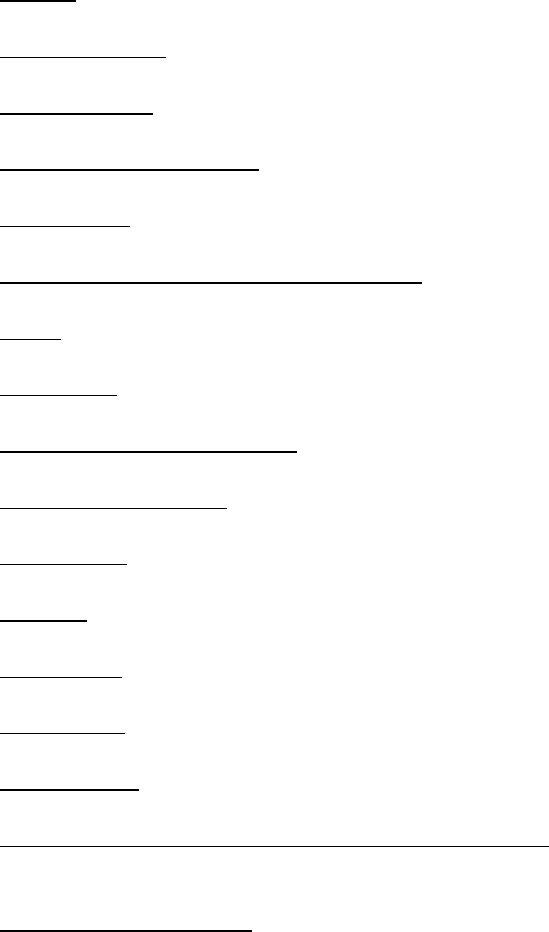
CJCSI 6510.01F
9 February 2011
GL-7 Glossary
PART II – DEFINITIONS
The following terminology is chiefly specialized for information assurance and
computer network defense and is intended for use in this publication and the
activities described herein. Unless indicated by a parenthetic phrase after the
definition that indicates the source publication or document, these terms have
not been standardized for general DOD-wide use and inclusion in the
Department of Defense Dictionary of Military and Associated Terms (JP 1-02).
In some cases, JP 1-02 may have a general DOD-wide definition for a term
used here with a specialized definition for this instruction.
access. See CNSSI No. 4009. (reference e)
access control. See CNSSI No. 4009. (reference e)
accreditation. See CNSSI No. 4009. (reference e)
administrative control. See JP 1-02. (reference d)
application. See CNSSI No. 4009. (reference e)
attack sensing and warning (AS&W). See CNSSI No. 4009. (reference e)
audit. See CNSSI No. 4009. (reference e)
audit trail. See CNSSI No. 4009. (reference e)
authorization (to operate). See CNSSI No. 4009. (reference e)
Authorizing Official
. See CNSSI No. 4009. (reference e)
availability
. See CNSSI No. 4009. (reference e)
backup
. See CNSSI No. 4009. (reference e)
biometrics. See CNSSI No. 4009. (reference e)
Blue Team
. See CNSSI No. 4009. (reference e)
certification. See CNSSI No. 4009. (reference e)
Certified TEMPEST Technical Authority (CTTA)
. See CNSSI No. 4009.
(reference e)
classified information
. See CNSSI No. 4009. (reference e)
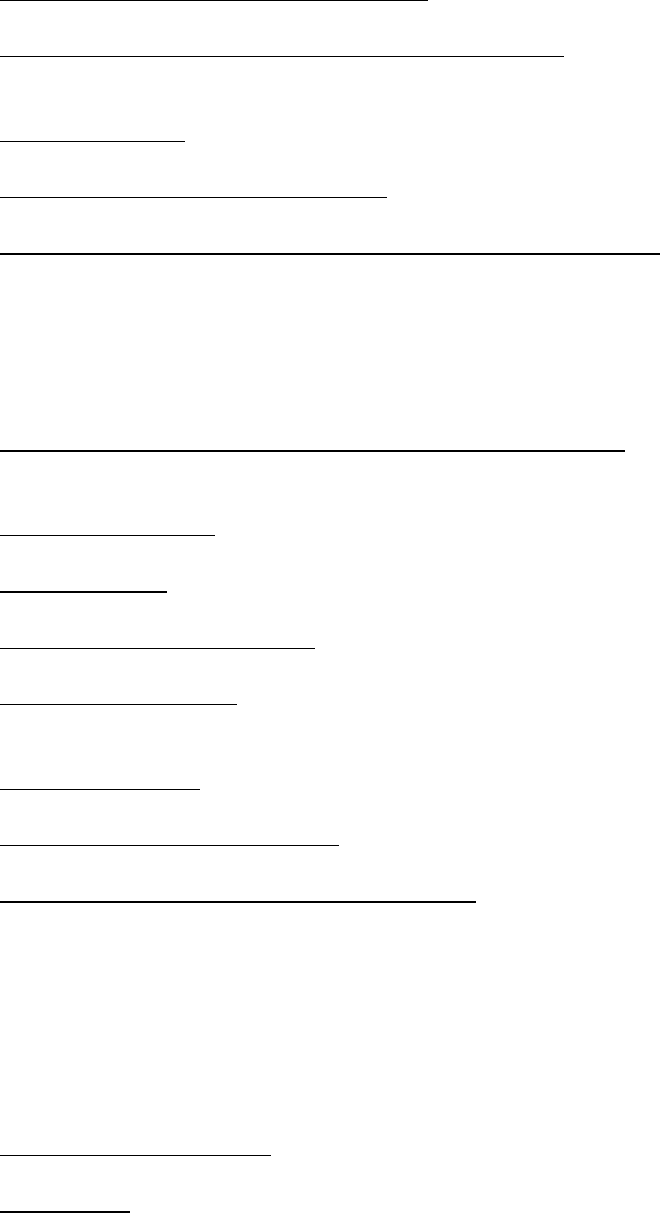
CJCSI 6510.01F
9 February 2011
GL-8 Glossary
communications security (COMSEC). See CNSSI No. 4009. (reference e)
communications security (COMSEC) monitoring. See CNSSI No. 4009.
(reference e)
community risk
. See CNSSI No. 4009. (reference e)
computer network defense (CND)
. See CNSSI No. 4009. (reference e)
computer network defense (CND) response actions (RAs). CND RAs are
deliberate, authorized defensive measures or activities that protect and defend
DOD computer systems and networks under attack or targeted for attack by
adversary computer systems/networks. RAs extend DOD’s layered defense-in-
depth capabilities and increase DOD’s ability to withstand adversary attacks.
(CJCSI 6510.01)
Computer Network Defense Service Provider (CNDSP). See DODI O-8530.2.
(reference h)
COMSEC material. See CNSSI No. 4009. (reference e)
confidentiality. See CNSSI No. 4009. (reference e)
configuration management. See CNSSI No. 4009. (reference e)
connection approval. Formal authorization to interconnect information
systems. (DODD 8500.01E, reference a)
contingency plan
. See CNSSI No. 4009. (reference e)
continuity of operations plan
. See CNSSI No. 4009. (reference e)
controlled unclassified information (CUI)
. A categorical designation that refers
to unclassified information that does not meet the standards for National
Security Classification under Executive Order 12958, but is pertinent to the
national interests of the United States or to the important interests of entities
outside the Federal Government and under law or policy requires protection
from unauthorized disclosure, special handling safeguards, or prescribed limits
on exchange or dissemination. The designation CUI replaces the term
“sensitive but unclassified” (SBU). (DODI 5200.01, reference w)
counterintelligence (CI). See JP 1-02. (reference d)
cyberspace
. See CNSSI No. 4009. (reference e)
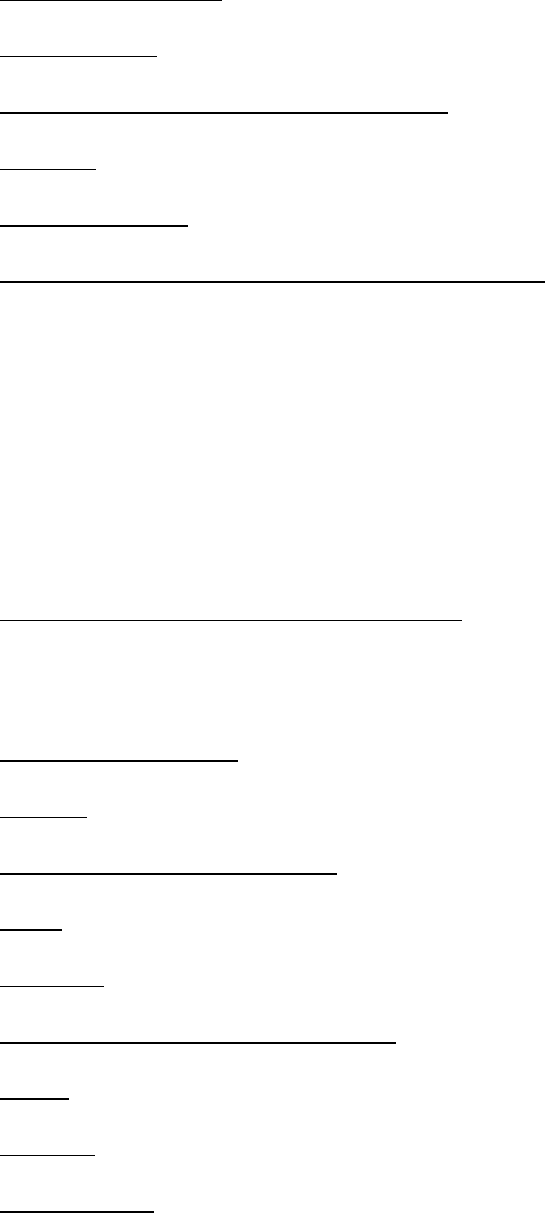
CJCSI 6510.01F
9 February 2011
GL-9 Glossary
security inspection. See CNSSI No. 4009. (reference e)
data integrity. See CNSSI No. 4009. (reference e)
Defense Information Systems Network. See JP 1-02. (reference d)
degauss. See CNSSI No. 4009. (reference e)
denial of service. See CNSSI No. 4009. (reference e)
Department of Defense Information Enterprise. The DOD information
resources, assets, and processes required to achieve an information advantage
and share information across the Department of Defense and with mission
partners. It includes: (a) the information itself and the Department’s
management over the information life cycle; (b) the processes, including risk
management, associated with managing information to accomplish the DOD
mission and functions; (c) activities related to designing, building, populating,
acquiring, managing, operating, protecting, and defending the information
enterprise; and (d) related information resources such as personnel, funds,
equipment, and IT, including national security systems. (DODD 8000.01,
reference uuuuu)
Designated Accrediting Authority (DAA). The official with the authority to
formally assume responsibility for operating a system at an acceptable level of
risk. This term is synonymous with Designated Approval Authority and
Delegated Accrediting Authority. (DODD 8500.01E, reference a)
emanations security. See CNSSI No. 4009. (reference e)
enclave. See CNSSI No. 4009. (reference e)
evaluated products list (EPL)
. See CNSSI No. 4009. (reference e)
event
. See CNSSI No. 4009. (reference e)
firmware
. See CNSSI No. 4009. (reference e)
general support system or system. See CNSSI No. 4009. (reference e)
guard. See CNSSI No. 4009. (reference e)
incident. See CNSSI No. 4009. (reference e)
identification
. See CNSSI No. 4009. (reference e)
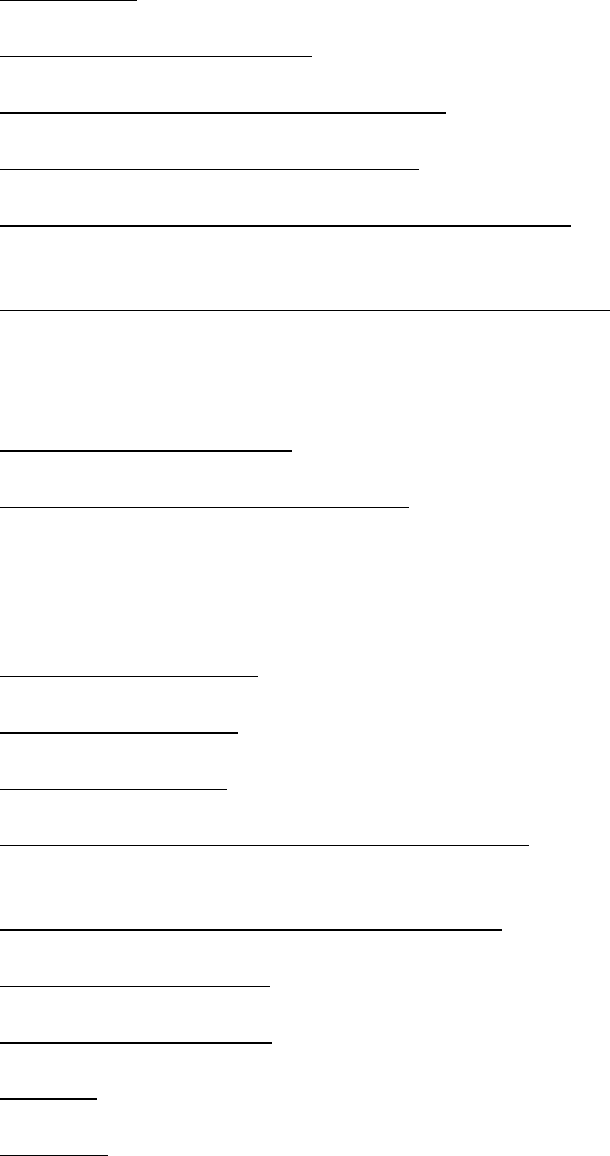
CJCSI 6510.01F
9 February 2011
GL-10 Glossary
information. See CNSSI No. 4009. (reference e)
information assurance (IA). See CNSSI No. 4009. (reference e)
Information Assurance Manager (IAM). See CNSSI No. 4009. (reference e)
Information Assurance Officer (IAO). See CNSSI No. 4009. (reference e)
Information Assurance Vulnerability Alert (IAVA). See CNSSI No. 4009.
(reference e)
Information Assurance Vulnerability Bulletin (IAVB). An IAVB addresses new
vulnerabilities that do not pose an immediate risk to DOD systems, but are
significant enough that noncompliance with the corrective action could escalate
the risk. (CJCSI 6510.01)
information environment. See CNSSI No. 4009. (reference e)
Information Operations Conditions. The INFOCON system provides a
framework within which the Commander USSTRATCOM (CDRUSSTRATCOM),
regional commanders, service chiefs, base/post/camp/station/vessel
commanders, or agency directors can increase the measurable readiness of
their networks to match operational priorities.
information resources. See JP 1-02. (reference d)
information security. See CNSSI No. 4009. (reference e)
information system
. See CNSSI No. 4009. (reference e)
Information System Security Manager (ISSM)
. See CNSSI No. 4009. (reference
e)
Information System Security Officer (ISSO). See CNSSI No. 4009. (reference e)
information technology
. See CNSSI No. 4009. (reference e)
information superiority. See JP 1-02. (reference d)
integrity. See CNSSI No. 4009. (reference e)
intrusion. See CNSSI No. 4009. (reference e)
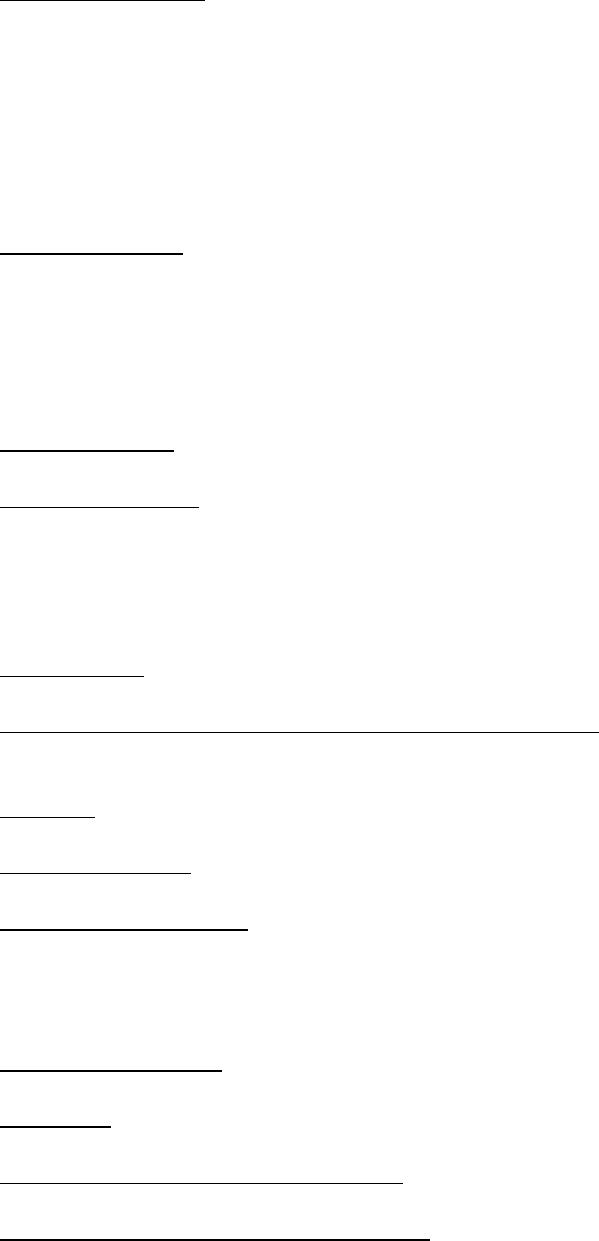
CJCSI 6510.01F
9 February 2011
GL-11 Glossary
major application. An application that requires special attention to security
due to the risk and magnitude of the harm resulting from the loss, misuse, or
unauthorized access to or modification of the information in the application.
Note: All federal applications require some level of protection. Certain
applications, because of the information in them, however, require special
management oversight and should be treated as major. Adequate security for
other applications should be provided by security of the systems in which they
operate. (OMB A-130, reference hhh)
major incidents. Root level intrusion providing unauthorized privileged access
(Category 1), User level intrusion providing non-privileged access (Category 2),
denial of service (Category 4), and new active propagation of malware infecting
a DOD IS or malicious code adversely affecting the operations and/or security
of DOD IS (Category 7) events or incidents affecting Mission Assurance
Category (MAC) I or II DOD ISs. (CJCSI 6510.01)
malicious logic. See CNSSI No. 4009. (reference e)
mission partners. Those with whom the Department of Defense cooperates to
achieve national goals, such as other departments and agencies of the U.S.
Government; state and local governments; allies, coalition members, host
nations and other nations; multinational organizations; non-governmental
organizations; and the private sector. (DODD 8000.01, reference uuuuu)
Mobile Code. See CNSSI No. 4009. (reference e)
National Information Assurance Partnership (NIAP). See CNSSI No. 4009.
(reference e)
network
. See CNSSI No. 4009. (reference e)
non-repudiation
. See CNSSI No. 4009. (reference e)
open source software
. Products that are copyrighted and distributed under a
license that provides everyone with the right to use, modify, and redistribute
the source code of software. (DOD CIO Memorandum, “Clarifying Guidance
Regarding Open Source Software,” reference cccc)
operational control. See JP 1-02. (reference d)
password. See CNSSI No. 4009. (reference e)
personally identifiable information. See CNSSI No. 4009. (reference e)
protected distribution systems (PDS)
. See CNSSI No. 4009. (reference e)
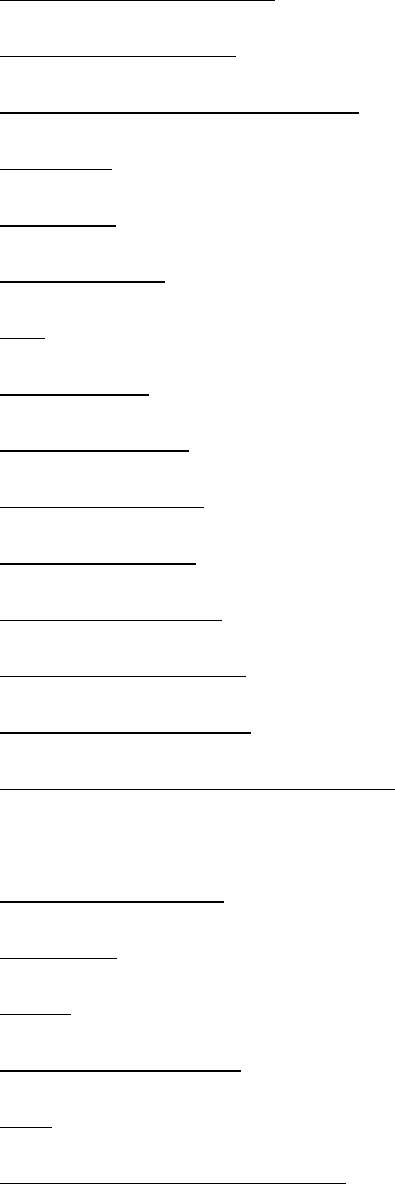
CJCSI 6510.01F
9 February 2011
GL-12 Glossary
public domain software. See CNSSI No. 4009. (reference e)
Public Key Enabling. See CNSSI No. 4009. (reference e)
Public Key Infrastructure (PKI). See CNSSI No. 4009. (reference e)
readiness. See JP 1-02. (reference d)
Red Team. See CNSSI No. 4009. (reference e)
remote access. See CNSSI No. 4009. (reference e)
risk. See CNSSI No. 4009. (reference e)
risk analysis. See CNSSI No. 4009. (reference e)
risk assessment. See CNSSI No. 4009. (reference e)
risk management. See CNSSI No. 4009. (reference e)
security controls. See CNSSI No. 4009. (reference e)
security inspection. See CNSSI No. 4009. (reference e)
sensitive information. See CNSSI No. 4009. (reference e)
system administrator. See CNSSI No. 4009. (reference e)
Tailored Readiness Options (TRO)
. Supplemental measures to respond to
specific intrusion characteristics directed either by CDRUSSTRATCOM or the
responsible regional/local commander. (SD 527-1, reference qqq)
telecommunication. See CNSSI No. 4009. (reference e)
TEMPEST. See CNSSI No. 4009. (reference e)
threat
. See CNSSI No. 4009. (reference e)
unauthorized access. See CNSSI No. 4009. (reference e)
user
. See CNSSI No. 4009. (reference e)
Virtual Private Network (VPN). See CNSSI No. 4009. (reference e)
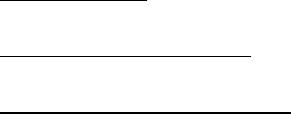
CJCSI 6510.01F
9 February 2011
GL-13 Glossary
vulnerability. See JP 1-02. (reference d)
vulnerability analysis. See CNSSI No. 4009. (reference e)
vulnerability assessment. See CNSSI No. 4009. (reference e)
CJCSI 6510.01F
9 February 2011
GL-14 Glossary
(INTENTIONALLY BLANK)
